
Cost To Live On A Sailboat In The Caribbean

Last Updated by
Daniel Wade
June 15, 2022
So, you've decided that you want to commit to living on your sailboat, and, you've chosen the Caribbean.
Why wouldn't you? It's beautiful, warm, the people are friendly, the food is great, the fishing is top-notch, and their entire way of life is relaxing.
The Caribbean is an awesome place to live, especially if you are lucky enough to do so on your sailboat. There are some things you might want to consider before moving out there, though. Such as, can you afford it? The chances are you could afford a marina slip, at least if you could afford one in America. But is the marina going to be up to the standards you were hoping for? Will you even be able to afford it without working, or with reduced income. Is the Caribbean even the right place for you? This article answers all of that and more!
Table of contents

How much does it cost to live on a sailboat in the Caribbean?
Living in the Caribbean isn't quite as cheap as most people expect it to be. It isn't going to be crazy expensive, at least it doesn't have to be. You can get a pretty nice marina slip in the Caribbean for about $1000 a month. This is going to get you some security, some decent amenities, and a nice location. You could "slum it" and get a far cheaper marina slip near where the locals will dock their boats, but you aren't getting all the added pleasantries and amenities. You might also find yourself quite far out of town. To put that in perspective, a year's worth of accommodation in the Caribbean will only cost you about $12k. Far less than rent might be, and certainly far less than organizing some sort of vacation accommodation. If you choose to live in one of the smaller, for lack of a better word poorer, island nations you will find that your money goes a lot further. You could rent a luxury marina slip for just a few hundred dollars a month. The Dominican Republic is a good example of this.
You must also consider how you are going to be paying tax when you are living here. If you are only technically visiting (just a few months) and are still technically living in the US, you can avoid paying income tax in your host nation. This isn't ethically or legally wrong so long as you do only stay a few months here and a few months there. If you plan to pick one country and live there long term, make sure you register with the country. It is easiest to do this before you go but can be done locally in most cases. If you are unsure what to do, you can always give the American consulate a call. They should be able to help you out. Maintenance is also something that many people fail to consider fully before making the move.
When you move to a new country you need to find a new everything. A new doctor, dentist, mechanic, grocery store, gym, etc. This is part of the fun of moving, at least it is for most people. The problem is when you move somewhere new with a sailboat you must immediately find a good boat repair yard and storage dock. These costs vary from island to island, of course. But you will find it is generally cheaper than the US. Don't be thrown off by low prices when looking at repairs. Labor is much cheaper here. Use your gut instinct when deciding if a boat repairman seems legit. Storage is also something you will need to consider, especially if you plan on going on vacation without the boat. And, perhaps the rainy season if you plan on sticking around. A good storage facility will be about $10-$15 per foot. Much less than you might be paying in the states. (perhaps about $40 per foot).
The cost of living should drop pretty drastically. Food, liquor, and basic amenities will be far cheaper than you have likely ever seen before. But, some of the brand names "luxury" items that you may not want to live without might end up costing you an arm and a leg. Do you want Lucky Charms for breakfast? Because there is a good chance they won't have them. And if they do, they'll fleece you for as much as they can. This is how any country operates with products a select few people want and are also hard to come by. If you are a flexible person, making this adjustment shouldn't be too hard. Who knows, perhaps you'll find a new favorite!
Why would you want to live on a sailboat?
There are lots of great reasons to live on a sailboat in the Caribbean. It allows you to sail around and go where you please. The island nations of the Caribbean are all spectacularly beautiful and pretty relaxed when it comes to immigration. You will be changing countries whenever you arrive at a new island (usually), but many won't even ask for a passport on arrival. You should have one, of course. But it is nice that you can take it easy. Living on your sailboat can also give you the peacefulness and quiet you are very likely seeking. You can drop anchor anywhere you like, in any of the calmer water at least, and just relax and unwind. Living on your boat also gives you the adventure so many of us crave. Being able to explore those historic islands, following the routes of long sunken trade ships from pre-industrial Europe. What an opportunity. Something very few people can do.
Why would you want to live in the Caribbean?
There are so many great reasons for living in the Caribbean. If you have never been, the way of life can be a little hard to describe. It is a unique pace of life. People there value things differently. I think it is fair to say that they are generally more relaxed and welcoming to outsiders than most other countries. In part, because they are inherently friendly people. And also, because such a large amount of many of the island's income is reliant on tourists. Being friendly, and being safe, is of paramount importance. That's why the islands are such a great place to live. Or vacation. When you are living there, the two almost blend into one.
The Caribbean is also incredibly diverse. So many countries bustled up together with tourists from the world over has created a true cultural melting pot. If you want a chance to meet people from all over the world, this is the place to do it. Plus, you likely won't see them again. At least not often. The benefit of making friends with tourists, they are very casual relationships. This can be good or bad depending on your perspective. This also means there are endless places to eat, cuisines to try, and cocktails to sample. The islands try to accommodate everyone, this is aimed at tourists of course, but you can take advantage of it all the same.
The Caribbean is also quite reasonably priced. Everything that isn't aimed at tourists is priced for the locals, meaning it is pretty cheap. This doesn't help you with the luxury items, but the everyday essentials you are good to go. Having a good job and moving to an area where your dollars stretch further is a good way to either save money or live a life that was normally out of your means. That choice would be up to you - if it were me though, I would go for the extra savings. Maybe put that extra money towards some luxuries on the boat. Like a TV and a SatPhone or a satellite internet router.
What are some things you should know about sailing in the Caribbean?
The Caribbean is a great place to sail. The waters are normally pretty calm, the conditions are generally good, and the maritime laws are relaxed enough that you can feel at ease but strict enough that it isn't total mayhem. One thing to consider is the depth of your hull. You see, the Caribbean waters are rather shallow. At least close to the mainland. The waters are shallow and the sea bed is made of sharp shale. The chance of you scuppering yourself is quite high. This is why so many ships swap out their fin keels for a torpedo-shaped one. Or, they simply cut half of the fin off. Learning to navigate shallow waters is a good idea before you arrive. That and having a decent depth finder onboard.
You will also want to be wary of the rainy season. That is May to October for most places. The rain itself isn't a problem, so long as you don't mind being confined to your ship for a short while. The real problem is the storms. Cyclones are not uncommon. They arrive multiple times during the rainy season. If you have lived on the east coast of America, you are likely used to getting cyclones to blow in from far out at sea. Well, most of those storms make landfall in the Caribbean first. Meaning what you have seen in America is only a taste of what's to come. This is fine if you live on the island. Storm shutters, a fully stocked pantry, and a backup generator are enough to see you through the worst of it. On your sailboat though, you are at serious risk of capsizing. You may want to find a friend who will allow you to wait out the storm in their home. Or book yourself into a hotel. That will save you, but your ship is at the mercy of the storm.
Tips for sustaining yourself while living/working in the Caribbean
If you are planning on living in the Caribbean, the best advice would be to secure a remote working job (or jobs) before you go. Wages on the islands reflect the general economy. They are poor paying, to say the least. Unless you can get a high up job at one of the hotels or one of the few business firms. If you plan on moving around, from island to island, the best idea is to start your own business that can be run from home. One that doesn't need a physical presence, just a wifi connection. Having a hefty savings account before you go is the best way to ensure you have some breathing room. If you are lucky enough to have already retired, well your pension check should be enough to cover you. And then some!
Conclusion:
Hopefully, this article has given you a good idea about how much it can cost living in the Caribbean. And, how feasible living there truly is. If you don't have a source of income pre-planned you aren't ready to move. Having a nice savings account and at least $1000 a month to spend on the marina slip is a good starting point. The scale of value in the Caribbean is pretty great. Meaning, a $1000 marina in the Caribbean will be amazing. A $2000 one will be out of this world. You will get far more for your money than you would in most places in the US. If you are looking to cut costs, bring some good fishing rods with you. The fishing in the Caribbean is phenomenal. You'll have a blast. Good luck with the move, make sure you are fully prepared financially before you set sail. And remember - Don't forget your passport!
Related Articles
I've personally had thousands of questions about sailing and sailboats over the years. As I learn and experience sailing, and the community, I share the answers that work and make sense to me, here on Life of Sailing.
by this author
Destinations
Financial and Budgeting
Most Recent

What Does "Sailing By The Lee" Mean?
October 3, 2023

The Best Sailing Schools And Programs: Reviews & Ratings
September 26, 2023
Important Legal Info
Lifeofsailing.com is a participant in the Amazon Services LLC Associates Program, an affiliate advertising program designed to provide a means for sites to earn advertising fees by advertising and linking to Amazon. This site also participates in other affiliate programs and is compensated for referring traffic and business to these companies.
Similar Posts

Best Bluewater Sailboats Under $50K
December 28, 2023

How To Choose The Right Sailing Instructor
August 16, 2023

Best Sailing Destinations In BC
June 28, 2023
Popular Posts

Best Liveaboard Catamaran Sailboats

Can a Novice Sail Around the World?
Elizabeth O'Malley

4 Best Electric Outboard Motors

How Long Did It Take The Vikings To Sail To England?

10 Best Sailboat Brands (And Why)
December 20, 2023

7 Best Places To Liveaboard A Sailboat
Get the best sailing content.
Top Rated Posts
Lifeofsailing.com is a participant in the Amazon Services LLC Associates Program, an affiliate advertising program designed to provide a means for sites to earn advertising fees by advertising and linking to Amazon. This site also participates in other affiliate programs and is compensated for referring traffic and business to these companies. (866) 342-SAIL
© 2024 Life of Sailing Email: [email protected] Address: 11816 Inwood Rd #3024 Dallas, TX 75244 Disclaimer Privacy Policy

Living On A Sailboat In The Caribbean
In my years of sailing, I’ve had the opportunity to live on a sailboat in some of the most beautiful places on earth – including the Caribbean.
There’s something special about living on a boat in this part of the world. Maybe it’s the turquoise waters, the white sand beaches, or the friendly locals. Whatever it is, I can’t get enough of it!
If you’re thinking about making the jump to liveaboard life in the Caribbean, here’s what you need to know…
How Much Does It Cost To Live On A Sailboat In The Caribbean?
What does it cost to live on a sailboat in the Caribbean? It’s a question I get asked a lot, and it’s not an easy one to answer. There are so many variables, from the size and type of boat you live on, to the location you choose, to the lifestyle you lead.
That said, I can give you some ballpark figures based on my own experience living on a sailboat in the Caribbean for over 10 years. Keep in mind that these are just estimates, and your own costs may be higher or lower depending on your situation.
The biggest variable in the cost of living on a sailboat is the boat itself. If you own a boat, you’ll have to factor in the cost of maintaining and repairing it. If you’re chartering, you’ll need to budget for the cost of the charter itself.
Assuming you have a boat and are living on it full-time, your other major costs will be food and fuel. Food costs will vary depending on how much you eat out, and whether you buy fresh or canned goods. Fuel costs will depend on how much you use your engine, and whether you use propane or diesel.
Other costs to consider include insurance, docking fees, and repairs.
Insurance is a must if you’re living on a sailboat in the Caribbean. Docking fees will vary depending on the marina you choose, and repairs can be expensive if you’re not handy with a wrench.
All told, you can expect to spend around $2000 per month if you’re living on a sailboat in the Caribbean. This is just a rough estimate, and your actual costs will vary depending on your situation.
Cost Of Living On A Sailboat In The Caribbean
Sailboats are often associated with luxury and a carefree lifestyle. But what is the cost of living on a sailboat in the Caribbean really like?
I spoke with Gary Jobson, world-renowned sailor and sailing analyst, about the cost of living on a sailboat in the Caribbean. Here’s what he had to say:
“The cost of living on a sailboat in the Caribbean can vary greatly depending on the size of the boat and the lifestyle you want to live. A small boat with a few creature comforts will cost less than a larger boat with all the bells and whistles. And, of course, your lifestyle will also dictate your costs.
“If you want to live a simple life, you can do so quite cheaply. But if you want to live a more luxurious lifestyle, it will cost more. It really all comes down to your personal preferences.”
So, there you have it! The cost of living on a sailboat in the Caribbean can vary greatly depending on your lifestyle and the size of your boat. But no matter what your budget is, you can find a way to enjoy the sailing lifestyle in the Caribbean.
Maintaining Your Boat
Assuming you have the boat in the water, you now have to maintain it. This includes painting the bottom, varnishing the bright work, replacing the zincs on the hull, and caring for the sails and canvas. You also have to keep the boat clean and free of mildew.
In the tropics, this is a full-time job. You have to wash the boat every day with fresh water to keep the salt from eating into the paint and gelcoat. You also have to make sure the bilges are dry and free of any stagnant water.
Marina or Mooring Costs
The cost of living on a sailboat in the Caribbean can be quite expensive, especially when it comes to Marina or Mooring fees. In some cases, these fees can be as high as $600 per month!
However, there are a few ways to help offset these costs. One way is to live aboard your boat at a marina that offers discounts for live-aboards. Another way is to join a sailing club which often have their own moorings or docks.
Of course, the best way to offset these costs is to simply sail your boat to a less expensive location. In many cases, you can find moorings for as little as $100 per month in the Caribbean.
So, if you’re looking to save money on your sailing lifestyle, be sure to keep an eye on your Marina or Mooring fees. With a little planning, you can easily offset these costs and keep your budget in check.
Food And Supplies
What does it cost to live on a sailboat in the Caribbean? It’s cheaper than you might think!
Here are some tips on food and supplies:
- Shop around for the best prices on food and supplies.
- Buy in bulk when possible.
- Use coupons and discounts.
- Shop at local markets for fresh produce.
- Plan your meals ahead of time to save money.
With a little planning and effort, you can save money on food and supplies and enjoy a great lifestyle in the Caribbean!
What are the little luxuries that make living on a sailboat in the Caribbean so enjoyable? It could be the sound of the waves lapping against the hull of your boat at night, or the warmth of the sun on your face during the day.
Maybe it’s the feeling of being surrounded by natural beauty, or the sense of freedom that comes with being on the open sea.
Whatever it is that makes living on a sailboat in the Caribbean special, there’s no doubt that it comes at a cost. But for those who are willing to trade in the comforts of land for the adventure of a lifetime, the cost is well worth it.
Gas And Water
The cost of living on a sailboat in the Caribbean can be expensive, but it doesn’t have to be. One of the biggest expenses is gas and water.
Here are a few tips to help you save money on gas and water:
- Use a water maker. A water maker will save you money on water by turning seawater into fresh water.
- Use a holding tank. A holding tank will save you money on water by storing water that you don’t use right away.
- Use a gas saver. A gas saver will save you money on gas by reducing the amount of fuel you use.
- Use a wind generator. A wind generator will save you money on gas by generating electricity from the wind.
- Use a solar panel. A solar panel will save you money on gas by generating electricity from the sun.
Can You Live On A Sailboat?
Sure, you can live on a sailboat in the Caribbean. But is it really living? I mean, you’re constantly having to worry about the weather, you’re always fixing something on the boat, and you’re never really sure where you’re going to be from one day to the next.

Don’t get me wrong, I love sailing. It’s one of the most freeing and exhilarating experiences you can have. But it’s not for everyone. Some people just can’t handle the constant uncertainty and the lack of creature comforts.
So, if you’re thinking about living on a sailboat in the Caribbean, ask yourself this: can you handle being constantly on the move, always having to be prepared for the worst, and never really knowing what’s going to happen next? If you can, then go for it. It’s an experience you’ll never forget.
You May Learn To Sleep Lightly
You may learn to sleep lightly on a sailboat. The gentle rocking of the boat can lull you to sleep and the fresh air can help you to sleep soundly.
However, you may also find yourself wakeful in the middle of the night, listening to the creaking of the boat and the sound of the waves.
If you are wakeful, you may want to take a look around the boat to make sure everything is secure, or simply enjoy the peacefulness of the night.
How Do You Feel About The Heat?
The heat can be intense when sailing in the tropics. I once sailed from Antigua to St. Lucia in the middle of August. The temperature was in the low 90s with high humidity.
I was constantly wet from sweating and the boat was like an oven. I don’t mind the heat, but I know some sailors who do. They prefer to sail in cooler weather.
How Much Space Do You Need?
You might be surprised how little space you actually need to live on a sailboat. Of course, it depends on the size of the boat and how many people are living on it. But even a small sailboat can comfortably accommodate two people.
Of course, you won’t have the same amount of space as you would in a house or apartment. But that doesn’t mean you can’t live a comfortable life on a sailboat. There are plenty of people who do it successfully.
So, how much space do you need? It really depends on your lifestyle and what you’re used to. If you’re used to living in a small space, then you’ll probably be just fine living on a sailboat. But if you’re used to a more spacious lifestyle, then you might find it a bit more challenging.
Ultimately, it’s up to you to decide how much space you need. But don’t let the size of the boat deter you from living your dream. There are plenty of people who have done it successfully.
Why would you want to live on a sailboat?
Sailing is one of the most freeing and exhilarating experiences you can have. And what could be more freeing and exhilarating than living on a sailboat?
Sailboats are relatively inexpensive to maintain and operate. They offer a level of freedom and flexibility that other types of boats simply cannot match.
Plus, living on a sailboat in the Caribbean is about as close to paradise as you can get. The weather is perfect, the scenery is beautiful, and the people are friendly. What more could you ask for?
Why would you want to live in the Caribbean?
The Caribbean is a great place to live for a number of reasons. First, the weather is amazing. You can expect sunny skies and warm temperatures year-round.
Second, the Caribbean is a great place to relax and enjoy life. There are plenty of beaches to lounge on, and the laid-back lifestyle is perfect for those who want to escape the hustle and bustle of city life.
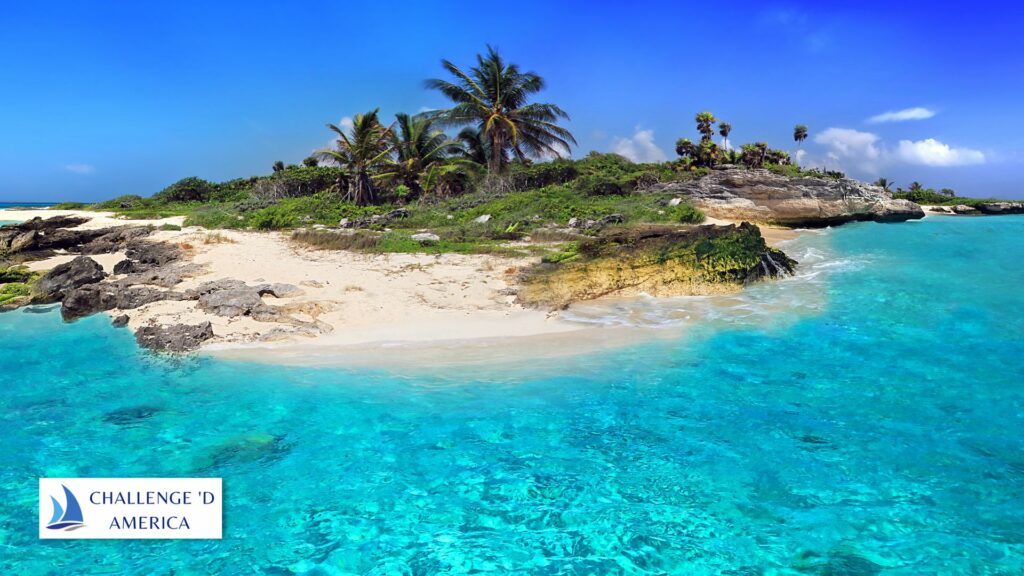
Third, the Caribbean is a great place to sail. The trade winds make for perfect sailing conditions, and there are plenty of islands to explore.
And fourth, the people in the Caribbean are some of the friendliest you will ever meet. They are always ready to help out and make you feel welcome.
So, if you are looking for a place to call home, the Caribbean is a great option. It has everything you need to live a happy and healthy life.
What Are Some Things You Should Know About Sailing In The Caribbean?
- The Caribbean is a great place to sail, with warm weather and beautiful scenery.
- There are many different islands to explore, each with its own culture and attractions.
- The sailing conditions can be challenging, with strong winds and currents.
- There are also hurricanes and tropical storms to be aware of.
- But overall, sailing in the Caribbean is an unforgettable experience.
Tips For Sustaining Yourself While Living/Working In The Caribbean
1. Find a balance between work and play: It’s easy to get caught up in the non-stop party atmosphere of the Caribbean, but it’s important to find a balance between work and play. Make sure to schedule some time each day to relax and enjoy the beautiful surroundings.
2. Get involved in the local community: One of the best ways to sustain yourself while living in the Caribbean is to get involved in the local community. There are many ways to do this, whether it’s volunteering, joining a local sports team, or simply getting to know your neighbors.
3. Be prepared for the unexpected: The Caribbean is known for its laid-back lifestyle, but that doesn’t mean that everything will always go according to plan. Be prepared for the occasional power outage or unexpected delay.
4. Learn to relax: One of the most important things to remember while living in the Caribbean is to relax. This is a different way of life, and it’s important to go with the flow. Don’t sweat the small stuff and enjoy the simple pleasures of life.
Is Living On A Sailboat Worth It?
Yes, living on a sailboat can be an incredibly rewarding experience. It allows you to live a lifestyle that is far removed from the hustle and bustle of everyday life on land.
You get to experience the beauty of the Caribbean islands and their people firsthand. And, of course, sailing is an amazing way to see the world.
Of course, there are also some challenges that come with living on a sailboat. It can be difficult to find safe anchorages and good weather can be hard to come by at times. But, overall, I think the pros outweigh the cons and living on a sailboat is definitely worth it.
How big of a sailboat do I need to live on?
Assuming you have no experience living on a boat, you’ll need a minimum of a 35-40 footer. This size will give you some room to move around and store things. If you plan to live on your boat long-term, you might want to consider a larger boat.
Do You Pay Taxes If You Live On A Boat?
The answer to this question depends on the country in which you reside. If you live in the United States, you are required to pay taxes on your income, regardless of whether it is earned on land or at sea.
However, if you live in a country with more relaxed tax laws, such as the Bahamas, you may not be required to pay taxes on your income from sailing.
What Are Disadvantages Of Sailing?
- Sailing can be dangerous.
- The weather can be unpredictable and severe storms can occur without warning.
- Sailing can be expensive, especially if you own your own boat.
- Sailing takes time and effort to learn how to do it properly.
- You need to be physically fit to sail, as it can be demanding on your body.
Is Sailing An Expensive Hobby?
No, sailing is not an expensive hobby. In fact, it can be quite affordable. There are many ways to sail without spending a lot of money.
You can sail on a smaller boat, or you can charter a boat for a week or two. You can also join a sailing club, which will give you access to boats at a fraction of the cost of owning one.
Conclusion On Living On A Sailboat In The Caribbean
Living on a sailboat in the Caribbean is an amazing experience that I would recommend to anyone. The scenery is breathtaking, the people are friendly, and the sailing is some of the best in the world.
There are, of course, some challenges to living on a boat, but overall it is an incredibly rewarding experience. I’m so grateful to have had the opportunity to live on a sailboat in the Caribbean and I hope to do it again someday soon.
Similar Posts

How To Remove Stains From Fiberglass Boat
It’s no secret that fiberglass boats are susceptible to stains. But with a little elbow grease and the right cleaning supplies, you can get your boat looking like new again. In this article, we’ll show you how to remove stains from fiberglass boats, including those pesky coffee stains. How Do I Remove Stains From My…

Is It Cheap To Live On a Sailboat?
Living on a sailboat can be an incredibly thrilling and cost-effective lifestyle. With the right knowledge, budget planning, and sailing skills, it’s possible to enjoy an adventurous life on the open water without breaking the bank. Let’s look at how to make this dream a reality. What Kind of Sailboat Should You Buy? The size,…
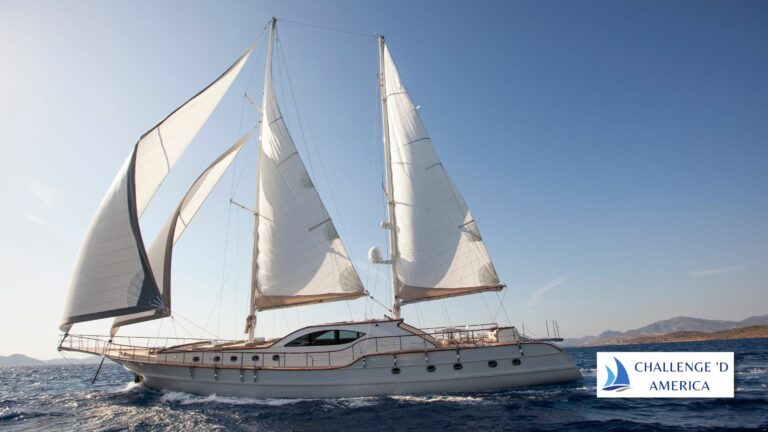
Facts About Sailboats
The sailboat is one of the most popular and enduring types of vessel ever created. Whether you’re an experienced sailor or you’ve never set foot on a boat in your life, there’s something about a sailboat that just inspires awe. In this article, we’re going to explore 10 amazing facts about sailboats that you may…

How Do You Properly Use A Cam Cleat To Trim The Sails On A Sailboat?
As a sailing expert, I’m often asked how to properly use a cam cleat to trim the sails on a sailboat. It’s a critical skill for all sailors to learn, as proper trimming of the sails affects the performance of the vessel, and can mean the difference between winning a race or coming in last….

What Size Sailboat Is Best For Solo Sailing?
Solo sailing is an adventure that requires preparation, practice and skill, but the right sized sailboat can make it much more enjoyable and safer for the sailor. For those looking to take on the challenge of sailing solo, the ideal size boat to choose lies between 35 and 45 feet in length. This size boat…

How Much Does It Cost To Own A Sailboat
How much does it cost to own a sailboat? This is a question I get asked a lot, and the answer, like most things in sailing, is “”it depends.”” There are a lot of variables to consider when trying to calculate the costs of owning a sailboat, including the size and type of boat, where…
Leave a Reply Cancel reply
Your email address will not be published. Required fields are marked *
Save my name, email, and website in this browser for the next time I comment.
RetireFearless
Cost To Live On A Sailboat In The Caribbean
The Caribbean is a great place to sail to and just forget about all your worries. But how much does it cost to live on a sailboat in the Caribbean?

March 16, 2023
This article may contain affiliate links where we earn a commission from qualifying purchases.
The Caribbean is a great place to sail to and just forget about all your worries. But how much does it cost to live on a sailboat in the Caribbean?
Living on a sailboat in the Caribbean will cost you about $2,500 per month if you exclude the cost of buying a boat, which is around $25,000. You might have to get a marina slip for around $800 a month. Other expenses include taxes, food items, and water and gas bills.
Living on a boat is pretty much like living in a flat. Like an apartment, you'll most likely be investing in your boat's financing, taxes, maintenance, and essentials. We've created this detailed guide to help you determine how much it will cost to live on a sailboat in the Caribbean.
As people who have lived on sailboats for extended periods, we know exactly how much it costs. We'll share these insights with you to help you decide whether you're up for the adventure or whether the expenses are too much to bear.
Table of Contents
How Much Does it Cost to Live on a Sailboat in the Caribbean?
Getting a marina slip.
Living in the Caribbean isn't quite as expensive as most people think. A decent marina spot in the Caribbean may be acquired for around $800 per month . This way, you get access to security, good facilities, as well as a convenient place to stay.
You could bring it down and get a marina slip near where residents will dock their yachts for less money; however, you won't get all the other perks and conveniences. It's also possible that you'll end up outside of town. To put that into perspective, if you stay a year in the Caribbean, you'll be paying $12,000 for the marina slip. It's less expensive than paying rent every month (especially if you live in a nice area), and it's a lot cheaper than planning a vacation.
You will discover that you can stretch your budget a lot farther if you opt to live in a few of the smaller, underdeveloped island countries. In this case, a luxurious marina spot can be rented for a few hundred dollars per month.
Obtaining a Boat
A live-abroad sailboat that can navigate the Caribbean will cost at least $20,000 to $25,000 . If you want a more luxurious cruiser, be prepared to pay anywhere from $30,000 to $90,000. This is one of the most significant expenses you'll be required to make for your Caribbean journey.
You also have an option to charter a sailboat for much less money. However, it won't give you a lot in the way of customization.
Maintenance of the Boat
So you've bought your boat – great! Now, you have to think about how much you're going to pay to maintain it. You'll pay anywhere from a few hundred to a few thousand dollars per year on servicing your sailboat, depending on its size. If you're navigating in the Caribbean, you'll need a mid-size sailboat, which will be at least 30 to 40 ft. long.
Most sailors prefer larger boats. If you've never sailed on open water before, you'll want to get the biggest and most robust boat possible. Managing such a boat will certainly cost you several thousand dollars per year. If you live aboard your boat all the time, you'll need to change the sails every few years because they'll wear out with excessive use. The cost of new sails is, again, thousands of dollars.
Paying Your Taxes
It would be best if you also thought about how you'll pay taxes while you're in the Caribbean. You don't need to pay income tax in your host country if you're just visiting there for a couple of months and still nominally residing in the U.S. This isn't unethical or illegal if you're only staying a few months in between. However, if you're looking to live in one particular country for a long time, make sure you get registered with that country's government.
You should have all this sorted out before you depart; however, you can also do it once you reach your destination – or even online. You could always contact the American consulate if you're not sure how to do it. They should be able to assist you.
Food and Other Supplies
Living on a boat is like living in a tiny home without the availability of a store in many respects. You'll need to stockpile enough food to last at least a month at a time. Because buying supplies in the Caribbean can be costly, many sailors want to take sufficient bottled and canned meals for their whole Caribbean journey when they depart the United States.
Estimate how much you're currently spending on these food types, eliminate many other fresh items, and calculate how much you'd spend on a menu that's mostly made up of meals that can be preserved for a long time because that is what you will need in the Caribbean.
If you really want to enjoy fine cuisine, a plunge into a refreshing pool now and then, and other pleasures, you will have to pay significantly more.
Marinas that appeal to the affluent and luxury yacht locations will charge a premium for all of their facilities. Decide on the type of lifestyle you intend to live in the Caribbean. To enjoy the luxuries, make sure you have the extra funds required to afford them; otherwise, they will affect your budget and might make it difficult for you to manage the necessities.
Water and Gas
When you visit a marina every few months throughout your Caribbean voyage, you'll need to fill up on groceries as well as water and gas.
These expenditures might add up quickly based on how often you use your engine and how much clean water you consume. Water can be pricey in some regions of the Caribbean, so it is important to keep that in mind.
Cost Breakdown
Some reasons to live on a sailboat in the caribbean.
Living on a sailboat in the Caribbean has several advantages. First, it gives you the freedom to cruise about and go wherever you choose. The Caribbean Islands are all staggeringly beautiful, and immigration laws aren't too stringent. When you arrive on a floating island, you will be switching countries; however, many will not require a passport upon arrival, making it quite efficient and easy.
Staying on your sailboat might also provide you with the solitude and serenity you're looking for. You can drop anchor wherever you want, preferably in calmer waters, and simply relax and unwind. Furthermore, staying on your boat provides you with the adventure that so many of us seek.
Exploring those historical islands while following the itineraries of long sunken commerce ships from pre-industrial Europe is a once-in-a-lifetime experience. Lastly, the Caribbean offers a wide range of experiences. The presence of so many nations and tourists from all over the globe has resulted in a genuine multicultural nation. This is the spot to go if you want to meet folks from all around the world from the comfort of your sailboat.
This also implies a plethora of restaurants to visit and beverages to try. The islands attempt to satisfy everyone.
Tips to Reduce the Cost of Living on a Boat in the Caribbean
Based on where you're from, staying on a sailboat in the Caribbean can be costing big bucks every month. However, there are a few cost-cutting options available as well.
Keep the Engine Off
If you don't sail around too much, you'll cut down on the amount of money you spend on gas and prolong the life of your engine. Relax and enjoy your Caribbean holiday by waiting for the wind to blow in the location you would like to go to. Also, make sure to change the oil on time as it would affect the amount of fuel consumed by your vessel.
Find Your Own Food
The Caribbean is home to some of the world's most abundant edible seafood. You can catch a wide variety of tasty fish and seafood. Look into fishing licenses and make sure you're obeying the rules in your area. Using your own catch as a source of food might help you save a lot of money.
After preparing a few healthy meals, you may discover that you aren't as concerned with having lavish dinners. You can also consider purchasing fresh fish directly from local fishers as it might save you a great deal of money compared to going to the store.
Make Full Use of the Marina – but Don't Stay for Too Long
Marinas are popular among sailors for a variety of reasons. Numerous people, cafes, and bars are available as well as housing. You can get off your boat onto dry ground whenever you choose to stay at a marina. You can also have a good time without having to worry about your boat dragging.
It's wonderful to treat yourself to a marina occasionally, but if you need to save cash on your Caribbean vacation, you should not stay at a marina for too long. Do some research to find the most affordable marinas at your preferred destination. Also, only stay there occasionally. This allows you to save some money on your trip.
Recent Articles

What Size Sailboat Can One Person Handle?

How To Tie A Sailboat To A Mooring Ball Ring

What Is The Ideal Wind Speed When Sailing?

How To Use a Sailboat Winch

Things You Need To Liveaboard a Sailboat

Types of Sailboat Keels
I'm Michael Moris. I've been sailing my whole life, and it has taken me to places I never imagined. From the Caribbean to Europe, from New Zealand to South America - there's nowhere that hasn't felt like home when you're on a boat!

Trending Articles

How Far Is Havana From Miami By Boat?

Yachting Vs Sailing

Who Is Sailing Doodles?
Subscribe To Our Newsletter
Thank you! You're signed up for our free newsletter!
Oops! Something went wrong while submitting the form
About Our Team
We are a publishing team of licensed Nursing Home Administrators, Nurses, Assisted Living Directors, Health Professionals, Gardeners, and individuals with vast experience with senior living and activities.

©2024 Retire Fearless. All rights reserved.
We can be reached via email at [email protected]
Retirefearless.com is a participant in the Amazon Services LLC Associates Program, an affiliate advertising program designed to provide a means for sites to earn advertising fees by advertising and linking to Amazon. This site also participates in other affiliate programs such as CJ, ClickBank and more, and is compensated for referring traffic and business to these companies.
Facebook Pinterest
- Skip to main content
- Keyboard shortcuts for audio player
I'm Really Into
My wife and i quit our jobs to sail the caribbean.
Scott Neuman

Author Scott Neuman's sailboat, Symbiosis, on passage between St. Lucia and Martinique in 2017. Debbie Daigle hide caption
Author Scott Neuman's sailboat, Symbiosis, on passage between St. Lucia and Martinique in 2017.
There's another universe not far from land.
It is devoid of buildings, trees, cars, cellphones and the internet. Seemingly limitless water extends uninterrupted in all directions.
You don't have to travel a great distance to discover this other cosmos. At 10 miles offshore, you're already there. At 100 miles, on a course away from shipping lanes (about a full day's sail in a small boat), the effect is complete: Civilization recedes, along with any sign of humanity.
It's the closest most of us will ever come to the isolation of outer space. And it is why I'm really into sailing.

Finding (and losing) yourself backcountry snowboarding
I grew up around boats. My father liked to build them. The pride of his flotilla was not a sailboat but a small "power cruiser," Talisman, that he designed and built before I was born. My older sister and I were bundled into a car nearly every summer weekend until my late teens to make the trip from northeast Indiana to the south shore of Lake Erie in Ohio, where Talisman waited patiently through the week, tugging gently at the dock lines.
I was always more intrigued, though, by wind-driven vessels than any relying primarily on mechanical propulsion. As a kid, I devoured the adventures of Robin Lee Graham, the teenage solo circumnavigator, in the pages of National Geographic and, later, in Graham's book, Dove . However, it wasn't until about 20 years ago, well into my adulthood, that I took up sailing in a serious way.

Scott Neuman near Martinique in 2017. That island's famous Diamond Rock can be seen in the background. Wassana Laisukang hide caption
Scott Neuman near Martinique in 2017. That island's famous Diamond Rock can be seen in the background.
I quickly learned (and am still mastering) the art and physics of "trimming" the sails, which often involves tiny adjustments yielding minute gains in speed that nonetheless can save hours or even days over longer passages.
I've made voyages in fair weather and foul, on my own boats and those of friends, and ranging from nearshore day sails to blue-water passages.
Eventually, I became a U.S. Coast Guard-licensed captain.
Still, I've made plenty of mistakes. While living in Asia, a sailing buddy and I set off across the South China Sea destined for Thailand, only to be slammed by a late-season typhoon that forced us to make landfall in Vietnam, shaken, without a mast and glad to be alive.

Roller skating feels a lot like love, and falling is just part of the process
Along the way, however, I also learned the essentials — navigation and how to maintain a cruising boat's complex systems, such as rigging, electrics, plumbing and, yes, engine.
Years later, my wife and I lived aboard our 37-foot cutter, Symbiosis, while we saved enough to take a two-year sabbatical from our jobs to journey down the U.S. Atlantic coast and through the Bahamas and the Caribbean. We visited many places that never see cruise ships or airplanes and that are nearly impossible to reach any way other than at the helm of a small boat.
Far from shore, it is the sole responsibility of the skipper and crew to keep the water out, the people in, the boat on course and everything working. The corollary of self-reliance makes the isolation that much more splendid.

Neuman's boat, Symbiosis (center, background), in an anchorage in Luperón, Dominican Republic, in 2016. Lukáš Homola hide caption
Neuman's boat, Symbiosis (center, background), in an anchorage in Luperón, Dominican Republic, in 2016.
As much as that appeals to me, so does the company of fellow cruising sailors. We remain close to many we met in our travels, particularly in the Caribbean, and to many who helped us along the way and whom we, in turn, helped too. Regardless of our backgrounds, we understand the same triumphs and perils and share many common experiences — the perfect sail, the rough passage, the close call with a rocky shore, the pod of frolicking dolphins.
But boats are expensive and time-consuming. After returning from the Caribbean a few years ago, we decided to sell Symbiosis, resolving instead to sail only "other people's boats."
It didn't last. A few months ago, we found a good deal on a smaller boat — easier to maintain but still capable of some offshore excursions.
I think we'll name her Talisman.
Scott Neuman is a reporter for NPR's digital news team. What are you really into? Fill out this form or leave us a voice note at 1-800-329-4273, and part of your submission may be featured online or on the radio.

My Cruiser Life Magazine
Living on a Sailboat – Cruiserlife Reality, Pros & Cons Of Boat Life In 2023
What could be more romantic or inspiring than living on a sailboat? Maybe you dream of traveling and “sailing off into the sunset.” Or maybe you dig the sailing lifestyle and are looking to join a community of like-minded people. For some, it has been a lifelong dream. Or perhaps you’ve landed here because you’re out of options, and life on a sailboat sounds cheaper than land-based obligations and a good way to save money.
Table of Contents
The dream of sailboat life, can you live aboard any boat, sail or power.
- Price Range
Monohull or Catamaran
Dock life or off the grid, living spaces, five reasons boat life is awesome, five reasons why a liveaboard boat can be a bummer, before you do, try life on a sailboat first, sailboat life faqs.
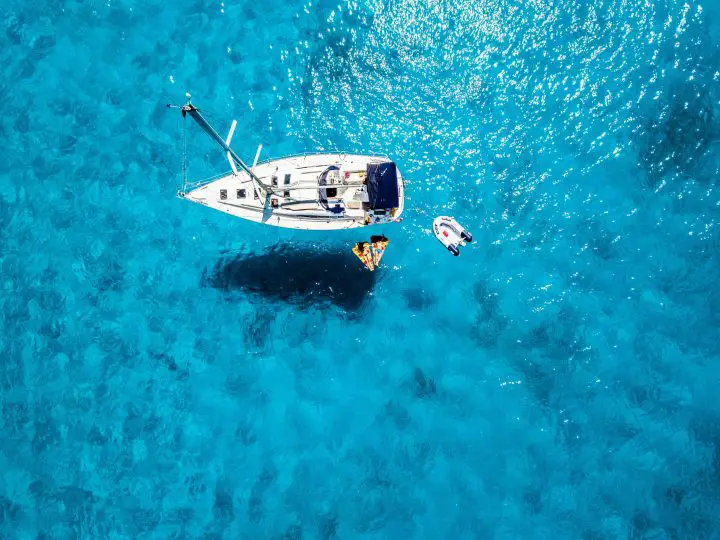
The truth is, many reasons bring people to move onto a sailboat—or any kind of boat. If you’re unfamiliar with boat life, think of boats as floating RVs or campers. They attract all sorts of people, from wealthy travelers to people making ends meet. And just like with RVs, they range from palatial yachts to cramped, dingy things you can’t get away from fast enough.
Buying a sailboat to live on has grown in popularity in recent years and has boomed during the coronavirus era. While the global pandemic certainly slowed world travel, it has pushed more people to work from where ever they like. With unlimited data cell phone plans, you can take your boat nearly anywhere and still be connected with the world.
The first question to ask is, “What sort of boat do you want to live on?” Boats come in every shape and size to suit every boater. As a result, the choices can be overwhelming when you first consider the lifestyle.
All boats represent compromises. The vessel designer made compromises to fit all the things in the boat that they could. There are compromises in performance in favor of more creature comforts, or vice versa.
Likewise, you’ll make compromises when you purchase a boat. You may find that the vessel of your dreams is out of your budget, so you compromise with a smaller boat or one lacking some features. You may opt for a stout bluewater boat built for ocean crossings. If that’s the case, you will invariably compromise on some liveaboard comforts that cheaper coastal cruisers might offer.
What the boat needs to have for you to liveaboard is entirely up to you. Is your idea of the liveaboard lifestyle all about downsizing and living simply? Or is living aboard a means to an ends—a way to slowly travel the world comfortably while taking “home” with you? Do you live for the passion of actual sailing, or is sailing just a cheap way to move from place to place?
In other words, before you go boat shopping, you must narrow down your goals for the vessel. Next, we’ll look at some of the features that will make how to live on a sailboat easier, but remember that nothing is mandatory.
Buying a Sailboat to Live On
If you’re wondering whether or not sailboat life is right for you, start by thinking about what the perfect setup would be like. Chances are you have some preconceived notions of what living on a sailboat is like. And chances are there are ways that it could be like that, but there are also ways that it could be completely different.
Before you dive too deep into the lifestyle, don’t pigeonhole yourself into looking at only sailboats. There are tons of powerboats that you can get for similar prices as used sailboats. And motorboats have a few advantages over sailboats, especially for living aboard.
The most common types of powerboats you’ll see people living on are trawlers or cabin cruisers. First, the design of these boats means that their hull shape is better able to accommodate living space. They’ve got wide sterns and bigger interiors. They also usually have large windows and a nice view out of the living area, something most sailboats lack.
The only thing that a powerboat can’t do is sail (obviously), and most people don’t cross oceans in them. But most people who buy sailboats to do those things never actually do them! So again, it all comes back to being honest with yourself about what you want to do with your boat. If you’re after comfortable living space and the ability to travel anywhere along the coast, a trawler should be high on your list.
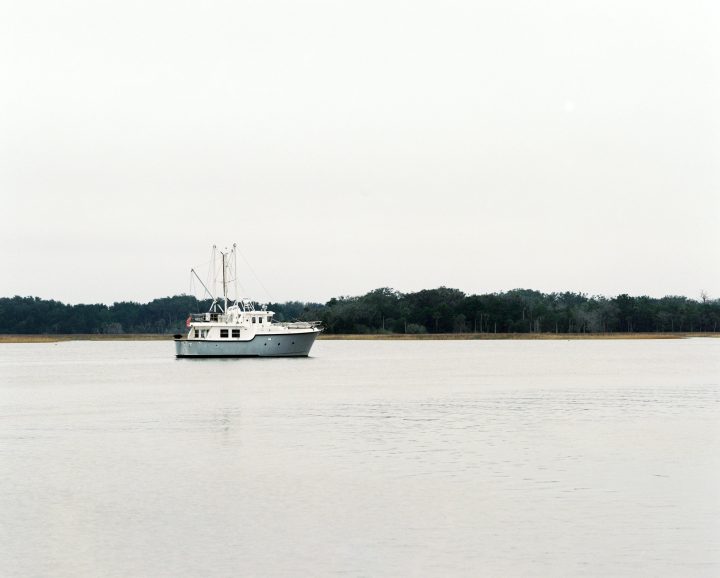
Price Range
You can’t go boat shopping (or even dreaming!) without at least some idea of your budget. You can spend anywhere from $1,000 to well over $10 million buying a sailboat. You have to narrow it down a bit!
Here are a few pointers to guide you. If you browse for a boat on Yachtworld , you can get a pretty good idea of a particular make and model’s nominal value.
These are brokered boats, so the list prices seldom equal the sale price. But it provides a good way to analyze the market. Some will be priced very high because they are newer, have newer upgraded engines, are better maintained, or are otherwise “better.” By eliminating those, you should be able to estimate the average value of a particular make and model.
You may find listings that look like bargains because they are priced lower. Chances are, these are project boats. Project boats require “elbow grease” or “DIY skills” to restore. A project boat is always a losing proposition because it will usually take many more dollars to get it ship-shape than it would cost to have just bought the kept up boat to begin with.
Here’s an example. Say you’re shopping for one of the best liveaboard sailboats , like a Catalina 30, and the average price is around $18,000. Then, one day while browsing Craigslist, you see one listed for $5,000. A bargain, right? Well, it should be no surprise that the $5,000 boat “needs a little work.” But what you might not realize is that it probably needs $20,000 or more worth of work (and even that number is if you plan on putting in your own elbow grease).
The moral of this story is pretty simple—plan on paying the average price for a sailboat. Of course, there might be some bargains out there. But generally, if you want a functional, livable boat, it will cost you some cash.
Catamarans are popular choices for liveaboard boaters, especially if you plan on anchoring or traveling a lot. These boats have expansive living spaces that feel much less crowded and claustrophobic than typical boats. Even sail cats ofter raised salons with wrap-around windows and lots of fresh air flowing through.
On the flip side, it can be challenging and expensive to find a dock or repair facility in some parts of the world when you need one. So if you plan to live at a dock on a catamaran, start your search by finding the dock first. Catamarans are too wide to fit in regular slips, so marinas must put them on the limited number of bulkhead or t-head docks they have.
Catamarans are expensive, and it’s generally not good to stretch your budget when buying a boat. If you do, you’ll have less money in the back to travel or spend on upgrades and repairs. So if the catamaran lifestyle appeals to you, double-check your numbers to ensure you can afford to do it right.
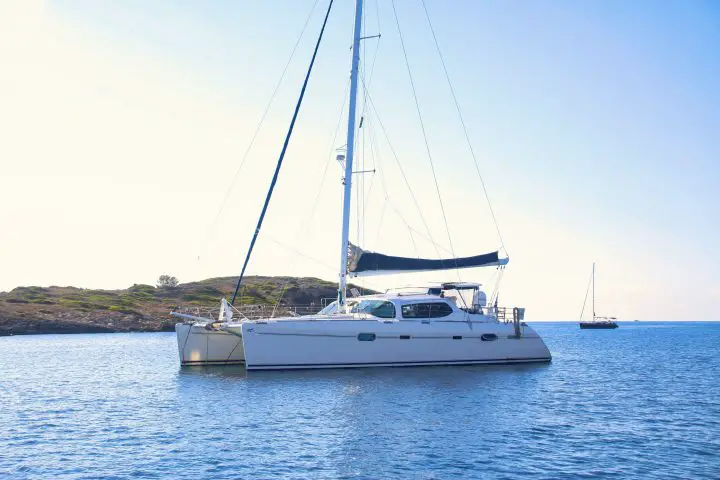
Being a liveaboard boater does not mean you must spend your life tied to a dock. You could travel regularly from your marina home base. Or you could travel and not have a home base. It all depends on how you organize your life and your obligations.
If you intend to live as off-the-grid as possible, that should be considered when you go boat shopping. Some boats are easy to set up that way, and others are not.
If you spend a lot of time away from docks, you must come up with a plan to get some necessities. Some things are easy, and others are more difficult. You’ll have to answer questions about how you will get electrical power, fresh water, pump outs, fuel, and groceries.

Electrical Power
At a dock, you can plug in with a large extension cord and enjoy unlimited power just like you would in a home. Since all the power arrives through the one big cord, there might be some inconveniences, like you cannot blow dry your hair, make microwave popcorn, and brew coffee all at once. But generally, you’ll have outlets that work and plenty of power to run air conditioners, heaters, cooking appliances, and whatever else.
Away from the dock and unplugged is another thing entirely. Some boats have generators that will run 24/7 to maintain the same comforts. But generators drink diesel fuel and are noisy and smelly. Most sailors who live off the grid prefer to use solar panels and a large bank of batteries to power what they need. In all but extreme cases, however, this means that some power-intensive conveniences like air conditioning and heaters are not viable options.
Fresh Water
Docks will supply city or well water for use onboard. In some cases, you plug in a hose for unlimited supply, but on most boats, you simply fill up the water tanks whenever you need to.
Away from the dock, you’ll have to rely on the tanks alone. When they get low, you’ll need to visit a dock to refill them. Any marina will let you fill up, but most boaters combine it with a trip for fuel or a pump out.
Some boaters catch rainwater and put it in their water tanks. Others carry jerry cans of water from shore in their dinghy. And on ocean-going boats, you can install water-making systems that desalinate seawater and make it potable.
If water goes in the boat, it must come out, right? It is illegal to dump your toilets overboard in most parts of the world unless you are far offshore. So boats are equipped with a holding tank—the boat equivalent of the RV black water tank.
To empty the tank, you visit a pump out station. This is simply a pump that takes the tank contents and puts them in the local sewage treatment system. It is far more ecologically responsible than dumping it.
The size of your holding tank is a significant limiting factor on most liveaboard vessels. On average, a 20-gallon tank will last a couple about one week of full-time living aboard. So plan on a weekly trip to the pump out dock. You can just use the marina’s facilities as often as possible if you live at a dock. That will extend your time between pump outs considerably.
Some places have pump out boats that will come to you. This is common in busy mooring fields or anchorages like those found in Florida. Some are provided by marinas, and others are done by local cities or counties. Interested in liveaboard marinas in Florida , visit our guide!
Living aboard doesn’t burn any engine fuel. And it’s usually easy to find gas or diesel fuel docks when traveling.
But you’ll also occasionally need cooking fuel, usually propane. You may also need fuel for your heaters during winter. Boat heaters work on diesel, propane, or solid fuels.
Finally, you’ll need a plan for groceries. For example, if you live at a dock at a marina, you might keep a car there and live like you would if you had an apartment.
If you don’t have a car or are traveling, you will start looking for grocery stores near marinas. Walking distance becomes important, as do marina loaners cars or Uber.
You can make a lot of upgrades and modifications to make the boat you choose, but it’s not possible to fundamentally change the boat’s characteristics. If you’re thinking about living on a boat full time, you need to consider the living spaces and whether or not you and your family can comfortably live there.
Salon, Cockpit, and Staterooms
You’ll spend most of your time in the larger spaces, like the cockpit and salon. The cockpit is like the outdoor patio, and the salon is like your living room and dining room combined. Do these areas have enough space for everyone to lounge comfortably? What about regular everyday things like reading a book or watching the tv?
Designers make boats comfortable and safe while boating, but it’s only recently that they’ve emphasized the livability aspect of their designs. As a result, many sailboats have small cockpits that are safe at sea but cramped for day-to-day life. Likewise, settees and lounges might not be engineered for comfort so much as use in rough seas.
A common complaint that people have about boat life is the shape of the beds. Staterooms on small boats usually have v-berths, vee-shaped cushions in the bow. These can be very difficult to get in and out of, especially for couples. They nearly always involve getting trapped inside and having to climb over your partner to get out. Island berths, which stand in the center of the stateroom and can be accessed on either side, are a great upgrade.
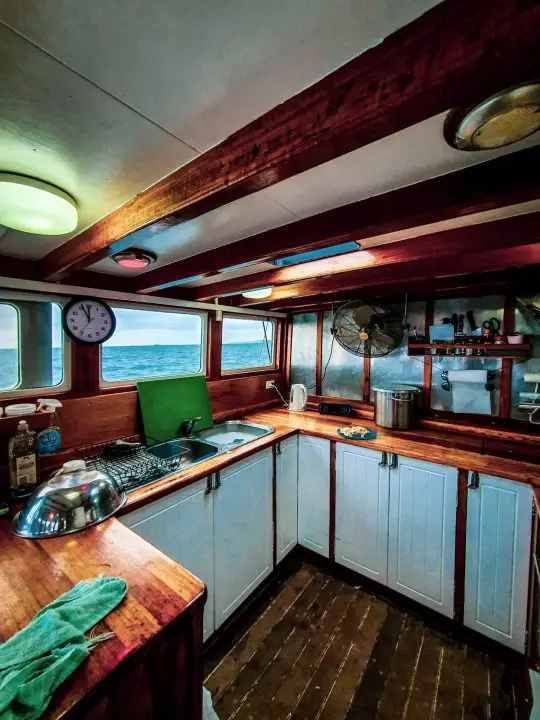
Galley and Head
And then there are the functional parts of the boat like the kitchen and bath (or the galley and head in boating terms). Kitchens will be much smaller than even efficiency apartments. Expect a simple gas range and small oven at the most. Some boats will have a microwave, but not all. Refrigerators are small, and on sailboats, they are often awkward top-loaders. The biggest problem you’ll find with most boat galleys is a lack of counter space and storage.
The head is another place to analyze what living aboard would be like. Smaller boats have “wet heads.” That means that if you want to have a shower, you’ll sit on the toilet, and everything will get wet. The opposite of a wet head is a separate shower stall, which is a great upgrade if you are living aboard full time.
Pros and Cons of Life on a Sailboat
So now you’ve got some ideas about what makes up life on a sailboat—or at least a look at the variety and sorts of boats that you can liveaboard. What would make you want to take the plunge, and what would give you pause? Here are a few pros and cons to the liveaboard lifestyle.
Living on a sailboat provides an amount of freedom that people with houses can never know. Don’t like your neighbor? Change slips or move to a new marina. Sick of this town? You and your house can be in another state in a few days.
Not being tied down means you can organize your life to travel more. For example, if you aren’t tied to a local job, you could spend summers staying cool in New England and winters in Florida or The Bahamas. Or if you’re entirely untied, head off into the sunset for the Caribbean or an around the world cruise.
2. More Time On the Water
It only follows that you must like the water if you’re looking at boat life. Many people feel a special connection to nature from being near the sea, be it at the beach or on a boat. Boats provide you with endless million-dollar waterfront views that can change as much as you want to travel. You’ll enjoy your morning coffee with a whole new crowd—pelicans, dolphins, sea turtles, and manatees may be in your backyard every morning.

3. Romantic, Slow Paced Travel
Even if you don’t cruise, there is a romantic connection to travel in every boat. Arriving in a new town by boat is unlike any other travel experience. Every town looks like the same strip malls and chain stores by car. But by boat, you can see towns like an explorer, viewing each historic waterfront and finding all the best dive bars and cruiser hangouts.
With the right sailboat, you can travel nearly anywhere in the world. Some people dream of completing a circumnavigation, while others stick to seasonal cruising. Whatever your goal, sailboats might not be the fastest way to travel, but they are certainly the most romantic.
4. Small Space Simple Living
On the one hand, boats and RVs are the mobile equivalents of the tiny house. If the idea of downsizing your possessions and valuing experiences more than material goods appeals to you, living in the small space of a liveaboard boat might be right for you.
It might seem counterintuitive because boats are pretty complex and expensive items. But downsizing is a relative thing, and no matter how fancy the boat is, chances are the people living on it downsized their lives to get there. Boats themselves are complex, but they also prevent you from being burdened by many non-essentials.
5. Sailing Community
Finally, the sailing and boating community is full of interesting and fun people. Everywhere you go, you’ll meet boaters that come from a wide range of backgrounds who have similar interests to your own. The community is supportive and known for fun get-togethers over cocktails or pot-lucks.
1. Difficult to Find Liveaboard Marinas
If your goal is to live on a boat and stay in one place, you might find it’s hard to get a marina or anchorage that suits you. Marinas are businesses, and each one is operated to suit a particular crowd. Some welcome liveaboards while others do not. Sometimes it’s the marina policy, and other times it has to do with local city or state regulations.
However, if you are traveling on your boat as a cruiser, you have little to worry about. Travelers and voyagers are always welcome, and transient slips at marinas for up to three months are usually readily available.
2. Small Spaces
Wait, wasn’t “small living” a pro of living on a boat? It was, but it can suck too. Cramped spaces, storage limits, and small living get old and frustrating after a while. No matter how hard you try, you’ll wind up collecting too much stuff that you have no room to store. Downsizing is a process, not a one-time event when you live on a boat.
And then, there are the problems that stem from sharing a small space with your partner or family. Boats offer very little in terms of private space. Even if you get off the boat everyday and travel, living together so closely for any length of time will test any relationship to the breaking point.
3. Constant Maintenance Costs and Fixing Things
Boats are constantly breaking. They float in an acidic solution 24/7, are subject to constant motion and vibration, and are full of explosive substances and toxic chemicals. Sometimes it seems like they are willfully trying to self-destruct and take you to the bottom of the ocean.
Of particular note regarding crew morale are those ever-constant maintenance issues related to the toilet plumbing. Marine heads stink—but literally (sometimes at least) and figuratively in their design and function.
Engine problems are also a big concern, primarily for their expense. A new engine can easily cost more than you paid for the entire boat!
Repairs on boats slow down after the first year of ownership once you handle everything the vessel needs. But by then, your time will be full of preventative maintenance tasks to keep it all working well. As the saying goes, an ounce of prevention is worth a pound of cure.
4. It’s Really Very Slow
If you’re buying a boat to travel, you might be shocked at how little traveling you can get done. Boats travel at the whim of the weather, which often means sitting in port and waiting for better conditions. There’s a lot more sitting and waiting than actually sailing. If you’re coming from the land-based road world, this is a stark contrast to hopping in your car and driving off whenever you feel like it.
Even when you do travel, moving between five and seven miles per hour is slow. What can be done in one day in a car now takes you three to four 24-hour days of constant travel.
5. Sometimes, It’s the Worst
Maybe that’s mellow dramatic, but experienced sailors will understand the sentiment. But sometimes, it just seems like the weather or entire ocean is trying to kill you.
Then, there’s the constant inconvenience of it. Just getting a cold beer out of the fridge might involve clearing the countertop, opening the lid, taking out two top shelves, and leaning down at the very bottom to find the last bottle. Then, there are marina wifi problems, seasickness in rolly anchorages, and boat parts lost in the mail or stuck in customs.
Like many choices you make in life, living on a sailboat is not about the boat or the place. It’s all about your attitude. Is it an adventure or a nuisance? Of course, everyone experiences inconveniences once in a while, no matter where they live. But boats make everything seem more dramatic, causing you to doubt your choices at the first signs of discomfort.

It’s hard to describe both the pleasure and the dispair that living on a boat can provide. It’s been said that for every low-low, like a back-flowing toilet, there are high-highs, like the perfect sunset with dolphins dancing just for you.
From my observations, most people who move aboard give it up after their second or third year. Unfortunately, many don’t make it past year one, which is always the hardest due to the steep learning curve.
The best advice is to try sailboat life before you buy into it. Charter a boat or take some sailing lessons. Find friends with boats who will take you out and share their stories with you. Do research, go to boat shows, and try it out in any way you can before taking the plunge. And no matter what you do, remember to enjoy and savor the adventure!
Is living on a sailboat worth it?
I think so, and many others do too. But living on a sailboat is not for everyone. Boats range from luxurious yachts to cramped, floating tents. No matter what size boat you choose to live on, there will be times when you doubt that it’s worth it.
All boats are cramped and uncomfortable at times. Life revolves around the weather, the boat, and staying safe. Sometimes it means getting out of bed at 2 am to move the boat in a storm, and sometimes it means not joining your friends at the beach party because something broke and you need to fix it.
It’s impossible to answer whether or not living on a sailboat is worth it to you—only you can make that call. This is because sailboats offer not only a way to travel but a way to completely change your life.
Can you legally live on a boat?
Yes, you absolutely can live on a boat. But depending on where you want to live, it can be challenging to find marinas or anchorages that will allow you to. There is nothing inherently illegal about living aboard a boat, but liveaboards are frowned on by many dockmasters and local governments. However, you can find liveaboard marinas, and many have lovely, welcoming communities of people who love their vessels, the water, and the sailing lifestyle.
Matt has been boating around Florida for over 25 years in everything from small powerboats to large cruising catamarans. He currently lives aboard a 38-foot Cabo Rico sailboat with his wife Lucy and adventure dog Chelsea. Together, they cruise between winters in The Bahamas and summers in the Chesapeake Bay.
- Inshore Fishing
- Offshore Fishing

- Download ALL AT SEA
- Subscribe to All At Sea
- Advertising – All At Sea – Caribbean

Living Aboard a Sailboat in the Caribbean: A Cost Analysis
You know you want it...
Mocka Jumbies and Rum...

Living aboard a sailboat in the Caribbean can be a dream come true for many people. The warm weather, beautiful waters, and slower pace of life can be enticing. However, before embarking on such a journey, it is important to consider the costs associated with this lifestyle.
Cost Analysis:
- Upfront Costs – Purchasing a sailboat can be a significant expense, but it is an investment that can pay off in the long run. Other upfront costs include outfitting the boat with necessary equipment and safety gear.
- Monthly Expenses – Monthly expenses for living aboard a sailboat can vary depending on a variety of factors such as location, boat size, and lifestyle choices. Common expenses include mooring or dock fees, maintenance and repairs, insurance, and food and provisions.
- Unexpected Costs – Living aboard a sailboat can also come with unexpected costs such as emergency repairs or medical expenses. It is important to have a contingency plan in place for unexpected expenses.
Buying the Time of Your Life
Hardships of Living Aboard:
- Limited Living Space – Living aboard a sailboat can be challenging due to the limited living space. It is important to be organized and to have a system in place for storage and organization.
- Weather and Conditions – The Caribbean can experience intense weather conditions such as hurricanes, which can be dangerous for sailboats. It is important to have a plan in place for securing the boat during extreme weather.
- Maintenance and Repairs – Sailboats require regular maintenance and repairs, which can be time-consuming and costly.
Conclusion: Living aboard a sailboat in the Caribbean can be an affordable and fulfilling lifestyle, but it is important to carefully consider the costs and potential hardships before making the leap. With proper planning and preparation, however, the rewards of this lifestyle can be endless.
Sailing with Charlie: Oldies & Goodies
Sailing with Charlie: World cruisers are everywhere these days
Don't Miss a Beat!
Stay in the loop with the Caribbean
Is It Even Possible To Be a “Part-Time Cruiser?”
Single-cell microbe helps corals survive climate change, cruising the caribbean safely: tips & resources for a secure journey, so caribbean you can almost taste the rum....

Recent Posts
Discover the magic: 5 caribbean bio bays to visit for bioluminescent waters, saffier se 24 lite: a perfect daysailer in the british virgin islands, antiguan yachting industry gains future star: ishmael auguste earns scholarship, recent comments, subscribe to all at sea.
Don't worry... We ain't getting hitched...
EDITOR PICKS
Talkative posts, the seven words you can’t put in a boat name, saying “no”, program for financing older boats – tips and suggestions, popular category.
- Cruise 1753
- St. Thomas, US Virgin Islands 517
- Tortola, British Virgin Islands 434
- Caribbean 430

All At Sea - The Caribbean's Waterfront Community Caribbean Cruising, Sailing, Boating, Fishing and Yachting
Contact us: [email protected]
© Kennan Holdings LLC - All Rights Reserved
Sailing A Catamaran
20 steps for a beginner to take before deciding to live on a sailing catamaran.
When I started thinking about living on a sailing catamaran, I really only had the experience of a couple of weeks on charter cats. After several months and countless hours of research, I learned many fascinating things. So what are 20 Steps for a Beginner to Take Before Deciding to Live on a Sailing Catamaran?
The 20 Steps for a Beginner to Take Before Deciding to Live on a Sailing Catamaran are:
- Learn to sail
Get Certified
Charter a Sailing Catamaran
- Attend a boat show
- Contact a Catamaran Broker
Set Your Boat Budget
- Buying new or used?
- Talk to the Bank
- Selling your house?
- Renting your house?
- What to do with your pets?
- Equip for your Lifestyle
- Start out by land
- Work out the kinks
- Create your monthly budget
- Make a list of your boat needs, wants, not important
- Get networked with fellow cruisers
- Learn how to predict the weather
- Attend Cruiser’s University
- Don’t buy the first boat you see
- Do your homework
Learn to Sail
You don’t have to learn to sail before buying your catamaran, but it may shorten your learning curve. One of the best ways to learn to sail is to start with a dinghy sized sailboat at a local club. Take a sailing class to learn the basics. Having a small sailboat is a plus in that they react almost instantly to every maneuver that you perform. Large sailboats may have a 15 to 20 second reaction time. This instant reaction time helps teach you about the wind, sails and how each action that you perform affects the boat.
Getting a certification from an accredited sailing school and/or association will be beneficial in many ways. First, you will learn valuable lessons from experienced sailors that will help you navigate and make decisions when situations arise. Next, your instructor can be a mentor for years to come. Further, being an educated sailor provides confidence that will be much appreciated by your crew when challenges arise. Finally, many insurance companies will require this before they issue a policy on your boat.
This is a great opportunity to spend some significant time on a sailboat. Charter a boat that is similar in size and layout to the one you are considering. During your charter, think about living on a boat VS vacationing. What will be important to you as a full time liveaboard? Make good notes. You may find out that you can live in a much smaller size boat than you originally imagined.
Attend a Boat Show (or two or three)
Find a boat show that has boats like the one you want to purchase. This might be a good opportunity to fly out to one of the larger shows like Annapolis or Miami or Cannes which have many different makes, models and layouts. While at the boat show attend some seminars or courses like Cruisers University. Talk to and network with fellow sailors. This is another great opportunity to prepare before you purchase.
Walk on as many boats as possible to learn floor plans, sizes and brands. Attend as many boat shows as possible. Learn about the mechanics of each boat and what the previous owner used it for. Is it set up for the same usage as your plans? If coming out of a Charter, plan what you will need to invest in it to make it ready for you? Look at used boats – not just new boats and boats that fit your budget.
Contact a Broker that Specializes in the Type of Boat you Want
Now that you have done some basic research on your own, have learned the basics of sailing and are on your way to becoming certified, have attended a boat show and walked on and in several different types of boats, have spent a week or two on a charter, you have some basic knowledge and hopefully a direction as to what type of lifestyle you want to live and type of boat you want to have. Now is the time to contact a broker.
When to Contact a Broker
You can do this earlier on in the process, so they can help move you along in your research faster, but I believe that a little time spent preparing yourself will make you ready when the right boat comes along and won’t make you feel pressured into buying before you are ready or having regrets on letting the perfect boat get away. By the way, experienced sailors will tell you that there is no perfect boat. Every boat has its pro’s and con’s which is why the more prepared you are, the better fit you will find.
You may already have your budget figured out before contacting a broker. If you are buying new and have attended a boat show or two and already know how you plan to use your boat, then you may already have this one figured out. Keep in mind that when buying new, you will still need to equip the boat with the gear and equipment needed for your lifestyle.
Buying Used?
If you are buying a used boat, there are so many more factors to consider. Look at the age and condition of the many systems on the boat. Have a professional survey completed and be present during the survey so that you can get a face to face explanation of what was found. This is the time to ask the expert specific questions about the boat, its systems and maintenance items. Consider what extras you need to add and what will need to be repaired or upgraded and ask about costs.
How Big of a Catamaran can you Afford?
Whether you are buying new or used, you should have a price range that you are comfortable with. I have heard many stories about cruisers having to cut their journey short because they ran out of money. Picking a little smaller boat, may be better on your pocketbook and stress level. It may also give you a cushion should a costly repair spring up.
The Right Time to Talk to the Bank
If you are planning to finance your boat purchase, ask your broker to put you in touch with a few lenders. Call them before you find your boat. Ask them about the programs they offer. Pay close attention to any limitations. Some lenders will only lend on newer boats that are 10 years old or newer. Understanding the interest rate, down payment requirement and any lender specific qualifications may lead to in a certain direction towards a certain type or age of boat. This is good to know ahead of time before you spend money on a survey only to find out, you can’t get it financed.
Sell Your House?
What is your timeline for living on a boat? For most people it is a limited timeframe. It isn’t a forever home or plane. My plan is to circumnavigate the globe. I think this will take us two years. So for us, we need to think about what will we be doing in two years? Where will be want to live in two years? Do we want to go back to the community that we left or forge ahead to new, unexplored places? Those questions plus your finances will help you to determine if you should sell your home or keep it.
Keep Your House?
Perhaps you love your home, neighborhood and community and want to keep your house. Then you need to think about renting out your house. Will you do an Air Bnb or VRBO type rental or go more for longer term renters? What will you do with you possessions if you sell your home? Is your home ready to sell? Is your home ready to rent? How much rent can you expect? Can you live off of the rent money that you house will take in after you pay the rental agent and expenses?
What To Do With Your Pets?
Do you have pets? If so, can you bring them on board? Do you want to bring them on board? If you are leaving your home country, will you be allowed to bring the pets into your destination country or countries? What documentation will you need to bring your pets into a new country? Are your pets worth bringing on board? These are just some of the questions and consideration for you to think about when planning for pets on your catamaran.
Equipping Your Boat for Your Lifestyle
When choosing a boat, you will need to equip it for your lifestyle and plans. If you are going to live in marinas in warm, tropical weather, then you will certainly need air-conditioning. If you are going to circumnavigate, then you must have a water maker, good navigation equipment, and safety gear. If you are planning to spend a lot of time at anchor, then you’ll want to have a good solar set-up that will be able to run your refrigerator(s) and freezer(s). If you are doing a crossing, make sure you have enough refrigeration. Back-up systems for the critical components may be important as well.
Start Out By Land
Plan your first 6 months near land and take short trips until you get used to the boat. Spending time near land when you first move aboard gives you the opportunity to learn your boat and learn about living on your boat. Take note of how much food you go through in a week. Make good notes and think about where you are planning to travel so you can think about how you are going to provision the boat.
Working out the Kinks
Use this time to work out any problems with the boat and to really get to know your boat from sailing to motoring to anchoring. If you are planning on spending a lot of time at anchor, then take some overnights away from marinas out at anchor. Learn about how your solar system works and what you can and can’t run off of it. Will you need to run your generators every day for a time or do you have enough solar to power your critical components. Can you live without air-conditioning? In the marina, you are on shore power, but this is a good test of your systems and your usage of those systems. How much water do you use? Test how long you can go on a tank of water. Will your water maker run off of the solar or do you need to run the generator to make water?
Creating Your Monthly Budget
Create a monthly budget that you can live with. The items in the budget may need to change once you go from theory to reality and as you move around, but stick to the numbers as closely as possible. If you are starting in the US, then moving off shore, it is best to provision as heavily as possible before you leave. Items in the US are most often priced better than in the Bahamas, BVI’s or elsewhere in the Caribbean and you may not always be able to find the same items you are used to. Make sure to plan your food items, fuel for both the boat and the dinghy, restaurants (if you plan to eat out), misc. items and don’t forget boat repairs (plan on 5% to 10% of the cost of the boat per year).
Create Your List of Needs, Wants & Not Important
When deciding on a boat, create a list of needs, wants and things that are not important to you. You might also leave room on the bottom of your list for things you don’t want and to make comments about each boat. This one is an important step when buying a boat.
There is NO Perfect Boat!
As I mentioned previously there is no perfect boat. You will need to look at each boat and what it offers. One boat may sail lighter and faster, but have limitations as to how much provisions and items you have on board (lighter boats typically equal less cargo). Another boat may have the perfect floor plan, but may need lots of work, etc. Make a list with columns. One column will have the item or feature, the next will have need, then want, then not important. Think about all of the features of a boat and write them down or enter them into an Excel spreadsheet. Now put an “x” in the column of where that item falls on you list of needs, wants or not important. With every boat that you look at, use this list to help you to evaluate it.
Get Networked with Fellow Cruisers
Join a cruiser network or start out in popular cruising destinations. Meet, socialize and ask questions to experienced cruisers. Cruising can be lonely, if you want it to be, but from I have learned, cruisers are some of the most friendly and outgoing people you will ever meet. Every cruiser has a common purpose – cruising. Every cruiser has challenges that face every day. This gives commonality which makes it much easier to meet, approach and talk to fellow cruisers.
Finding Cruiser Networks
Beyond approaching cruisers in marinas or in your dinghy at anchor, there are many cruiser networks. Some are on-line or in social media, some are in the form of organized rallies where you sail together in pre-planned, mapped out routes and locations. You can find some of these clubs by simply doing a google search. Boat shows are fantastic ways to build your network. Asking fellow cruisers that you meet at the shows or elsewhere what social networks they belong to is another excellent way to find groups with similar interests as you.
Different Strokes for Different Folks
Even within the cruising network, there are many different types of people with different interests and in different stages of their lives. This is one thing that makes cruising so cool. It appeals to different groups of people. Cruisers with kids may have different networks than those that are single looking for more of a party atmosphere. Keep looking until you find your network or networks.
Learn all about weather and how to avoid bad weather.
The weather may be the single, most important influencer on a sailor’s life other than maintaining your boat. On land, the weather is important so we know if we need to take an umbrella with us to keep dry when we run from our car to the grocery store or a restaurant. At sea, bad weather can not only be an inconvenience it may be the difference between life and death.
Predicting the Weather
Learning to read weather patterns and learning how to use tools like Predict Wind, allows cruisers to pick and choose which days they will sail, what distance they plan on sailing, and may even determine the route they take. Knowing present and future wind directions are helpful when choosing a protected anchorage. What starts out as the leeward side of an island may quickly change to win-ward and a rough, uncomfortable anchorage. Cruisers University has an intensive class on weather.
Attend Cruisers University
Cruisers University and other seminars like it provide useful information on a variety of topics for cruisers by cruisers. There is nothing better than experience and the speakers at these courses bring their experiences to you.
Seminars that are offered include (this is a partial list):
- Diesel Engine Maintenance,
- Marine Weather Forecasting,
- Marine Electrical Systems,
- Sewing for Sailor,
- Anchoring For a Good Night’s Sleep
- Bahamas Bound – Cruising the Abacos
- Cruising and Living in Hurricane Latitudes
- The Chesapeake to the Caribbean
- Cruising on a Budget; Silver, Gold Platinum
- Docking and Line Handling for Couples
- The Efficient Boat Fridge
- Electrical Systems – Understanding and Troubleshooting
- Great Products You Need to Know About
- Heavy Weather Sailing
- Maintaining Your Boat Above and Below the Waterline
- Maintaining Your Diesel Engine 101
- Moving Your Business Abroad
- Managing the ICW; North to South
- Offshore Energy Management & Design
- Off Shore Rigging and Sails – When Things Go Wrong
- OMG I Bought a Boat – Now What?
- Plugged In – Power Cord Safety
- Provisioning – From List to Last Bite
- Route Planning
- Safety at Sea
Don’t Buy the First Boat You See!
Remember the old saying about there being many fish in the sea? Well, the same holds true for boats. There are many boats for sale. In order to know what is available to you, you really need to see several boats before making your decision. Before finalizing your purchase, you will be paying for a survey which includes a haul out. This will be costly so be choosy. Also, just because you spent several thousand dollars on the survey, don’t be afraid to walk away if you aren’t comfortable with the boat and what the survey found. Use your list of needs, wants and not important to help you. Do your homework. Afterall, you will be spending a lot of time on your boat. It needs to fit you and your lifestyle.
What Makes a Living on a Catamaran Different Than Other Boats?
Living on a sailing catamaran is like many other boats except that the width of a catamaran makes it more comfortable and stable under most conditions. Living on a cat is also different than most monohull’s because the living areas (with the exception of the state rooms and heads), like the salon and galley, are up at the same level as the cockpit which allows for more openness and easier to go from in to out. Finally, the living area is much larger per linear foot than a monohull.
Do Your Homework!
This post can’t possibly cover everything you need to know, but is intended to invoke thought and questions to help provide insight into some of the topics that one should think about and research before deciding to live full time on a sailing catamaran. The one, common theme in this post is that you need to do your homework before you buy and before you decide to buy and before you decide to live on your catamaran. If you do so, you can enjoy your time cruising and will have increased the odds of loving it. Happy Sailing!
Recent Content
Do You Need to Use Reef Safe Sunscreen when Snorkeling?
Do You Need to Worry About Pirates When Sailing?

The Pros and Cons of Living on a Sailboat in the Caribbean
Living on a sailboat in the Caribbean seems like a dream. That is until it’s not. What I mean to say is that before considering sailing the seven seas and settling in the your sailboat in the Caribbean, I would love to tell you about the pros and the cons of living amidst this tropical sea.
Yes, holding a margarita in one hand while cruising around untouched and idyllic islands with the other seems like paradise. And really it is! You can’t deny that. if you choose to live on a sailboat in the Caribbean, o n the other hand, bathing in fresh water, and proper refrigeration may become a thing of the past.
Interested in living full time on your sailboat in the Caribbean? Then take a cruise with me to warmer climates and read on to discover pros and cons of living on a sailboat in the Caribbean.
Living on a Sailboat in the Caribbean is Cheap : Yes Even With Lots of Beer

If you follow my blog then you read my last article. How Much it Costs To Live On Your Sailboat in The Caribbean. So how much does it cost really to live on a sailboat in the Caribbean? As mentioned before it depends on your lifestyle and your craving for juicy steak dinners and fine wine. Spoiling yourself well living on a sailboat is totally OK once in awhile. But if you get to use to a lavish lifestyle while living abroad you will spend your money fast.
My advice? Live like a local. Find out what the average cost-of-living is. You can do this by calculating the average middle class working wage is. If it’s $200 a month for food, then tailor your budget accordingly, adding a few extra bucks here and there to treat yourself.
Want some first hand advice? Lisa Chapin of SailTime San Fransisco here at captaingino.com lives on her boat all the time. After spending two years in the Caribbean she spent another year cruising from these beautiful islands to the Galapagos. According to Lisa, ““You can easily live on a boat for less than $1000, and you could easily live on a boat for $4000.” Things to keep in mind? What I mentioned before. Sticking to a local’s budget will allow you to stay within a $1,000 a month average cost of living. The best part about a local budget? You wont have to skip the local beer.
Inexpensive amenities, tasty local food, and cheap beer are by far on of the biggest pros of living on your sailboat in the Caribbean.
PRO: The Living is Easy And The Siestas Are Long

There is no denying that one of the biggest pros of living on your sailboat in the Caribbean is the laid-back lifestyle. I mean where else in the world is it pretty much mandatory to take a two hour nap in the middle of the day? If you are anything like me, I am all about adult naps. Especially when I am on my sailboat. Okay, so literally everything closes at midday in the Caribbean including banks, doctor’s offices and grocery stores, but who cares? I would take a big meal followed by a two hour siesta any day!
If you are looking for an easy breezy lifestyle, on if the top Pros of living on your sailboat in the Caribbean will, without a doubt be your ability to relax. And there is nothing quite like taking a nap amidst the soft sway of the waves. How divine.
CON: Let Their Be Hurricanes

Living in the Caribbean wouldn’t be complete without tropical storms.But when you gave up your life on land for a life on sea you didn’t really expect it to be all blue skies all of the time did you? No, of course not. If you are on for adventure, you better believe that bearing down for a tropical storm on your sailboat will definitely turn out to be more than adventure. It’s a wild ride, but it can be dangerous. Especially if you don’t have a crew. Either way, tropical storms will definitely be part of your life while living on a sailboat in the Caribbean.
While tropical storms can be annoying, and cause great damage to your sailboat if you are not careful, they certainly are not something to dread. My advice? Use common sense and don’t go out looking for a storm. Stay docked at the marina or seek calmer waters. After all, riding out the storm is all part of the fun, just be smart about it!
Con: You Can’t And Won’t Always Get What You Want

Enjoy your morning pit stops at Starbucks before heading to work? Or how about a fancy cocktail or a microbrew at your happy hour spot? Well, if you have decided to change your shirt and tie for an easier breezier lifestyle on board in the Caribbean, you may have to say goodbye to these little luxuries. That is at least for a while. You see, along with things being a bit simpler (remember those two hour siestas?) there are also commodities like brand coffee and micro-brews you definitely won’t be able to find on a tiny little island in the Caribbean. There will be many times you crave a strong cup of coffee only to be served weak instant coffee. Or, if you are a beer connoisseur, keep in mind that most islands in the Caribbean serve one or two types of beer: light pilsner and pilsner. Microbrews are hard to come by. It’s just how it is.
At the end of the day, you can choose how simple you want your life to be. Perhaps working in a few day trips to a nice hotel for a dip in the pool and a hot shower will scratch that itch for a little comfort and luxury. Either way, remember that trading in your work shoes for flippers and enjoying a simpler life is most likely you were going for in the first place. Sacrificing a few little luxuries of a lifetime of sailing and open seas, is well worth it.
Cons: You May Be Overcharged

Middle aged couple looking at city map
This is a big one. Being overcharged is an aspect of living on a sailboat in the Caribbean that just comes with the territory. If you sail on a big sailboat to any island in the Caribbean, most locals will assume you have money. For this reason, don’t be surprised if you are charged the “Gringo Price” for everything. This means when you go to the island’s market you may be charged double for a pineapple compared with what a local pays. It can be frustrating at times especially if you are on a tight budget.
My advice? Get to know the sellers at the market. Go to the same one every time especially if you are staying longer than a week. From my experience, the seller will get to know you and perhaps realize you are not just on a one time vacation. If you form a relationship with them, don’t be surprised if they start offering you the “local price” or even adding a few extra apples for no price at all.
Pro: Life Is Awesome in The Caribbean

Okay so, wicked cliché right? But it’s true, life really is awesome in the Caribbean. Sure there are plenty of other places in the world to live on your sailboat full time, but nothing quite beats the simple, laid-back lifestyle of the Caribbean. The food is authentic, the culture lively, and the beer (although simple) is cheap. Oh, and there is that whole two-hour nap thing in the middle of the day. I don’t know about you, but living on a sailboat in the Caribbean sounds like a freaking dream to me!
Are you living on your sailboat full-time somewhere in the world right now? Let’s hear about it

5 Best Gadgets For Tiny Floating Houses
Where in The World Are The Best Freshwater Fishing Spots? You May Be Surprised
Here are The Best Destinations in The World to go Standup Paddle Boarding
- Our Community
Want to Retire on a Sailboat? The Brutally Honest Must Read Guide
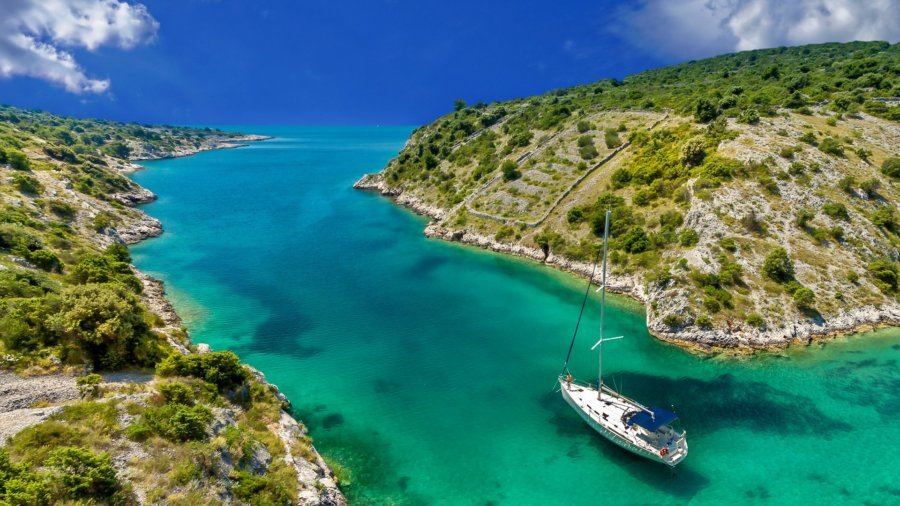
So you want to retire on a sailboat?
You can taste the margaritas and visualize the sunset from your luscious spot in the Caribbean, the Mediterranean or the South Pacific.
You love the idea of throwing the mooring lines and setting off somewhere new once a place has lost your interest.
But is it as laid back and as easy as it sounds, or is it more problematic?
You may have heard many good things about living on a boat– the freedom, the laid back lifestyle and being part of a vibrant community. Even if living on the ocean is not for you there is always life on a narrowboat instead.
You may have also heard the horror stories of people getting hurt, things breaking, and bouts of bad weather. Or of the couples whose dreams of sailing the globe, sink rapidly into divorce.
The reality is that living in a condo also has its downsides. Things break, they can leak and there are many condos full of bored, miserable people.
So what is the truth? How much of the lifestyle is just romantic fiction?
How can you decide if the potentially treacherous waters of a liveaboard retirement are for you?
We chatted with Mike and Gigi McFarlane (who have been sailing the Caribbean for the last four years) whom we met in Bequia in July 2019 to get the true picture.
The result, is a warts and all insight into what living aboard in retirement is really like
Let’s cast the line and explore the world of a live aboard Retirement.
What made you choose to retire on a sailboat?
Having chartered the Caribbean and the Med during our vacations from our jobs for over 25 years, we knew we wanted to live on a boat full time in retirement. We wanted to do it when we are still active because at some point, we will not be able to live this lifestyle. I’m 59 and my husband is 67, so it was now or never.
How long have you been doing it and in what areas?
While on a charter in Greece, Gigi decided she wanted to be able to be captain herself, so she trotted off to Maine for sailing instructions. As a result she achieved the ability to charter a yacht up to 60’. We immediately put that to use to sail the British Virgin Islands, an easy sailing location that allowed us to get our sea legs.
The following years we chartered as Captain and crew in Greece, Turkey, St. Vincent and the Grenadines, Antigua, Croatia, Sardinia, and we revisited the BVI’s over 10 times during our chartering years. We have also sailed the St. Martin, St. Barths, Anguilla area over 4 times. I know I am missing a few places.
We bought our boat (Last Tango) four years ago in Florida. Our goal was to sail the Caribbean, but we didn’t want to miss out on anything on the way down. To get there, we sailed to the Bahamas, Turks and Caicos, Dominican Republic, Puerto Rico, Virgin Islands and over the last couple of years, have spent time at just about every island in the Caribbean. We are currently in Grenada for hurricane season.
What are your typical monthly costs and what are your expenses? Any tips to manage costs?
A typical sailing budget can cost less than living on land. It’s all based on how much can you entertain yourself, how often you go out to eat, what condition you want to keep your boat, and many other factors. But it is similar to living anywhere else. In our case it is less, as we no longer have property taxes, pool maintenance and general upkeep of the house. We have no water or electric bills as we have a water maker and use solar power.
We stay anchored out (‘on the hook’) so we do not have marina fees. Clothing expenses go way down. Since we no longer have a car, we no longer have gas and car expenses. We don’t have a TV, so we no longer have cable or Netflix expenses.
Grocery expenses fluctuate from country to country. On Martinique and the other French islands, many of the products are subsidized by France, so it is possible to fill a grocery cart to the brim, including wine and beer, for less than $150 USD.
Everything in the sea is subject to quite a bit of corrosion, so things break more often than living on land. A rule of thumb is to expect to pay 10% of the value of your boat on maintenance on an annual basis. Phone and internet costs used to be extremely high for us. Now they have laid fiber optic throughout the Caribbean, the costs have gone down significantly.
We meet so many sailors that are living on budgets of far less than $2000 a month, to Mega Yacht owners that spend far more than we can imagine on a monthly basis. It’s all based on how much you can entertain yourself, what condition you want to keep your boat, and many other factors. It also depends on where you are sailing. Panama is very inexpensive, as is Costa Rica.
How much of an investment is needed for setting yourself up with your own boat? What are the minimum requirements to be comfortable living aboard?
Most cruisers we know paid cash for their boats. Again, the range is all over the board in what you would expect to pay; it’s all about creature comforts. Having a watermaker and solar power contribute greatly for us to be comfortable living aboard. We don’t have to lug water around on a regular basis, and solar power allows us to live off the grid without using a generator. When we purchased our boat, we created a spreadsheet of all the items we wanted included in a boat, for example, number of cabins, number of heads, etc. that will greatly impact the price of the boat.
Do you need to have prior knowledge of sailing?
Some liveaboard cruisers we know started out knowing zilch, and figured it out along the way and have been successful. I wouldn’t suggest that approach, as the learning curve in the first two years can be quite steep. I would recommend joining a sailing club, taking classes, attending boat shows, and getting as much experience as you can to make sure you are as prepared as possible for the transition.
Taking classes in weather forecasting, engine maintenance and electrical systems helped prepare us. But no matter what you know, the boat is going to stretch your knowledge and understanding for the task at hand.
What are the key factors in determining if this lifestyle would be right for you?
You have to be extremely flexible as you are dependent on the wind and weather to sail to the next port of call. The mistake some cruisers make is trying to meet a deadline, such as meeting a friend at the airport on a certain date. The weather may not be in your favour.
You must possess excellent troubleshooting skills and not be afraid of work. When you are out at sea and something breaks, you don’t have the luxury of calling your mechanic or plumber. There is an often quoted saying that cruising is all about “fixing things in exotic places”.
What’s the best thing about the lifestyle and conversely what’s the worst?
The sunsets are spectacular. Watching dolphins and whales swim by and jump out of the water, is amazing. Getting to know and understand the people and the culture of the locals is truly rewarding. On a daily basis, life looks like a picture perfect postcard with its white sandy beaches. I have read there are 10,000 active cruisers worldwide. There is a camaraderie that exists between sailors that brings people together from all over the world and crosses all socio-economic barriers that makes sailing the great equalizer.
The get togethers and sundowners with new friends and those we have met in a previous ports result in what I know will be lifelong friendships. It’s never “bye”, it’s always “Sea Ya later”!
On the other hand, it gets hot and humid in the Caribbean, especially in September and October. Without a car, you have to walk or find public transportation to anyplace you want to go. Walking to the grocery store and back with bulky items in tow, then stowing them in a hot boat is not really my idea of a fun time.
Having things go wrong or break at the most inopportune time can get really annoying, as the entire boat gets turned upside down to gain access to the “part” needed to fix the problem. Wanting to adhere to a schedule can be a major pain as you are totally dependent on the weather forecast.
Is there anything that you now know that you wish you had known before committing to being liveaboards?
The learning curve and adjustment during the first year or two of being cruisers was extremely steep. As charterers, we would pick up a clean, maintained boat and be on our way. As cruisers, you need to know and understand all systems in your boat and how they interface with each other.
In addition, living in extreme close quarters with your spouse, especially when you are both learning, well, tempers flare. Since we had both just recently retired, getting used to living with each other 24/7 was a challenge. Getting used to living on the boat really took us about 2 years before it became second nature.
What essential skills or aptitudes are required to retire on a sailboat?
There is really nothing that says you need to know X,Y,Z before you go cruising. It’s all about resume building in terms of sailing. Having troubleshooting skills to fix things as they break is key, and being flexible about life in general is required.
What do you miss the most about living on land?
Hot showers, flushing toilets, a car, and a fully-stocked kitchen you can cook in are the primary things I miss most living on the boat. Not being able to walk off the boat while anchored out is very limiting and can make you feel claustrophobic.
Is there a difference between the reality of liveaboard as opposed to the romantic notions of life on the water?
Yes. As charterers, we knew what we were getting into for the most part as it related to sailing. We didn’t have the romantic notion most people conjure up. But we had no clue how steep the learning curve and adjustment to living on the boat required.
We’re still out here four years later, we have survived without any major mishaps, and we’re still enjoying ourselves. I suppose just that statement in itself attests to the fact that this is not an easy lifestyle and becoming a cruiser should be carefully considered.
Can you live a satisfying life when you retire on a sailboat?
Absolutely.
Just be sure you understand your motivations for wanting to cruise, and understand that you will be “fixing things in exotic locations”.
It will take you about a year to get adjusted to life aboard! But you can’t beat the picture postcard views, sunsets, the camaraderie of other sailors, and the locals you meet along the way.

Mike and Gigi McFarlane decided to retire on their sailboat “Last Tango” and have been sailing the Caribbean for the last four years. Their website and more photos of their beautiful home can be found at www.thetangotimes.com .
You may also like ...

Life in the Slow Lane – The Joys of Narrowboat Living
Meet the author.
Born in the UK, with what must be more than a dash of Romany blood in her veins, Yvonne loves to travel. Yvonne’s other passion is writing, she now follows her bliss and combines the two as a blogger, travel writer and author.
I note that no mention at all about health care cover as abroad you are on your own, a policy for two over 70 would be $10000 to $20000 less deductibles and excess, and could be a game changer to most, regards Toni hodgkins
I am a retired British have lived on my 50′ schooner full time for 3 years in the uk and 6 months of each year of the last 6 years in the UK, and 6 months of each year in our home in cambodia, but in the UK health care not a problem, but sailing abroad is and once over 70 not easy to get multiple health cover, this particular item has been completely ignored which supprises me somewhat, as a policy to cover two people yearly would be in excess of $10000 to $20000 dollors depending on deductibles and level of cover, so that bit is a game changer for some who want to retire on a sail boat, how ever fit they think they are, regards skipper of the two master schooner Elinor.
Leave a Comment

- Supplemental Income
- Cruise Ship Travel
- House Sitting
- Living on the Water
- Volunteering
- The Nuts and Bolts
Popular Posts
The Shocking Truth About House Sitting Revealed
7 Wicked Ways House Sitters Torture Themselves
Why Most House Sitting Profiles Suck ( and How to Write a Spectacular One)
The Ultimate House Sitting Due Diligence Checklist
Previous: Dream of traveling the world? Ditch the stuff!
Next: The Carry-on Commando

15 Things That Change When You Live on a Catamaran

As an Amazon Associate, we earn from qualifying purchases. We also earn from other affiliate websites. See our full disclaimer .
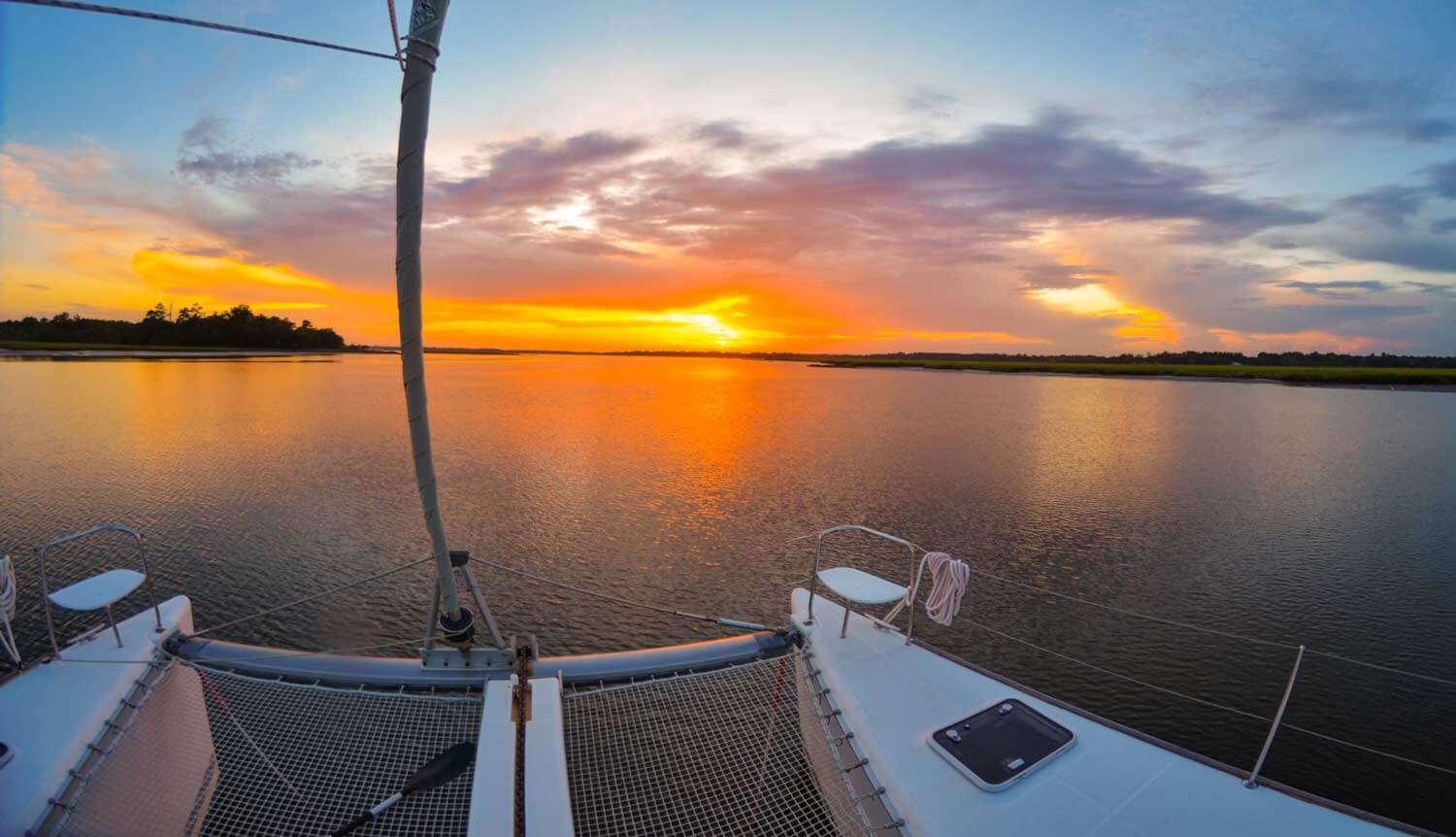
So, the dream of living on a catamaran is starting to look like a reality. You hit the internet to read as much as you can about life aboard.
I get it. For one, I was going to be ready for this big adventure and all the challenges that come with it. There was no way I was going to be caught unprepared. (Yeah… right.)
Preparing for Sailboat Living
When we moved on our sailboat, I quickly learned you have to experience this liveaboard lifestyle to understand the challenges.
It’s been almost two years of living full-time on our sailing catamaran. So, I decided to look at the day-to-day things that are different from our habits in land-based life.
Many things we didn’t think twice about have a massive impact on our lives on the boat. Things like water conservation, provisioning, cooking, cleaning, and adjusting to a small space all take time and energy.
Here are some of the big changes to everyday habits that we discovered living on a catamaran.
1. Laundry on a Boat
A few years back, I was one of those people who threw most things in the hamper after one wear. It was just easy.
Unless you have the convenience of a washing machine onboard, it’s not so simple to run a load of laundry.
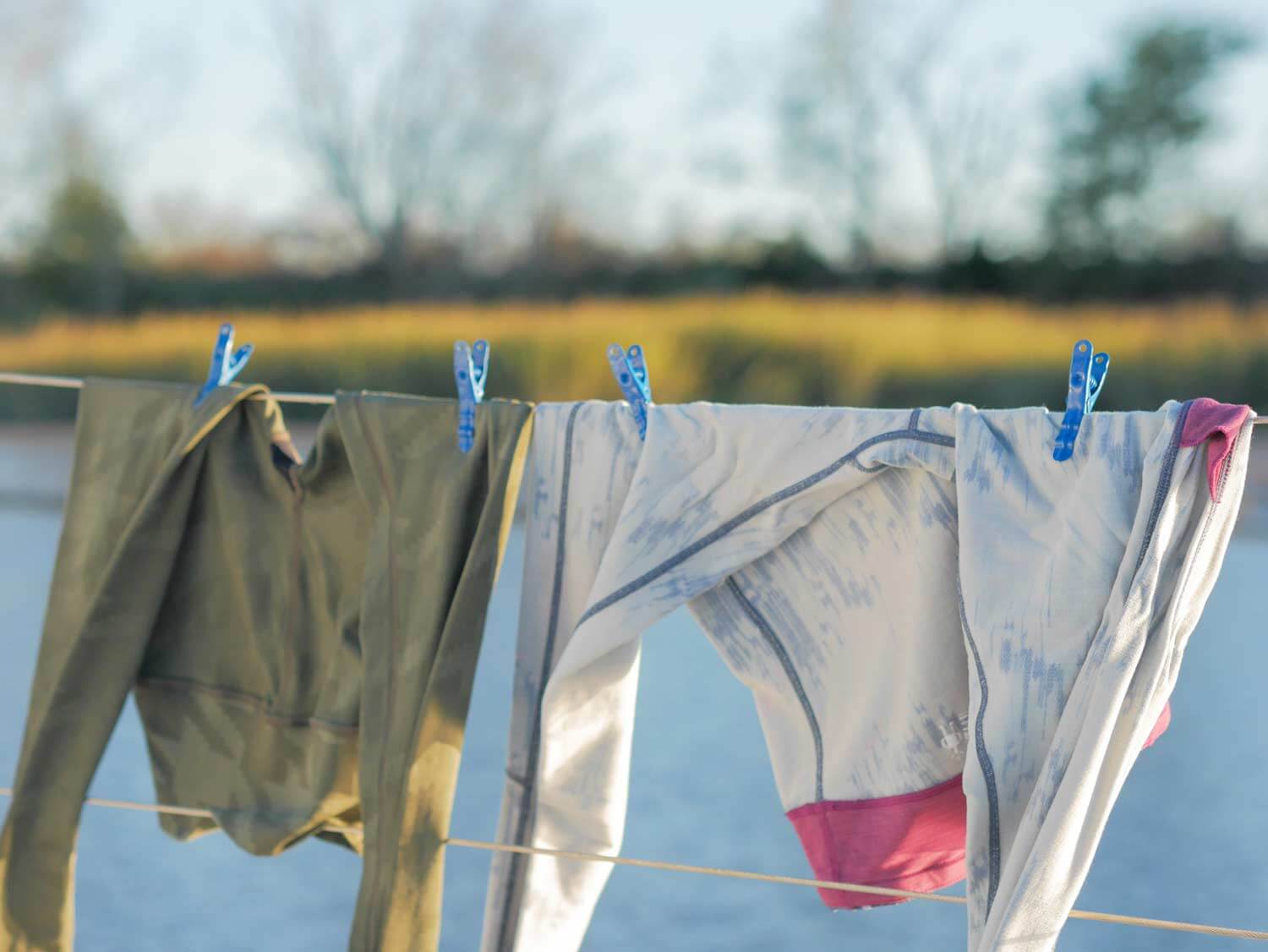
It costs money, and it can take a lot of time to haul your clothes around. Alternatively, handwashing is time-consuming, labor-intensive, and hard on your water usage.
To minimize laundry, you have to think about what you wear and how you wear it.
Summer Washing
In the summer, you can get sweaty just sitting on the boat.
I learned to wear quick-dry items like leggings, swimsuits, and UPF tops I could easily handwash with a small amount of water. If you can stretch the life of your outer clothing, you can clean undergarments and swimsuits in a small collapsible tub.
Winter Washing
Re-wearing clothes in the cooler months is much more comfortable than in the summer months. If it’s not dirty, I don’t wash it. If clothes smell or I’ve been doing boat work, I move them to the dirty pile. Just paying attention to these details reduces laundry. And the less you wash your clothes, the longer they’ll last.
2. Cooking Aboard
There are a few aspects of living on a boat that heavily influence your cooking.
Space. Access to ingredients. Water conservation. Ventilation.

If you only have a small area to prep, you learn quickly to do it in stages. Prepping vegetables, putting ingredients away as you work, and washing dishes as you go is also essential.
Access to Ingredients
Before boat life, recipes were iron-clad when I was cooking. But without the convenience of running to the store, they’ve become more of a guideline. You learn how to adjust recipes based on what you have on hand. You get comfortable substituting vegetables, different spices, and acidity for flavor.
Water Conservation
When off the dock, fresh water is at a premium. How much water you carry (or make) will dictate how you cook.
We do a few things to conserve water in the kitchen . Wash dishes in saltwater first. Use an Aquabot for pressurized cleaning. Cook pasta with a small amount of water. I’ve also embraced one-pot meals to save water on cleanup.
Ventilation
Our catamaran is “galley up,” so it’s easy to open the cockpit window above the stove to release heat and steam. But that’s not always enough.
We use the thermal cooker in the summer to avoid heating up the boat. You can make beans, rice, broth – even casseroles or banana bread without expelling heat in the boat.
READ NEXT: For more tips and ideas for cooking on a boat, check out our lists of easy and versatile meals on a boat and sailboat galley essentials .
3. water usage.
When off the dock, water is a high commodity on a boat.
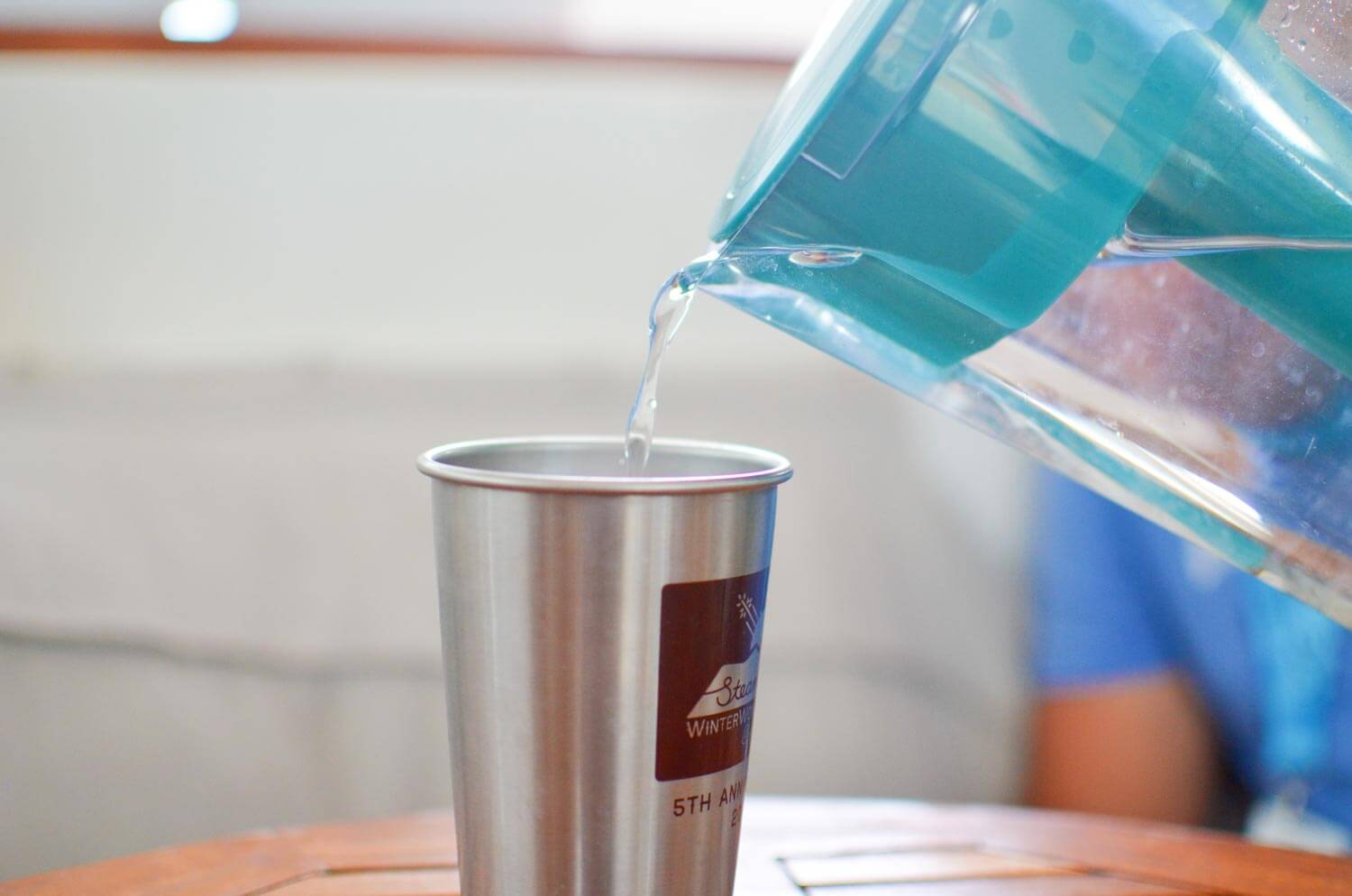
Even with two 80-gallon tanks, water can go fast if you aren’t paying attention.
You can minimize water through small changes to your habits, including:
- cooking pasta with a few cups of water
- swapping soap for hand sanitizer
- rinsing dishes on the sugar scoop
- we even recycle the cat’s stale water in the herb garden
Me, I love hot showers. Just steaming for like 30 minutes, that’s my kind of heaven. So learning to shower with less than a couple of gallons of water was a big hurdle.
Conserving water can be a challenge, but you’ll be surprised what you can save when you use it thoughtfully.
We had days in the winter when we used less than 5 gallons. It just takes a little practice, as with most things on a boat.
READ NEXT: For more tips on conserving water, check out our guide to saving water on a boat .
4. sustainable practices.
When you live in a small space, you realize how many disposable items you are harboring.
When we first moved on the boat, the paper towel storage alone took up half a cabin.
Not only are you losing storage, but those disposable items are just that, future trash for you to deal with.
Ditching paper towels, plastic bags, and other single-use items saves space and money. As a bonus, you get to feel optimistic about creating less trash.
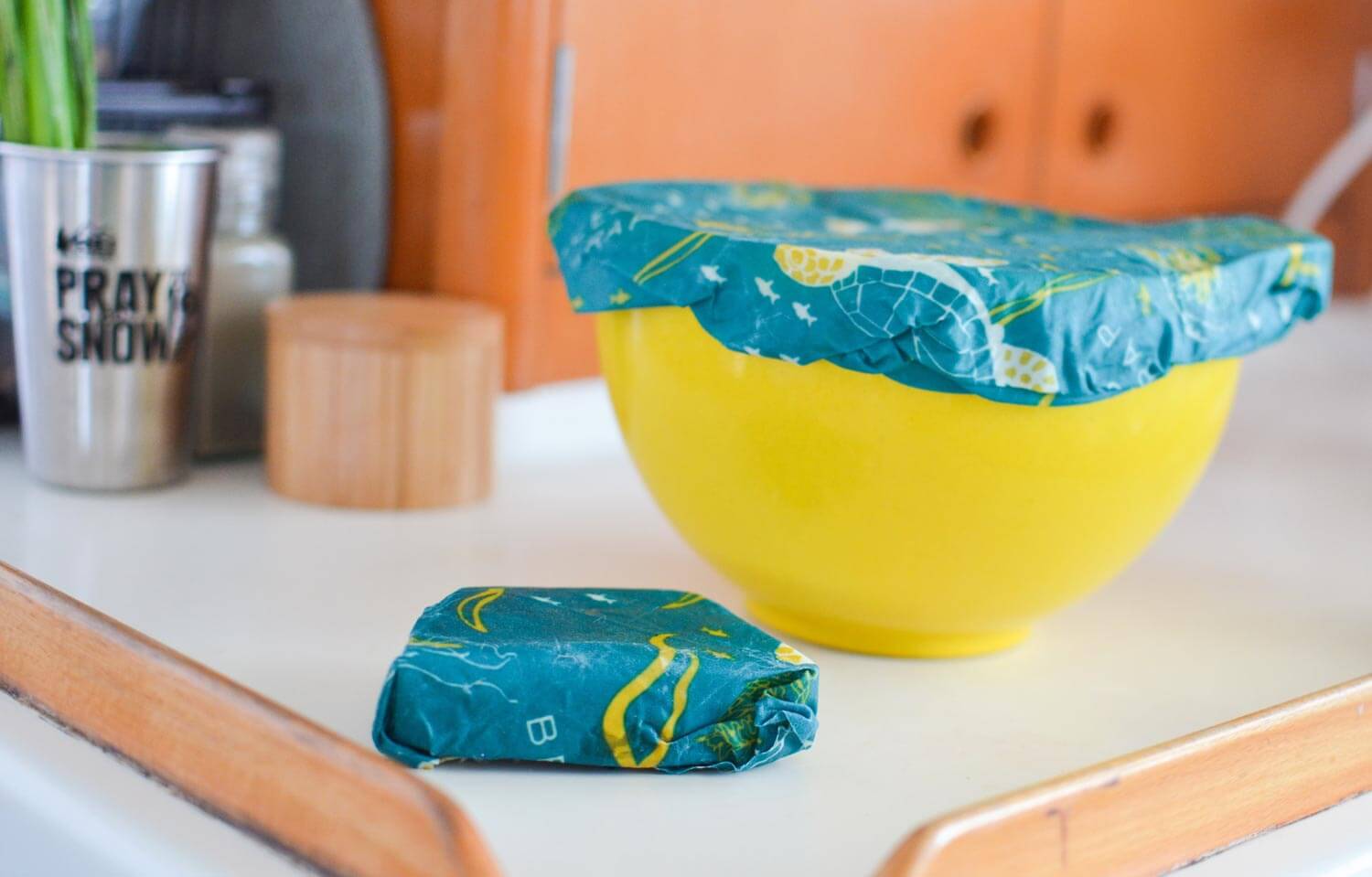
Here are a few sustainable options we switched to:
- Reusable “Unpaper” towels
- Cotton napkins
- E-Cloths, microfiber towels
- Beeswax wraps
- Foldable reusable bags
- Glass straws
- A quality set of plastic containers in various sizes
READ NEXT: Zero Waste Swaps for Small Spaces for more eco-friendly options.
5. fridge space.
The residential fridge. Something I took for granted as a landlubber. A fridge door full of condiments, anyone?
Managing food in a tiny fridge requires strategy and a little education.
Learning what you NEED to keep in the fridge is helpful. Sure, it’s nice to have cold ketchup, but necessary? No.
Sriracha, soy sauce, hot sauce, mustard – out you go.
We also switched to almond milk and tofu brands that only need refrigeration after opening. This way, we can still stock up without loss of fridge space.
The Right Storage
Once the condiment bottles are out, having the right storage makes all the difference.
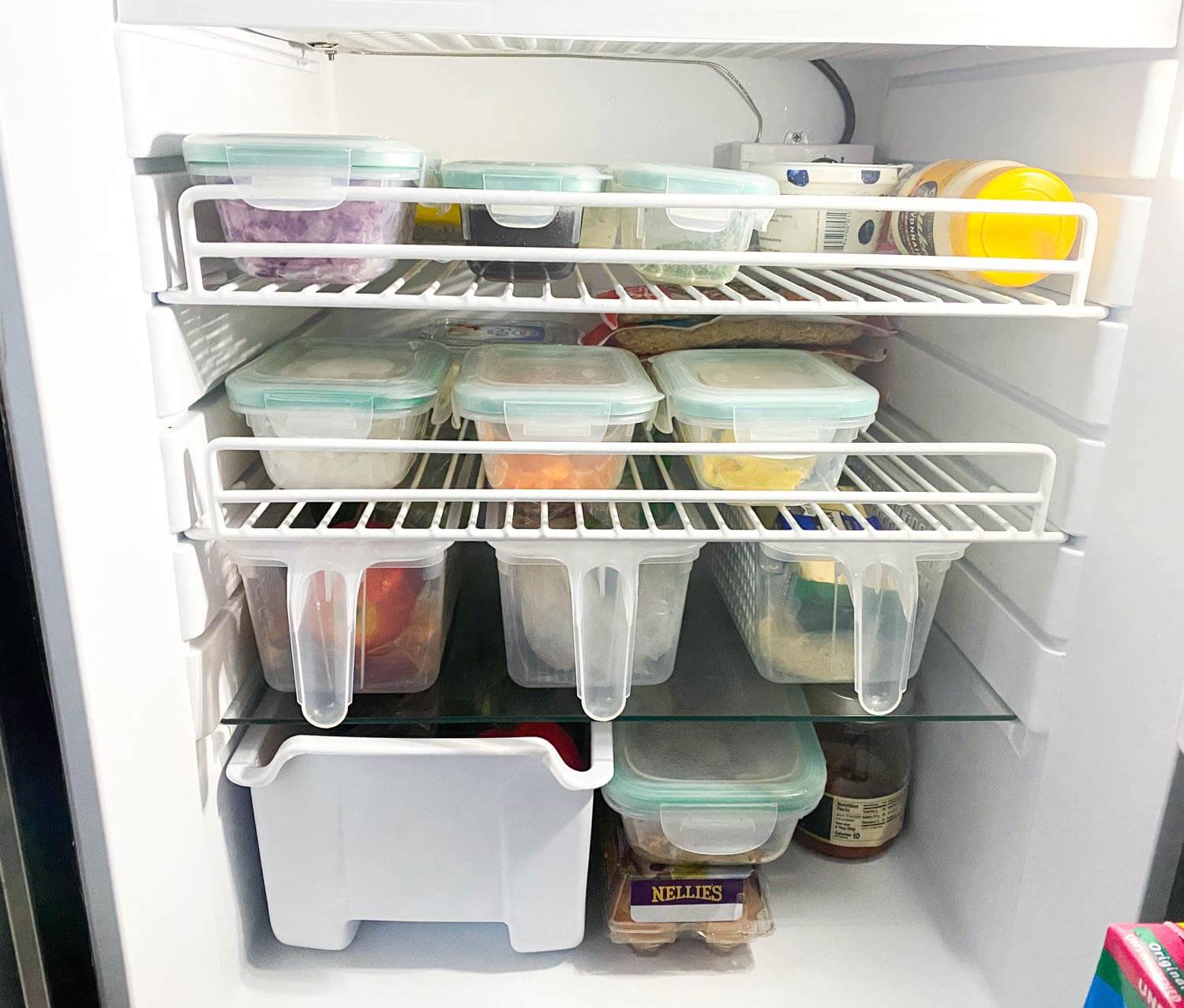
Containers need to be the right size to fit inside shelves on the door and inside the fridge. You want various sizes, so you don’t need to use a huge container if you have a smidgen of something.
Prepping Vegetables
You can save more space by chopping fresh veggies when you get back from the store. Broccoli, cauliflower, cabbage, and hardy greens can all be prepped ahead. I store any scraps in the freezer for homemade vegetable broth .
6. Provisioning
Keeping track of your grocery store when you live on a boat is crucial. You probably won’t be able to run back to the store because you forgot the butter.
Stocking Up
One of the nice benefits of living on a catamaran is the space.
We tend to stock up on these when we can.
- Beans (dried and canned)
- Grains, pasta, oats
- Canned and dehydrated vegetables
- Baking goods and almond milk
- Oils, vinegars, spices, nuts, seeds
- Wine and beer

Most of the time, we are hand-carrying our groceries. So when we have the opportunity to have a car, we load up on heavy items.
When we plan to be at a marina, we have a list ready for Amazon and Walmart.com to have shipped.
READ NEXT: Get a detailed overview of stocking your boat in our Practical Guide to Sailboat Provisioning .
Supplementing fresh food.
We keep a variety of veggies on hand: dehydrated, canned, a little frozen, and fresh. When cooking, I use a little bit of everything to stretch fresh foods.
We have a nice space in the cockpit where we keep potted fresh herbs. They can really step up a dish!

As a bonus, they add to the coziness of the cockpit living space.
7. Downsizing Your Closet
Before I started to plan for boat life, I had a giant wardrobe. I love clothes. And I had been collecting them most of my life.
Believe me, when I tell you cutting my wardrobe down to less than 100 items was a long, emotional process.
A Minimalist Wardrobe
The less you have, the less you need to care for.
Aim for a wardrobe of pieces you love that work for living on the water. It’ll be easy to get dressed, and you’ll be happy in your clothes. And if you are managing your laundry (see #1), you won’t need many clothes.
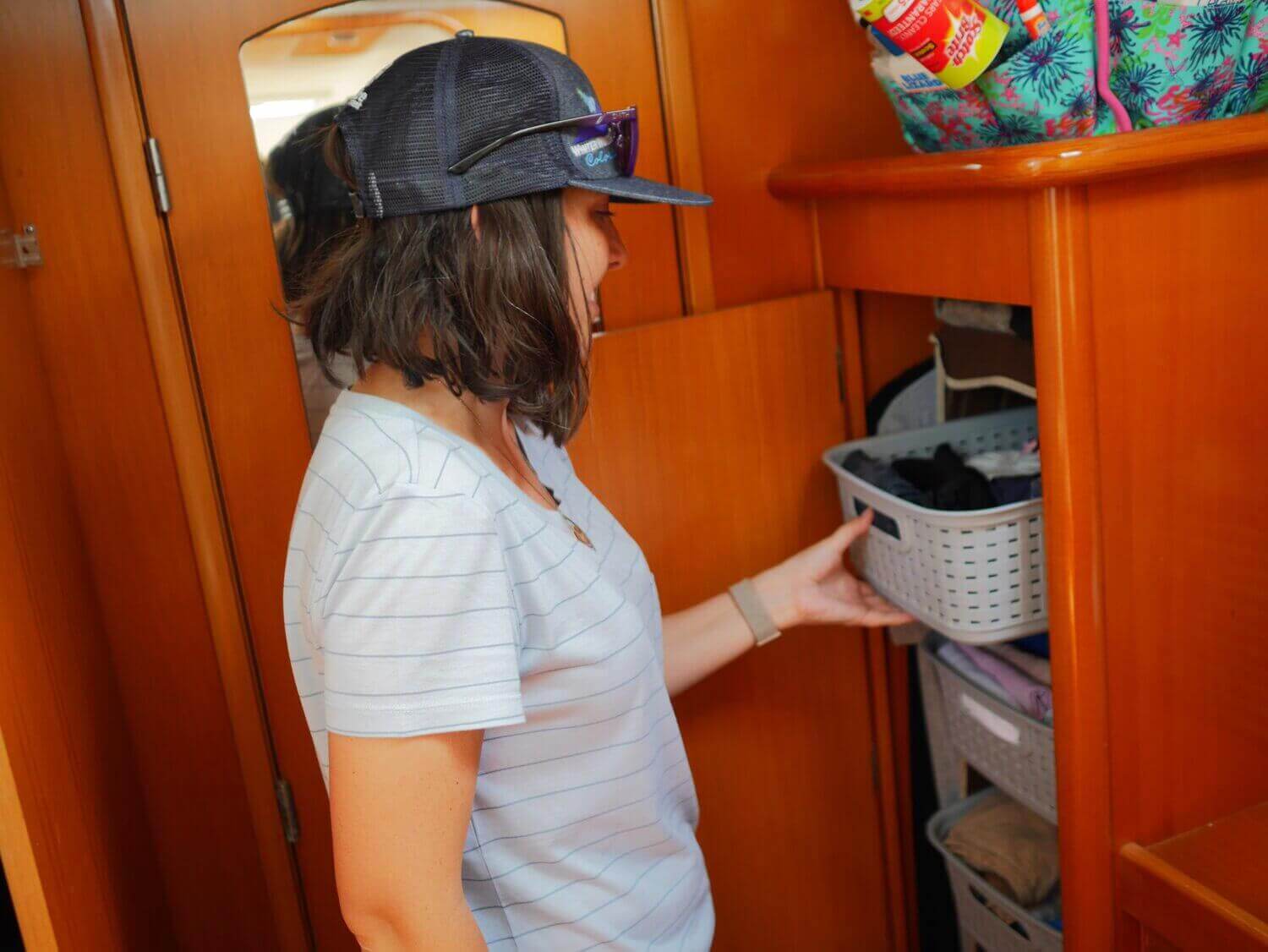
The owners’ version of our catamaran has great storage. I can easily see all the clothing in my wardrobe. I only need to store a few off-season items under our berth.
READ NEXT: For what type of clothing to have on your sailboat, see What to Wear Sailing . Or see How to Downsize Your Wardrobe for more on getting rid of clothing.
8. temperature control.
Spoiler: you don’t have much control of temperature at anchor. And what power you have isn’t as easy as turning the dial on the thermostat.
On a catamaran, you can pretty much open up the doors and hatches on the bridgedeck and get a cross-breeze on a hot day.
I was surprised that Georgia in August (as miserable as it was during the day) was never unbearable at night. We used Breeze Boosters over our cabin, and it worked wonders moving the air around at anchor.
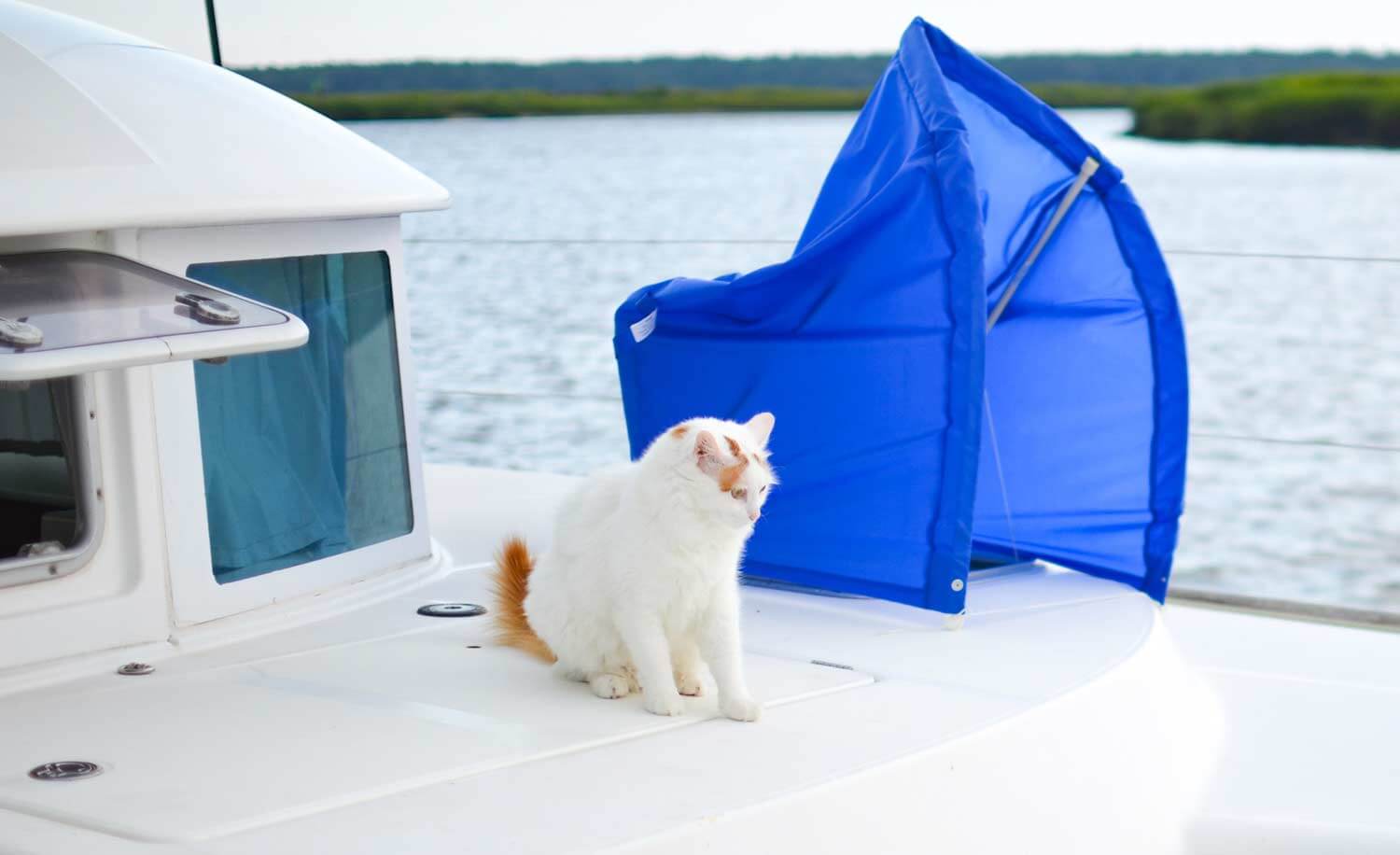
Cold Nights
When it’s cold on a catamaran, you know it. There’s no insulation, and the boat cools down quickly. Below 40 at night is chilly.
Fortunately, if the sun is shining, it can heat the bridgedeck nicely in the morning.
Down blankets, the right clothing, and foul-weather gear will keep you from becoming an icicle.
9. Storing Things
On a boat, you can’t just throw your things in a locker and forget them. Nope.
You’ll need to plan when storing clothing, personal items, and food.
Mold, leaks, and bugs are all things to be concerned with.
Essential oils, bay leaves, vinegar, and plastic bags will be vital to protecting your items.
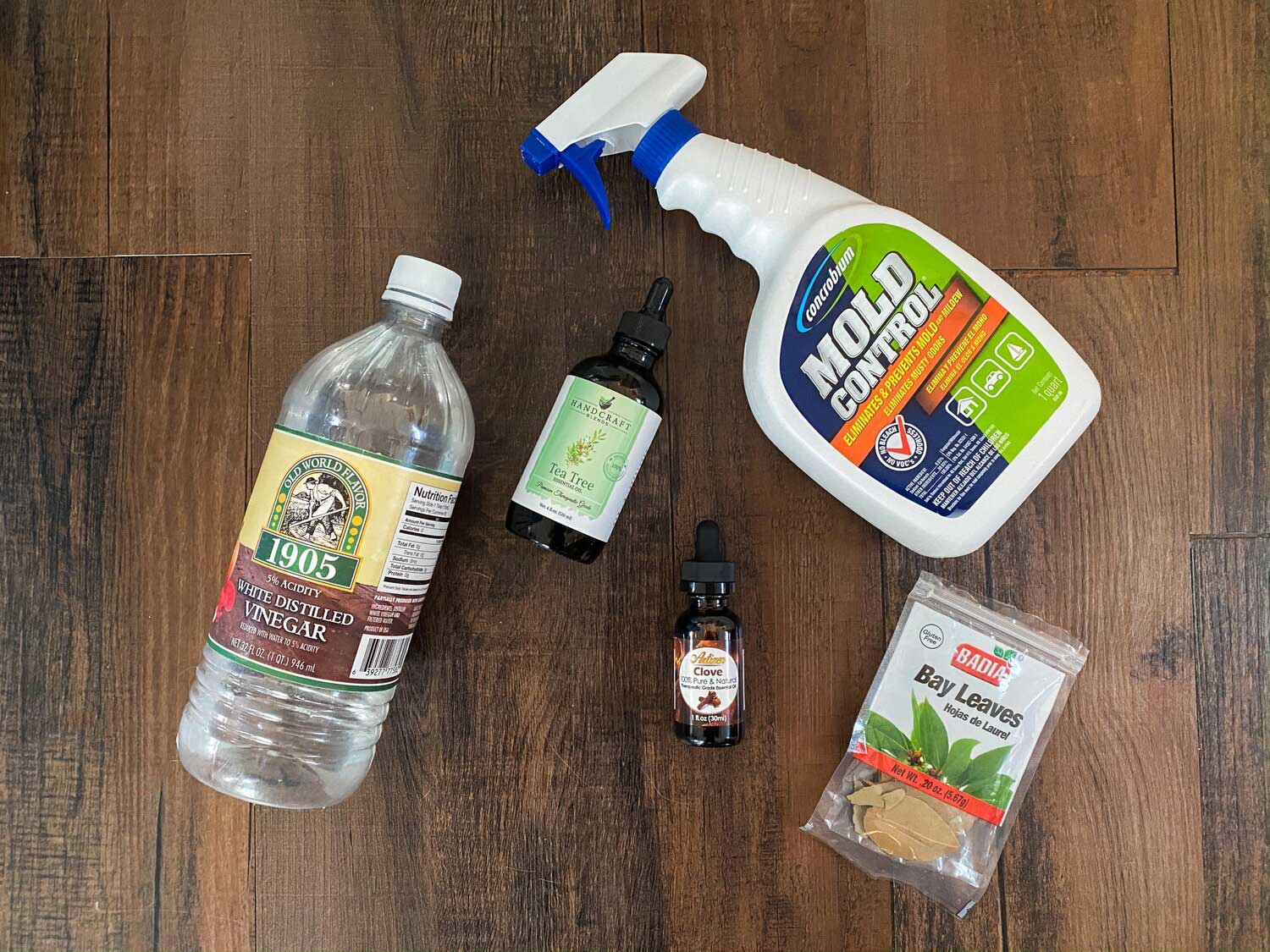
You’ll also need to think about where you store things and how accessible they are. It becomes a bit of a puzzle to make sure you keep items you often use in an easy-to-access location.
READ NEXT: For storage tips, check out Helpful Boat Storage Ideas for Liveaboards .
10. slowing down.
A big part of living happily on a boat is moving at your own pace.

It is being in the mindset of appreciating what you are doing now and not continually looking to the next move.
When we first moved aboard, there was self-imposed pressure we should be moving faster – doing more.
When we finally slowed down and started to embrace the here and now, we enjoyed the boat so much more.
11. Your “House” Breaks (A Lot)
When things go wrong on a boat, they tend to go really wrong.
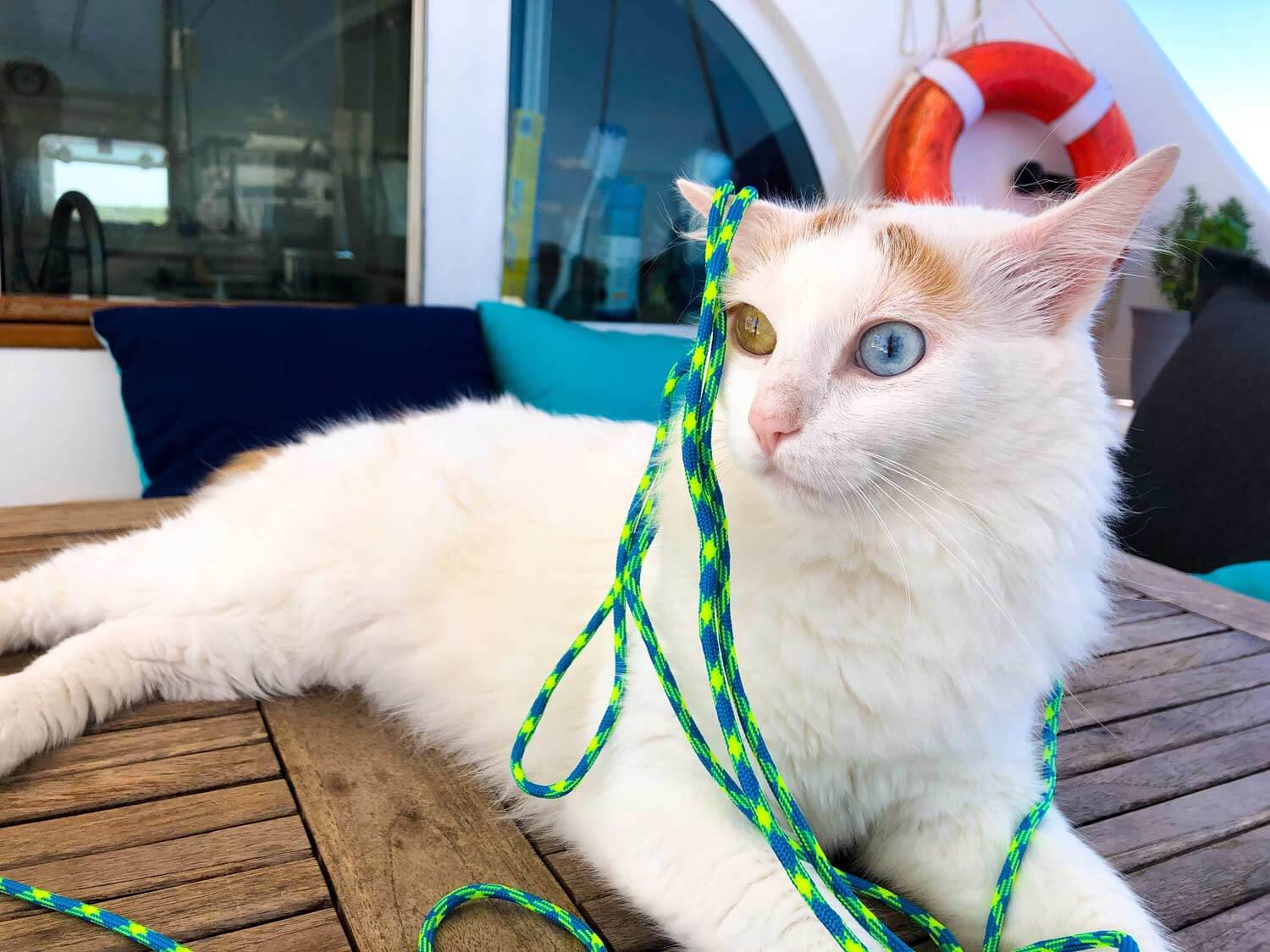
A pro and con of catamarans is there are a lot of duplicates. It’s great to have a backup, but it also means double the maintenance. Two hulls, two engines, two heads… you get the picture.
On the plus side, when our starboard engine broke, we were trying to maneuver through a bridge. We had to turn 260 degrees to turn toward the bridge, but one engine is better than none!
The hardest thing in these moments is keeping your head when everything is against you.
We try to slow down and take a breath if the situation allows. Once any immediate concern is taken care of, we take a breath before diving into solving the greater issue.
12. You Learn to Live Intentionally
Our decision to move on a sailboat was for the rewards of the lifestyle.
One of the most significant rewards is being intentional with space, time, and money.
Living on a boat offers freedom from your stuff. It allows you to live more simply.
On the boat, we get to spend more time with each other. We only have what we need because space is limited.
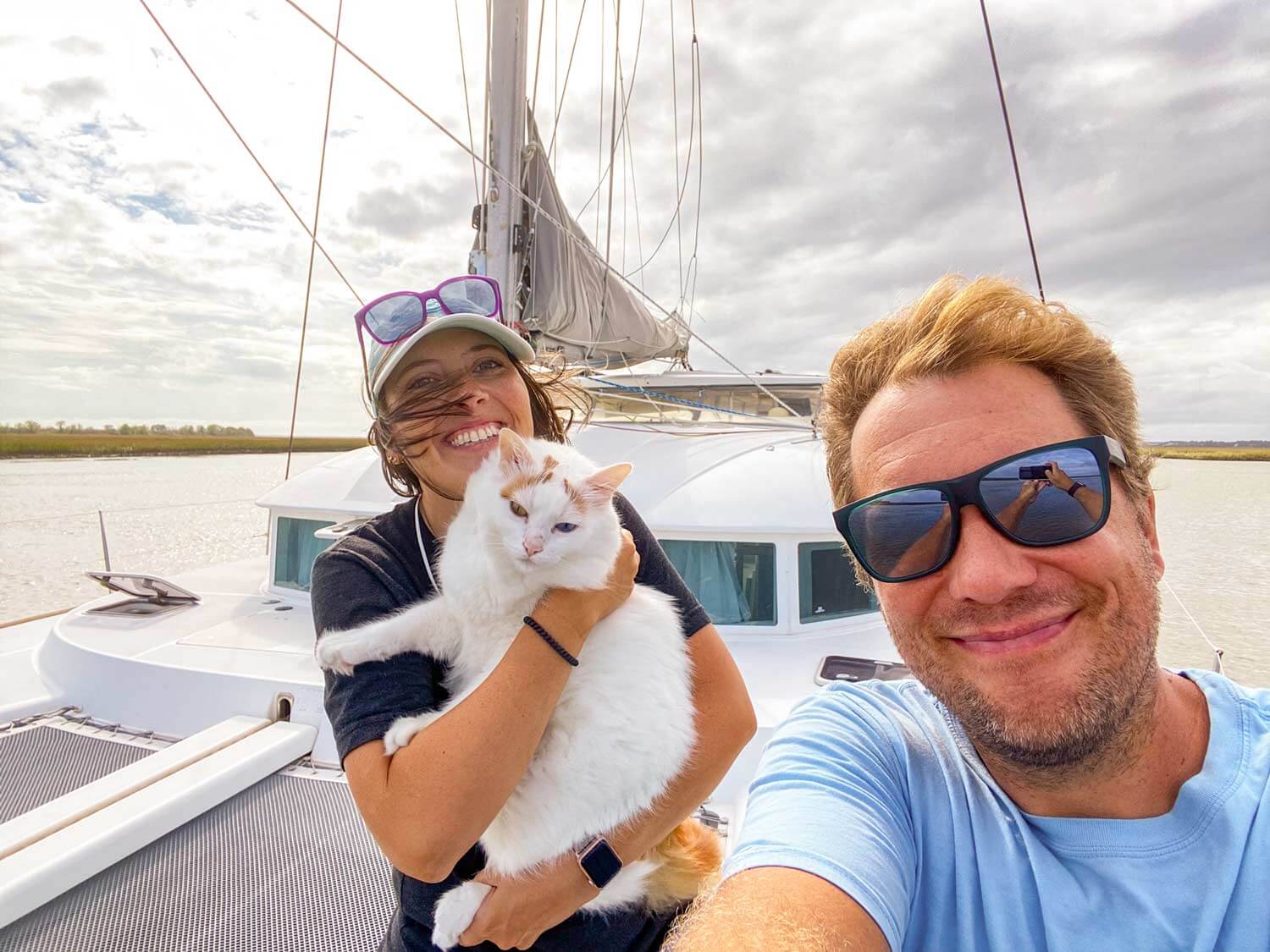
Don’t get me wrong. A boat requires time and money. But we are intentional about how we spend those when maintaining our floating home.
READ NEXT: Our article on the cost of living on a sailboat breaks down expenses by category.
13. appreciation for nature.
Living in the Colorado Rockies for over a decade, it was easy to love the outdoors. But living on the water creates a deeper connection.

You wake up to the water lapping on the boat. The sun dances off the waves, throwing reflections across the cabin.
Walking outside at anchor and seeing the birds hunting for breakfast is a morning routine. And a sea turtle drifting by for a visit is not uncommon. Even relying on the sun for power and the wind to travel is part of the lifestyle.
All these experiences bring you closer to nature and beg you to slow down, breathe, and take it in.
14. Personal Space
It doesn’t matter how much you love your significant other. If you live on a boat together, you will be looking for some “me time.”
When you sleep, eat, shop, travel, and take care of a boat as a team, that’s a lot of togetherness.
How We Find Space
It’s nice to create spaces for personal time in a small space like a boat.
A big plus of a catamaran is you can create a few separate spaces.
We have four main spaces where we spend time: the cockpit, the trampoline, the salon, and the owners’ berth. Ensuring these areas are comfortable and cozy helps us find our own spaces in a tiny floating home.
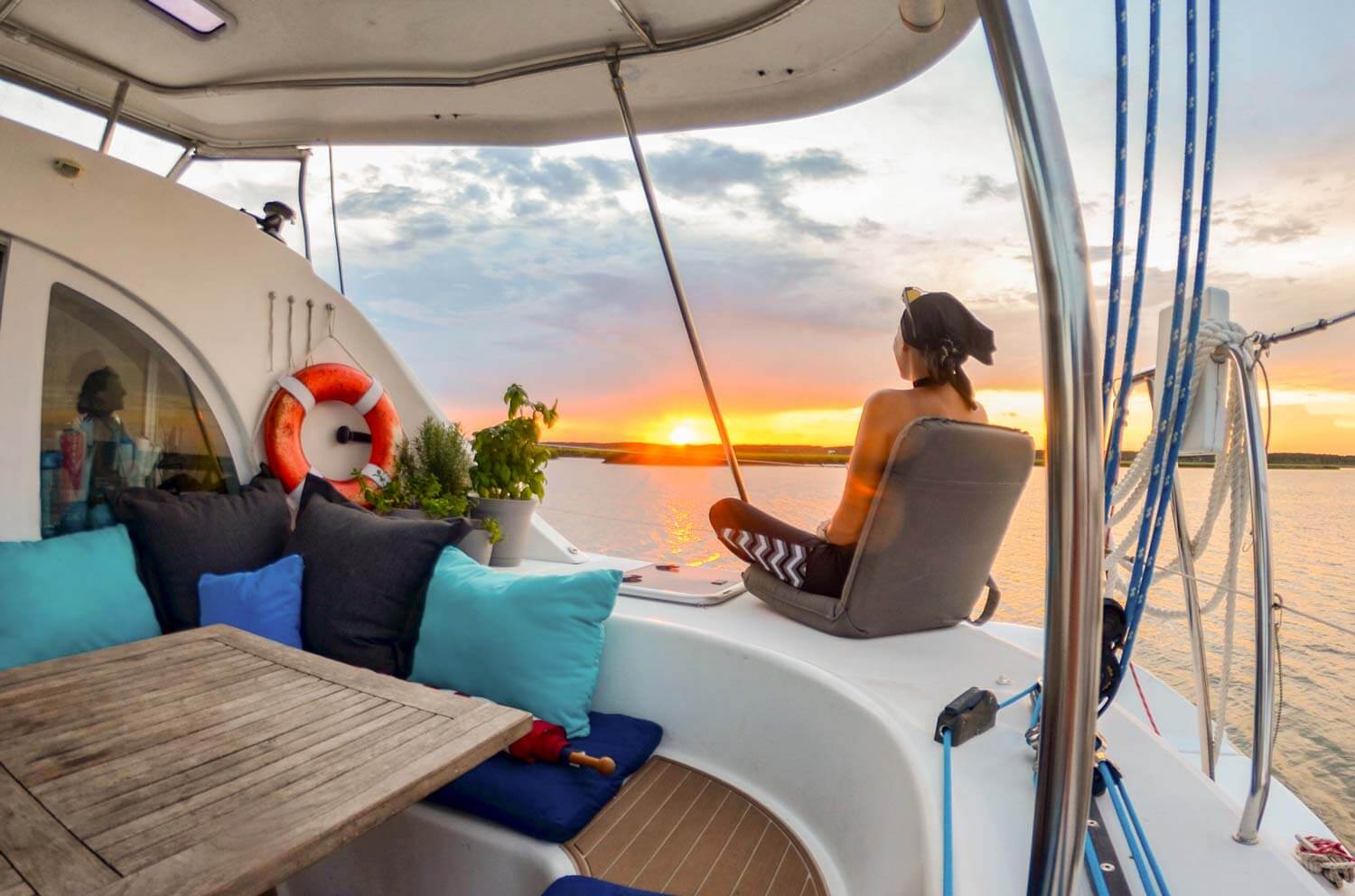
Sometimes, it’s not about physical space but mental space.
I like to have personal time while I’m cooking. It’s something I enjoy, and I can put on my headphones with a show or playlist and tune in while I cook.
Even a quick solo kayak adventure is rejuvenating if we are in a nice anchorage.
15. Minimalism
Embracing minimalism was a change we made going into boat life. But it’s not the typical view of minimalism that has become trendy these days.
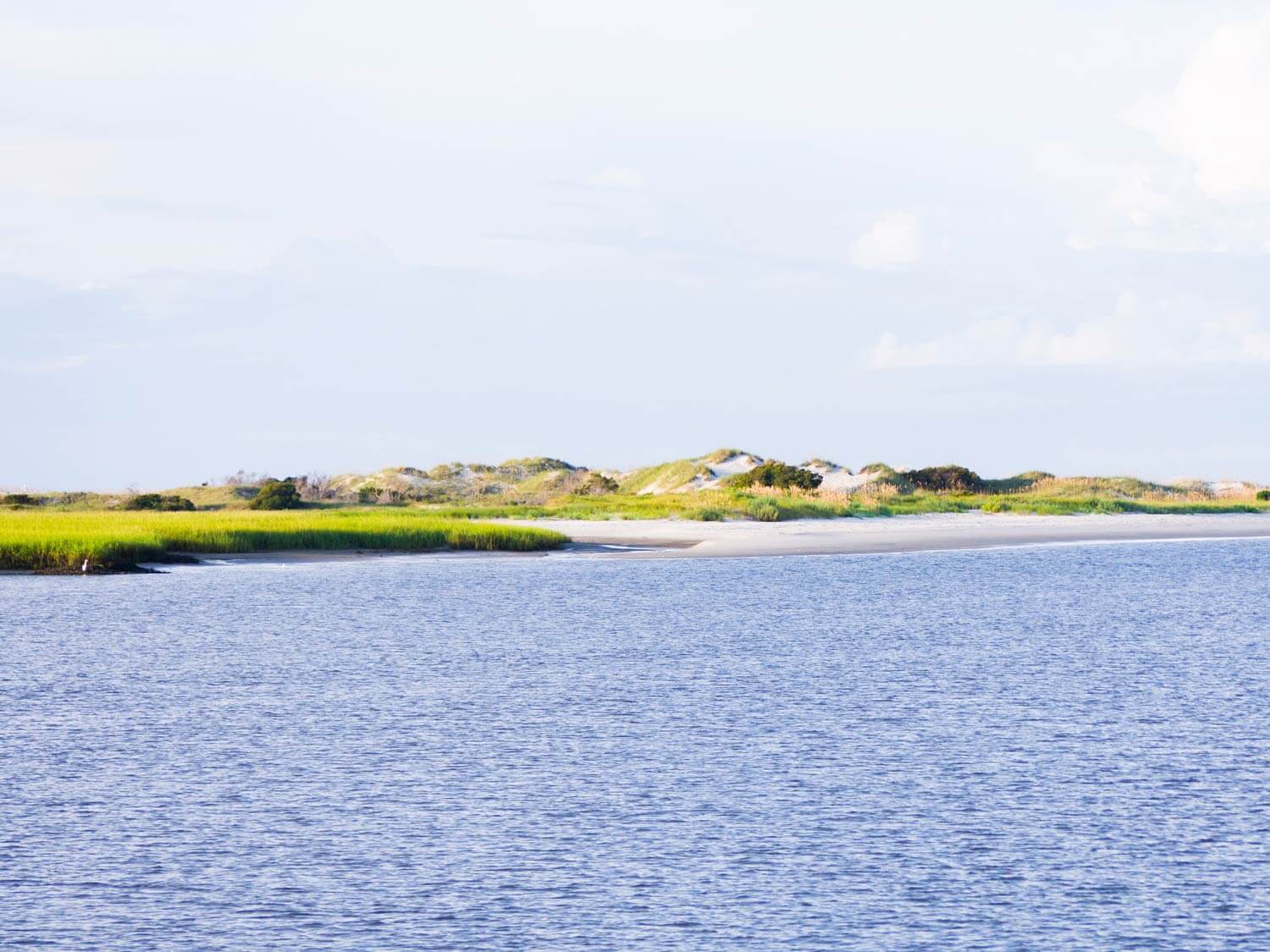
Minimalist Lifestyle on a Boat
The typical “rules” of minimalism aren’t as clear-cut on a boat.
We have a lot of extras when it comes to spare parts and tools. Some parts can be hard to come by, and with two engines, you need double the spares. Not to mention, things never break when there’s a West Marine around the corner.
We also have a lot of non-perishable food and duplicate personal care items. It’s easier to stock up when we have the opportunity. This process keeps our routine shopping to mostly fresh items.
How We Live Minimally
On the flip slide, we don’t have a lot of extra stuff – extra clothes, additional personal items, disposable items.
We don’t have more typical things you would find in a house, such as a dishwasher, microwave, or washer/dryer. We are minimalists with water and power when we’re off the dock.
We aren’t the typical minimalists, but we use space intentionally. And we continue to evaluate our needs based on this lifestyle.
READ NEXT: Check out our full guide on ways to downsize and live minimally .
Can you live on a sailing catamaran.
After a year as liveaboards, many of your daily habits will change. We are still adjusting and finding the best ways to adapt to life on a sailing catamaran.

You lose many conveniences of the modern world, but it’s entirely possible to live without them. It comes down to deciding which comforts are important to you.
How you use space, time and money will shift. You’ll learn to be sustainable, thoughtful, and more self-sufficient.
Living on a boat is a unique experience. No matter how long you do it, it has the power to change the way you live in the future for the better.
Want to learn more about cruising on a boat?
For more on the reality of boat life, the cost of living aboard, and tips for life on the water, view our complete guide.
Like this post? Save it on Pinterest for later.
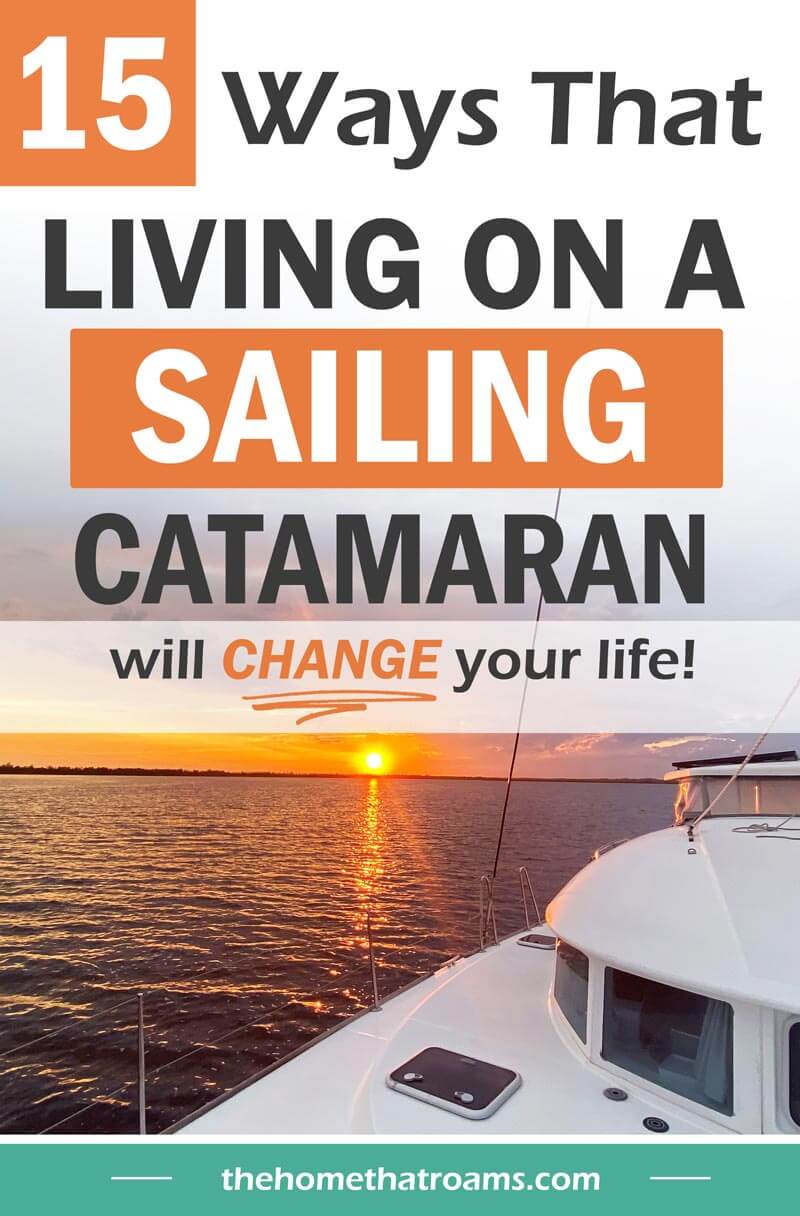
Or view our web story.

Morgan, the founder of The Home That Roams, has been living nomadically for over five years. She began her journey traveling across the U.S. in a motorhome and cruising on a liveaboard sailing catamaran. Currently, she lives full-time in a travel trailer, sharing resources on RV living and boat life to help others downsize their lives and thrive in an alternative lifestyle.
11 Comments
That’s really great post. I appreciate, Thanks for sharing.
Glad you liked the post!
So glad I found this site, looking forward to exploring the rest of it! But here’s my first question, as someone who’s still in the "dreaming" stage: This article tells me that the most basic aspects of day-to-day living are a constant source of concern and effort. Yet there are yachts nicer than most five-star hotels. So what’s the price point (or size point, or whatever point) where your daily concerns don’t revolve around things like do we have enough water to cook dinner and how bad do my clothes really smell? Does frequent marina access solve these issues? Is there a way to live on a boat where it’s easy, or does that only happen in Jimmy Buffett’s songs?
Hi Frank and Lola, thanks for stopping by and asking some great questions! Generally, the number of conveniences onboard a boat directly correlates with the time and dollars needed to have those conveniences. So when you think of the hotel like yachts, also think about the captain and crew and resources it takes to keep them running. It’s the same with smaller yachts. Even when you have the systems, you still have to manage your power or resources to run the watermaker or watch the weather and route plan to get to the marina. This is one reason a lot of boaters opt for fewer systems.
I had to laugh in agreement at your Jimmy Buffett reference – I think Jimmy must be doing a lot of day boating, haha. I personally feel that if you had around a 45-foot cat and a big budget to outfit it, you could have a lot of modern conveniences (watermaker, large solar setup, washing machine, etc.) However, living on a boat is never going to be easy IMHO. You have to put in the effort to live on the water!
I hope this was helpful and didn’t discourage you. My goal is to provide a realistic view of the lifestyle!
Agree. Especially #11. We live on a monohull so only have one head to contend with. Also whatever the purchase price, expect to spend 10% a year maintaining said boat. Things break at the most inconvenient times and improvisation is absolutely key.
Hi Breanna, #11 is definitely a big one! And of course, the head is always interesting. The first time we had a real maintenance issue with the head I posted on Instagram and announced my husband and I’s relationship had officially made it through our first serious head malfunction, haha. As you mentioned, Improvisation is also so crucial! We tend to get pretty creative with solutions 🙂
What entertainment do you use on a long haul, such as books, cards, chess. How do you plan the nights such as sleeping or on watch. Do you use automatic steering.
Hi Stephen, we like Audible for downloading books, I also like to download podcasts. We also use an external drive for movies. We do have and use an autopilot onboard. We don’t have experience with long passages, but The Boat Galley has what I think is a great article on the subject, you can find it here! https://theboatgalley.com/passagemaking-and-sleep/
Thanks for such an informative post. We’re in the process of buying a 42ft catamaran and plan on sailing up the east coast of Australia next year…scary and exciting!
I see that in some of you photos you have a gorgeous looking cat 😊 I’m planning on taking our 6 year old cat with us on the trip. Do you have any tips and advice on how to make life more comfortable and safe for a cat onboard and how to get them acclimatised to boat life?
Any advice would be much appreciated.
Thanks, Dee
Hey Dee, this is so exciting! I’m sure there’s lots of planning and preparation in your future but in a good way 🙂
I have a post about sailing with cats that you can find here – https://thehomethatroams.com/blog/cat-on-a-boat/
But in general, I would say to take it slow and keep a close eye on them in the transition period while they’re testing their limits. Our cat is good at finding any open compartments, so when you’re working on things or storing things, make sure they don’t slip in! You will probably want to use a life jacket in the beginning at anchor, as well as keep a good eye on them until they become more comfortable. The top of the bridgedeck seems to be a favorite spot for cats since they can see so much from up there!
Best of luck on your new adventure! – Morgan
Wow. Thanks for sharing your experience. Unfortunately, not all people experience that, so we must enjoy every second. Nice post!
Leave a Reply Cancel reply
Your email address will not be published. Required fields are marked *
Sign Me Up!
Learn how to live on a boat.
Get weekly tips on how to start traveling full-time on a boat.
View our privacy policy .
Privacy Overview
| Cookie | Duration | Description |
|---|---|---|
| cookielawinfo-checkbox-analytics | 11 months | This cookie is set by GDPR Cookie Consent plugin. The cookie is used to store the user consent for the cookies in the category "Analytics". |
| cookielawinfo-checkbox-functional | 11 months | The cookie is set by GDPR cookie consent to record the user consent for the cookies in the category "Functional". |
| cookielawinfo-checkbox-necessary | 11 months | This cookie is set by GDPR Cookie Consent plugin. The cookies is used to store the user consent for the cookies in the category "Necessary". |
| cookielawinfo-checkbox-others | 11 months | This cookie is set by GDPR Cookie Consent plugin. The cookie is used to store the user consent for the cookies in the category "Other. |
| cookielawinfo-checkbox-performance | 11 months | This cookie is set by GDPR Cookie Consent plugin. The cookie is used to store the user consent for the cookies in the category "Performance". |
| viewed_cookie_policy | 11 months | The cookie is set by the GDPR Cookie Consent plugin and is used to store whether or not user has consented to the use of cookies. It does not store any personal data. |


11 Amazing Spots Around the World to Liveaboard a Boat (With Pictures)

As an Amazon Associate, we earn from qualifying purchases. We may also earn commissions if you purchase products from other retailers after clicking on a link from our site.
Living onboard a boat in the Caribbean was something I really enjoyed; there was a type of simplicity to life. Make no mistake living on a boat is very different from living on the grid and takes a lot of hard work.
But the upsides are big, fewer distractions from the intense life on the grid and quality time with the people on your craft!
In this article, I have put together the 11 most exciting places worldwide to live aboard your boat. I have looked at factors such as money, but this is mainly a text focusing on the more exciting examples.
If you want to know more about liveaboard here in Florida , then I recommend you read this article that I have created
Table of Contents
11 Most Amazing Spots in The World to Liveaboard a Boat!
This list intends to inspire you and give you some ideas of where you might possibly spend your days in the future. Since taste is an individual preference, I have not listed them in any order; they are all exceptional places!
As you will also see, this list only contains warm-weather spots; if you’re into the cold stuff, then this is not for you 😉
1. The Bahamas

Although the Bahamas might not be the perfect place to liveaboard, it almost didn’t make the list since it’s very secluded and more suited for traveling through than a place to live.
But having a list like this and not mentioning world-famous cruising grounds like the Exumas or Bimini Island wouldn’t be fair.
I loved sailing in the Bahamas; it is the perfect mix between being isolated and still being able to get help if something happens.
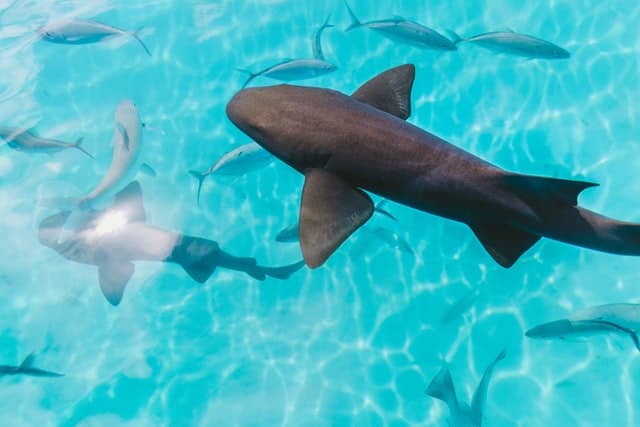
And speaking of the weather, it’s incredible almost year around. The wind blows from the east with a steady breeze, which is just perfect since the islands stretch from north to south, making it possible to travel in every direction almost any day.
The Bahamas even has this weird island where, supposedly, a long time ago, there were pig farmers, but the farmers have moved off the island, and all that is left are the pigs.
And I’m talking giant pigs that, when you close in on the island, will jump in the water and swim up to your boat to get some food.
Give them food if you want to, but if you are in a dinghy, they will try to get on board, and some of the people we met told stories of pigs even puncturing dinghies.
2. Miami, USA

This one is a little odd; Miami per se isn’t a cruising area, even though the Florida Keys are around the corner. But the cool thing with Miami and Miami Beach is that there are multiple places where you can anchor for FREE! This means you can bring your boat and park it in the water next to buildings worth millions of dollars.
It’s like having a two-bedroom apartment in Miami Beach. Get dressed and dinghy off to dry land and enjoy everything that Miami has to offer, all within walking distance!
Even though I said that the anchorage is free, Miami Beach is definitely not, so in the long term, you won’t save any money in Miami.
And once you are tired of the beach, head on over to Boca Chita or any other of the small islands of the bay. Make sure you bring bug spray, but don’t worry about music; there will be plenty of powerboats supplying more than you would ever need.
3. Mallorca, Spain

I have spent a lot of time here, my mom used to live here with my dad, and we would come here every year. The island is impressive, a small gem in the Mediterranean.
High mountains are combined with crystal clear water and marinas everywhere. You want to enjoy the big city hustle of Palma Nova or cruise around the island and stop for an espresso at Port de Soller.
If you’re a trail runner like me, then you will have plenty of mountains to explore; there is a 110 km long trail on Serra de Tramuntana, which I can recommend that you make day trips along.

Renting a car and traveling the island is cheap; it will take you a day or two and is perfect for when you’re tired of the sea.
I would say that Mallorca is reasonably priced, considering its location in Europe and being a very popular place with tourists.
4. Cape Town, South Africa

Cape Town was something that surprised me; South Africa, in general, offers incredible diversity. Not only in the political realm but in nature, in cape town, you will see everything from the fantastic table mountain to the great white sharks.
You can head up to the Kruger national park and see lions, elephant rhinos, and all types of cool animals. , I would suggest you take a road trip through this wonderful country.

South Africa might have a bad reputation regarding safety, at least in my home country of Sweden, but I found it to be just like many other places in the world.
There are places you should go to, and there are places you definitely should not. All of this information is easily accessed by asking the locals.
The locals are friendly, and just like any other country, you must listen to their advice to stay safe.
Other than that, South Africa is free to explore, and I definitely think you should!
5. Cartagena, Colombia
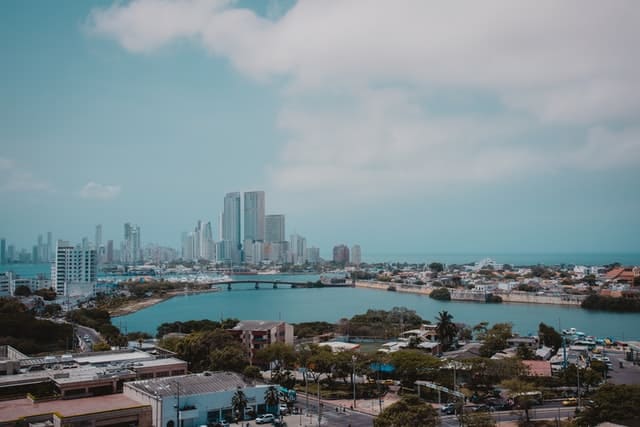
Colombia is one of my absolute favorite countries; not only is there a lot of salsa and good food. The people living in Colombia are the friendliest I have ever met.
The city of Cartagena is a little bit of a tourist trap, but once I had spent some time there, I started to like it more and more.
The old town of Cartagena is amazing, with a lot of activities and ancient castles. Whether you’re ready to party or chill out at the beach, Cartagena has something for you.
Since Cartagena is located on the Caribbean coast, there are a lot of “reggae” culture and vibes along the beaches that surround the area.

And if you’re in Colombia, you should definitely visit some more places like Medellin, Cali, or the remote and beautiful mountains of Nevado del Tolima.
And make sure you talk to the locals; they have a great history, and many are eager to share stories about the new Colombia. I believe Colombia will be one of the world’s biggest attractions in a few years.
There are many marinas available in Cartagena , and they are reasonably priced. Most people during transit will just anchor outside, but for a more extended stay, that will probably be pretty tough since the.
There are water taxis, powerboats, and jet skis all over the place. But once you get inside the marinas, it’s all nice and quiet.
6. Southern Thailand

I first went to Thailand when I was around twenty years old; we actually flew to the wrong airport, which kind of made us a little confused in the beginning.
But the good part was that we landed in an amazing part of Thailand where most tourists don’t go. From Krabi, we took a boat to the island off the west coast named Koh Lanta, which became our home for the coming month.
The area around Koh Lanta is full of small islands, beautiful weather, and amiable people. I can recommend getting your divers license in Thailand, it is cheap but far more critical; the diving will be something that you never forget.

The province of Krabi, where Koh Lanta is situated, is also the home of Rai Leh, a real sweet spot for those who like to climb or do other outdoor activities.
You might have also heard about the island of Koh Phi Phi, where the movie The Beach was filmed back in 2000. Phi Phi Island is a special place; the diving is fantastic. If you’re into partying, this is also an excellent place for that.
But the most extraordinary thing is, in my opinion, is the sailing, the Clearblue water, and the sensation of being at 20 m of depth surrounded by 80F water is something special!
Living in Thailand is cheap, and cruising is terrific.
7. Tasmania, Australia

Although being a pricy place to stay, Australia has some well-known sites well worth the price tag. One such place is the island south of mainland Australia called Tasmania.
Tasmania is a cruiser’s choice, especially in the southern part of the area of Hobart; here you will be able to see dolphins, whales, and other animals of the sea.
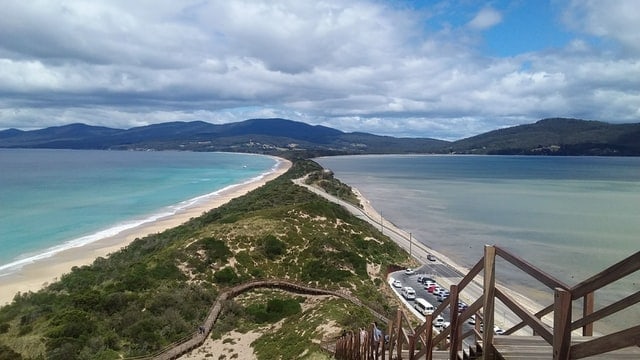
It is also a place for finding your very own secluded beach, maybe a place to beach your catamaran and explore a deserted island. I also have a guide on how to live on a catamaran .
Most of the islands are also very protected, which can be a nice change of pace if you recently came here overseas.

Croatia is one of the most famous destinations for sailing vacations around the world, and this is for a good reason. With over 1000 islands, there are plenty of places to sail around and discover.
Although wintertime in Croatia is not like the Bahamas, you will still be able to enjoy the cooler weather if you prepare yourself and the boat properly.
Many say Croatia is the French Riviera during the 50s, unspoiled and full of opportunities for quiet anchorage even at high season.
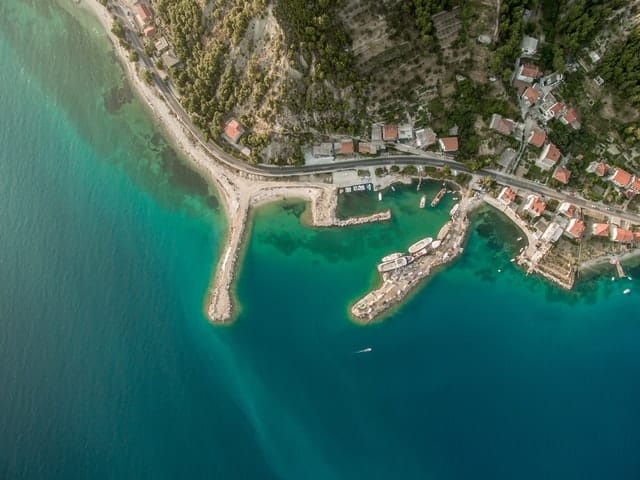
Sailing in Croatia is mainly about anchoring in the free, but there are also some marinas in Dubrovnik, Trogir, and Split worth spending a night or two in.
I would argue that the best month is in September, this is when most of the tourism has died down, but the weather is still great, which means you have all those islands to share with a lot fewer people than during the high season.
Staying in Croatia also gives you access to the entire Mediterranean Sea.
9. Southern Bali, Indonesia

Bali is nothing special, but at the same time that it is truly amazing, yes that sounds a little bit counterintuitive, but you’re looking at a list of the 11 best places to live on a sailboat, and all the places are amazing 🙂
So what I mean is that Bali is a place to sail and live where you will enjoy beautiful beaches and a lot of sun.

But you won’t really find that special thing that some other places have, like the Bahamas with the perfect wind in relation to the islands, or The British Virgin Islands with its perfect set up for cruising.
10. The British Virgin Islands

I wasn’t supposed to include this on my list, but then I changed my mind, just like the Bahamas; this just needs to be on here.
BVI is probably THE most popular of all cruising grounds; it is the best combination of proper infrastructure and the ability to disappear to a remote island for some time of your own.

The weather is stable most year-round, except during hurricane season, of course. Since sailing infrastructure is so good, you will find marinas everywhere, and most of them are safe and secure from the weather.
You will find sun-soaked beaches in abundance, shipwrecks to dive on, and theme bars all over, this is combined with the French Caribbean cuisine, and you have the recipe for success.
The BVIs took a hard hit during Hurricane IRMA in 2016 but have since started returning to their previous glory with many volunteers helping out to remove rubbish that was blown into the sea and onto coral reefs.
11. Whitsunday Islands, Australia
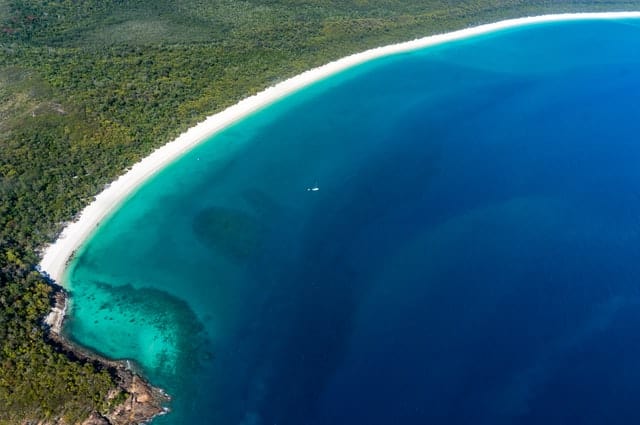
Most people know of the great barrier reef, but not all have heard of the Whitsunday Islands. Being a chain of 74 islands, it’s the closest to the Caribbean, you will get on this side of the world.
As often common in Australia, there’s an abundance of wildlife, sunny beaches, and see-through water making it the perfect spot for snorkeling.

And since there are only four of those islands that offer resort accommodation, the area is much less developed than those in the med.
A fun fact is that Whitehaven Beach is 98 percent silica, which makes it incredibly white, and some say it’s the most beautiful beach in the world, but I’m not so sure.
What are The Worst Places to Live onboard a Boat?
I would definitely say that any place that is cold and rainy . Livin on a boat, especially if it is a small one, makes the outdoors your living room, which is fantastic when the weather is good, but it would suck if it were to snow in my living room 🙂
I would also say safety is a big concern, I wouldn’t want to live in a place where I wasn’t reasonably safe, and I say “was” not “felt.” On many of my trips, I have come back home only to find myself surprised that I’m alive; for example, people still think Colombia is very dangerous; it’s not, and neither is South Africa if you travel smart.
What is a Good Liveaboard Boat?
The right liveaboard boat is something that is big enough to ensure you have all the creature comfort that you need but is small enough so that you can afford the costs.
Can You Live on a Boat in a Marina?
In most places, yes, but some countries or marinas will not allow people to live on their boats in the marina. Such was the case when we were fixing the hole in our hull in Miami.
What are The Benefits?
There are some nice benefits, life gets simple, not easy, but straightforward. No phone connection means you cant google stuff and get notifications from Facebook or ads.
You become very close with your crew, and you will get to know them and yourself in a more profound way.
What Are The Downsides?
I would say the constant work on the boat; there is always something that needs to be fixed and something that needs to be planned for. If you are stationary in a marina, this is not much of a thing.
But if you’re a sailing liveaboard, everything breaks, all the time 🙂
General Rules For Liveaboards
You really have to get in contact with the marina that you want to live on; many places don’t accept people living on the boat full time.
I have also excluded any price figures in the text since it varies greatly depending on what you are looking for, how long you’re staying etc., but the general guideline is that the longer you stay, the cheaper it gets.
If you’re planning a winter liveaboard trip , I’d be happy to share some helpful tips.
Also, make sure you stay in a well-protected marina with minimum swells coming in; I would recommend that you choose a marina to try for a month until you commit to something longer.
Make sure you have the right papers; this includes Visa, work permit, etc.
Owner of CatamaranFreedom.com. A minimalist that has lived in a caravan in Sweden, 35ft Monohull in the Bahamas, and right now in his self-built Van. He just started the next adventure, to circumnavigate the world on a Catamaran!
Leave a Reply Cancel reply
Your email address will not be published. Required fields are marked *
Save my name and email in this browser for the next time I comment.
Recent Posts
Must-Have Boat Gear for Catamaran Sailors!
Sailing is probably the most gear-intensive activity I've ever done; there are so many decisions to be made about what gear to buy now, for tomorrow, and what to definitely never buy. The gear on...
6 Best Trailerable Trimarans For Bluewater and Coastal Sailing
Having a boat costs a lot of money, even when you are not using it, marina fees, etc. And once it is in the water most sailors never go very far from their "home marina" and sailing will be somewhat...
Editor's Choice
- Latest Articles
- How to Move Out of the U.S.
- Daily e-Letter
- All Destinations
- Best Places to Retire
- Our Experts
- Testimonials
- Real Estate
Retirees Sail the Caribbean for 8 Years On a $1,000-Per-Month Budget

The first time Gary Pierce and his wife Julie took a four-hour sailing cruise in the U.S. Virgin Islands, they knew they wanted to retire on a boat in the Caribbean . But could they do it with no experience and limited funds?
They lived 90 miles from the Gulf of Mexico – so learning wouldn’t be easy or convenient.
And they didn’t have a fortune to spend on buying a sailboat - or on heavy month-to-month expenses once they began “island-hopping” in the Caribbean.
The good news is, Gary and Julie discovered that learning how to sail, buying a sailboat, and cruising from island to island isn’t as difficult – or expensive - as they once believed.
In fact, they wound up spending eight full years sailing the Caribbean on their own boat, without any major problems, and spent only $1,000 a month to do it – all in first-class style.
In the May 2011 issue of International Living Magazine, Gary reveals what it’s like to cruise the Caribbean full-time. And he provides practical tips for anyone who, like he and his wife, has dreamed of retiring on a sailboat in the Caribbean, but always left that dream in the realm of fantasy.
“We spent 90% of our time swinging on the hook at some of the most beautiful anchorages on Earth,” Gary writes in the May 2011 issue. “And it’s so inexpensive. Once we were on the boat in the Caribbean, we spent around $1,000 a month.”
How did they live on $1,000 a month? Here are some of Gary’s money-saving tips.
“We copied the locals. In Venezuela, the local bus cost 7 cents. You can share a cab with a few other sailors to take island tours and go to the weekly farmer’s market. We found local doctors and dentists were excellent, and that the only difference between them and U.S. doctors was the price. You can eat most meals onboard and anchoring is free.”
What about the cost of buying a sailboat?
Well… although Gary paid $118,000 for his 36-foot boat, Shadowtime, he says it’s possible to own your own sailboat for much, much cheaper.
“We saw several 20- to 25-foot boats that had been sailed safely all the way from Europe. These boats can be purchased for $10,000 to $25,000.”
How do you gain the necessary experience to become a full-time sailboat captain? Here’s what he suggests.
“To get started, read everything you can get your hands on about sailing and cruising. Hang out at the docks and marinas and go day sailing. Someone offering day sails would probably charge $20-$30 per person.” Gary also suggests taking sailboat vacations to learn more. “This is called crewed chartering, where you can sail the boat under the watchful eye of the captain.”
Volunteering as crew is another way to gain valuable sailing experience. “Once you have a little experience,” Gary writes, “you can offer your services in return for food and on-the-job training aboard someone else’s boat.”
Finally, once you’ve mastered some skills, you can do what’s called bareboat chartering. In other words, you rent a boat and you’re the captain and cook! “A 32-foot boat for a week will cost $1,500 in the summer and $3,000 in the winter months.”
Even though Gary and Julie were careful with their funds, they discovered they could still enjoy a luxurious, exotic lifestyle.
“We especially enjoyed being anchored off fancy resorts that charged $500 a night. We paid zero and had a much better view, without noisy neighbors. During the day we would go ashore to these resorts, using our dinghy, and wander the grounds and enjoy the amenities for free.”
Gary’s a firm believer that anyone can retire on a sailboat in the Caribbean – regardless of experience or budget. “The biggest obstacle to people enjoying this dream is thinking that you have to acquire more nautical knowledge, a larger boat, or more money before you go cruising, “Gary writes.
“My advice? Take the boat that you have and go. The longer you wait, the more your current lifestyle will tell you that you cannot do this. You can. Listen to your dream if retiring to a sailboat is what you want.”
Related Articles
5 Best Caribbean Islands to Live On and 2 to Avoid
Tulúm, Mexico: Retirement, Cost of Living and Lifestyle Information
Ambergris Caye, Belize
- Bear's Books
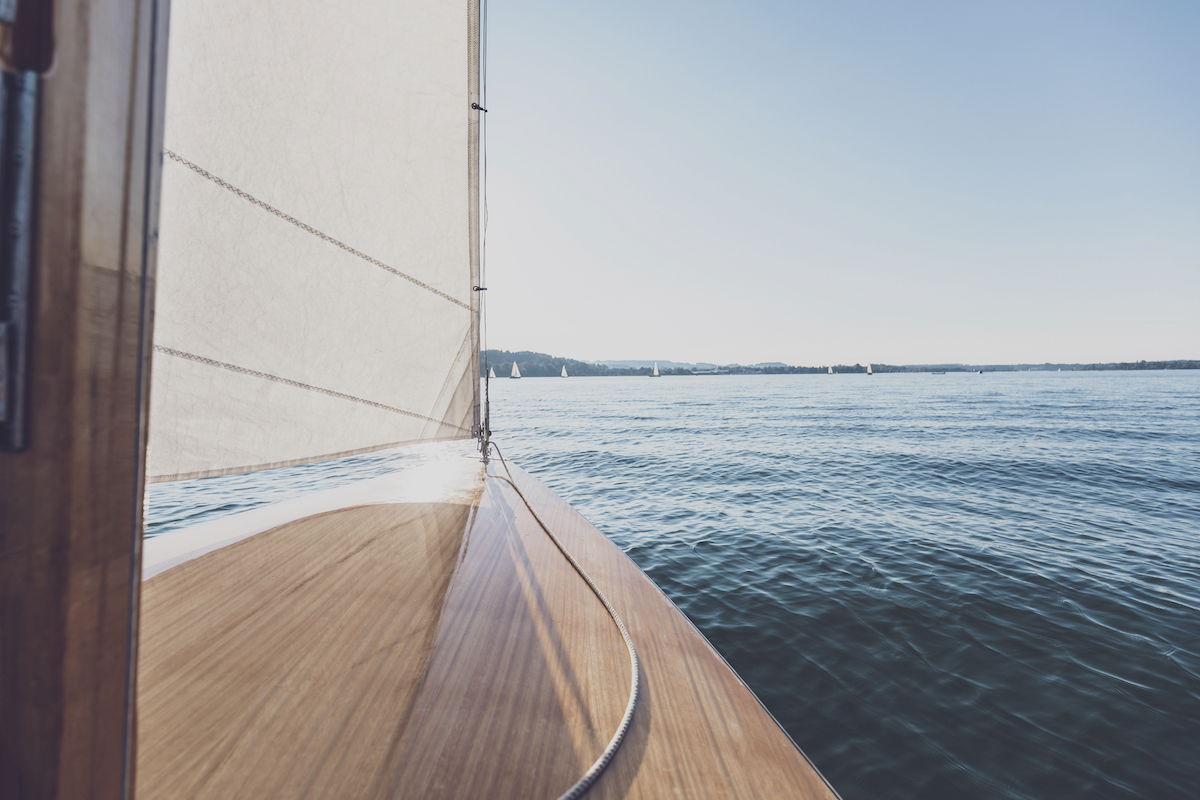
Unanchored Dreams: The Freedom and Challenges of Living at Sea
By Annierose Donnelly
The ocean covers over 70% of the planet, so as humans, it’s only natural that we would want to explore it. But how do you take your everyday life to the high seas? I interviewed two seafaring friends of mine, both of whom have different experiences living on boats, to gain some insight into what it’s like.
George Sloane-Stanley has spent much of his life sailing around the world, exploring everything from the islands of the Caribbean to the wilderness of the rugged Scottish coastline. He has skippered day tours and spent months living at sea on various sailboats. George is now retired and enjoying his land life in southwest Scotland. He shares some of his memories from living at sea and his secrets to making this unique way of life work.
Nathan Hutton has spent the last two years living on a houseboat, docked in London’s Limehouse Marina on the River Thames. The price of rent in London combined with a desire for a unique adventure led Nathan to become curious about an alternative way of life. He spends his summers living on sailboats and is planning to cruise across the English Channel in his 44-foot Nelson boat.
Are you feeling ready to leave your shoreside self behind?
The Freedom of Sailing the High Seas
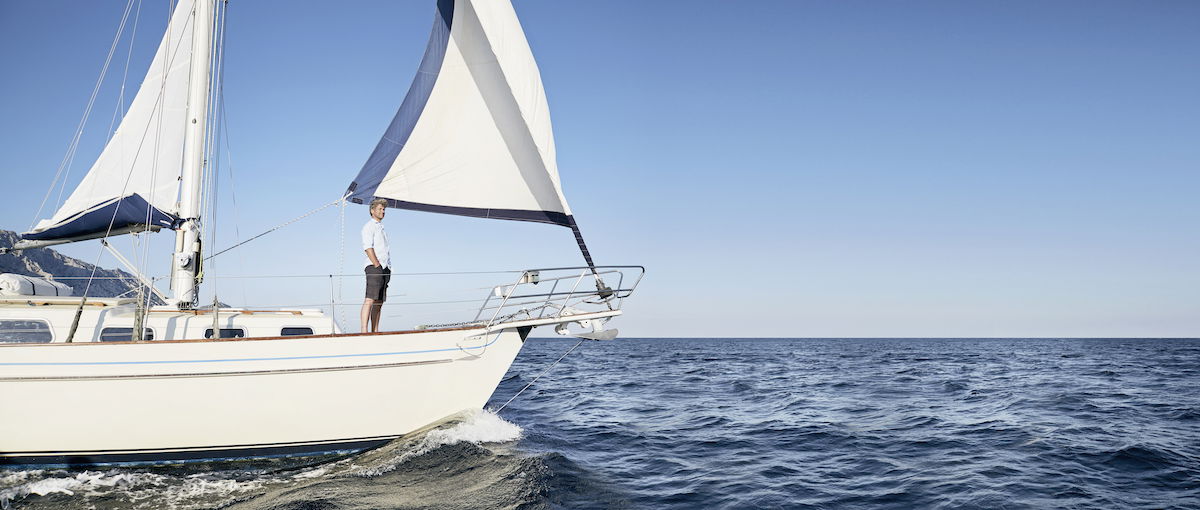
A life at sea gives you the freedom to go wherever the wind takes you. It’s a chance to get closer to extraordinary parts of the world.
You can reach many secluded and inaccessible points by boat. This makes other outdoor pursuits even more adventurous, as you can explore untouched places that are difficult to reach on foot.
It’s also possible to venture inland through canal systems. The Intracoastal Waterway on the east coast of the United States, stretching from New York to Miami, is a wonder to discover by sailboat. From charming port towns famed for their local cuisine to coastal landscapes and vibrant fall foliage, sailors rave about this route.
“There’s a limitless supply of adventures available,” George says.
Indeed, the number of places you can visit whilst sailing will far exceed what can be achieved on any regular vacation. How many wild and rugged uninhabited islands off the west coast of Scotland can you explore in one trip? You could find out in your sailboat. How many deserted, tropical island paradises can you discover in Greece, the Caribbean, or Indonesia? You can find this out too.
As you sail along, there will be chances to watch stunning sunsets and spot incredible marine life, such as dolphins, whales, and seabirds. Catching some rays on the sun deck with a cocktail in hand is always an option, too. Perhaps you’ll use your freedom to try painting or catching up on lots of reading? Nobody is pushing your calendar, so you can enjoy the freedom and flexibility of staying in a destination for as long as you please.
Living on a boat can bring a sense of impermanence, with nowhere and everywhere being home simultaneously—and not every day is a sunny holiday. It offers a nomadic existence, and, particularly if you’re a solo sailor, it can be a challenging experience. For instance, how do you stay cheerful when it’s rained for a fortnight and you’ve got no dry clothes left? If something does go wrong at sea, you’ll need to keep your wits about you and lean on your own ingenuity.
Here are some tips from our seasoned sailors about how you might make this life work for you.
Getting Started

Choosing the right boat to live on for a long period of time is a decision worth taking some time with. You will need to consider your budget, skill level, and logistics before making the choice. As with any big purchase, it’s important to do your research, and don’t forget extra expenses such as boat registration and maintenance costs. Many sailors find their boats online, but most would still suggest seeing the boat in person and checking it over thoroughly before making a purchase.
During the height of the coronavirus pandemic, my friend Nathan decided to rent out his house in Cambridge and purchase a live-aboard boat with his brother. “You should always get a survey done if you are going to buy a boat,” he advised. “Someone in our marina didn’t, and their boat started to sink to the bottom one day in about 10 minutes flat!”
Are you new to sailing? Another piece of advice from the sailing community is to join a sailing club and take a course to learn the basics. Get started with courses on small dinghy boats, such as Lasers. These boats can teach you the fundamentals of sailing and build your sailing experience in a safe environment.
Choosing Your Anchorage

Even the most nomadic of sailors will need to stop now and then at a marina. It might cost some money, but when you need a break from sailing, it will give you access to important amenities, such as running water, electricity, and internet. There might also be showers, washing machines, and a mailroom, all of which can help with the transition between living on land and at sea.
It is also essential to plan what to do with some of your land responsibilities—your housing situation, cars, taxes, bills, etc. Keeping on top of such matters can be tricky at sea, especially since the normally simple task of keeping your phone charged is not even guaranteed.
No Room for the Sculpture Collection

The space itself (or lack thereof) is another important factor to consider when planning your new life at sea. Are you ready to give up on a few luxuries and squeeze into a small space with your nearest and dearest?
George has lived on sailboats of varying shapes and sizes throughout his life. “Boat designers are masters of maximizing space, but there’s not going to be room for a rack of clothes or your sculpture collection. Anything you take with you has got to fit on the boat,” he says.
Nathan agrees. “Living on a boat means you can’t get some of the things you might want in your life, for example, an exercise bike, a big fridge, or air conditioning,” he says.
Living in close quarters can challenge relationships, so if you’re planning to set sail with a partner or family member, be sure that you are both on the same page about the confinements of the space and set some ground rules to avoid tripping over each other.
The kitchen, living room, and bedroom are likely to be one shared space. As for cooking meals, it’s back to basics while you’re on board. It’s likely you’ll have limited kitchen space, so quick dinners with little washing up will be your best bet while at sea.
Get Good at ‘Making Do’
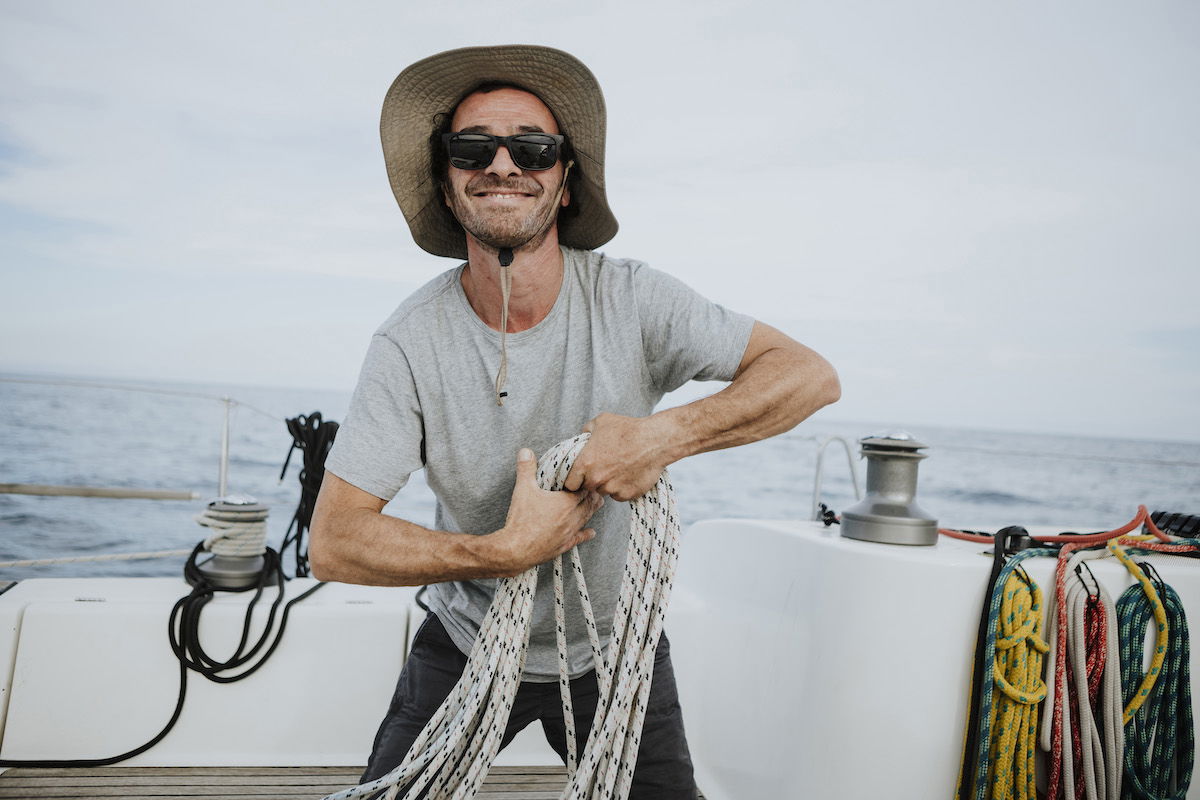
In terms of logistics, living on a boat can make life beautifully simple. If you are willing to minimize your material possessions and maintain a compact space, of course.
When the place where you sleep floats on water, there will always be maintenance work. Learning how to fix problems as they arise is an important part of boating life. No matter what kind of boat you choose to live on, almost every problem needs urgent attention. Leaving an issue for later can have serious consequences. “If you wake up with water dripping on your face, you know something needs to be fixed ASAP,” says Nathan.
It’s always cheaper to fix things yourself while you’re living on a boat, and it avoids the hassle and expense of hiring an engineer every time something breaks. With some experience and practice, eventually “you will get good at making do and you’ll develop your own way of doing things,” says George.
One more note to remember: your life aboard a sailboat will not include main drainage or plumbing, so you’ll need to figure out how to manage your waste.
Supporting Yourself at Sea

Unless you are chartering a yacht like the guests on Below Deck Sailing Yacht , you will need a way to make money while you’re living at sea.
“Are you of independent means, retired, or a freelancer?” George asks. “Whatever way you make money, you will need it for food, clothing, moorings, medical expenses, chandlery, and boat repairs.”
However, living on a boat can also be a money- saving decision, and the cost of living on a boat can be far cheaper than renting a property, especially in an expensive city.
Nathan’s vessel is docked in a marina, which is one of the most expensive ways to live on a boat, since it includes running water and power. Even so, it only costs one-eighth of the price of monthly rent in that area of London. The cost of buying a boat versus a house in Central London is not even comparable (in favor of the boat).
Sailors’ Top Tips for Living at Sea

I asked the sailors for their top tips for a life at sea. Keep the following in mind as you take to the seas, and happy sailing.
- Make the most of your free time. Discover new hobbies, enjoy your surroundings, and don’t forget to live in the moment.
- Meet people. The fact that you live on a boat is a great ice-breaker at parties. Globe-trotting yachties love to talk for hours, and there is a close-knit sailing community you can tap into for advice about all things boat-related.
- Live like a local and experience new cultures wherever you sail to.
- Ginger nut biscuits are a great cure for seasickness.
SIGN UP FOR THE FREE OUTDOORS.COM NEWSLETTER
12 Best Sailing Destinations in the World
15 Tips For Sailors Buying A Boat

Photog Leaves Camera Rolling and Captures Puffins ‘Comin’ in Hot’

Viral Video Shows Hikers Fleeing Volcanic Eruption in Indonesia
Leave a comment cancel reply.
Your email address will not be published. Required fields are marked *
Save my name, email, and website in this browser for the next time I comment.
Register for newsletter (optional)
More Like This

The Dos and Don’ts of Van Life and Car Camping in the Winter

Unbelievable Boating Accident During College Fishing Tournament!

Plan Your 2024 Vacations with These 10 Best Sunset Destinations

Why Are Forest Fires Important for Some Ecosystems?

Shark Bite was this Surfer’s Second of the Year!

Watch: Dog Takes on 12-Foot Hammerhead Shark

Indiana’s Best Destinations for Paddle Sports

Weird Walks: How To Turn Your Morning Stroll Into a Unique Adventure
More stories.
A couple left their home to move onto a residential cruise ship — see inside their cabin on Villa Vie Odyssey
- Angela and Stephen Theriac purchased a cabin on the residential cruise ship Villa Vie Odyssey .
- The ship plans to sail around the world every 3 ½ years. Its launch has been delayed by three months.
- The cheapest dual-occupancy cabin starts at about $100,000, with an additional $3,500 monthly fee.

Angela Theriac hit a turning point in 2018.
In a span of six months, her mom and oldest brothers died, her husband faced a health scare, and she underwent two surgeries.
She said her perspective shifted: She decided to stop taking life for granted, grinding every day at work, and wondering if she'd ever have time to see the world.
"You know what?" Theriac, 53, a retired schoolteacher, recalled saying at the time to her husband. "Let's go for this big adventure and live life to the fullest."
That mission drove Theriac and her husband of almost 30 years, Stephen Theriac, 53, to purchase a cabin in March on a residential cruise ship called the Villa Vie Odyssey . They bought the cabin just one week after learning about it in a YouTube video.
"Sometimes, you just got to be adventurous and do it," Stephen, a retired deputy sheriff, told Business Insider.
Mikael Petterson, the founder and CEO of Villa Vie Residences, told BI in an email on Monday that Villa Vie Odyssey would embark "any day now." The 509-cabin residential cruise ship plans to circumnavigate the world every 3 ½ years, sailing to 147 countries and 425 destinations along the way.
Petterson declined to provide a specific sail date, saying the ship is still waiting for "the green light from DNV . It's impossible to say which day exactly." DNV is a certification and risk-assessment firm for the maritime industry.
Villa Vie Odyssey promises amenities, including three restaurants, five bars and lounges, a pool, and a golf simulator.
The ship's comprehensive itinerary is a dream for retirees like Angela and Stephen, who say cruising is a "big passion." Destinations include Australia; South America; Walvis Bay, Namibia; and Singapore.
Related stories
Before moving to Nicaragua in 2011, the couple spent most of their lives in Florida and frequently took advantage of their proximity to some of the busiest cruise ports in the US .
They estimate they've boarded 50 cruises over the past 25 years, with the longest lasting 39 days.
"I really enjoy seeing new places, learning of new cultures, trying different food, and drinking different microbrews," Stephen said. "It's a great lifestyle."
The couple told BI they paid for the smallest, least-expensive cabin on the never-ending cruise , partly funded by an inheritance from Angela's mother.
(The couple said they signed a nondisclosure agreement and could not tell BI how much they paid for their accommodation. However, the cheapest dual-occupancy interior cabins start at about $100,000 with an additional $3,500 monthly fee.)
The Theriacs said they've already been to popular cruise destinations like the Caribbean and Mediterranean. They're excited to go further — New Zealand for Stephen and tropical destinations like Bali, Indonesia, and Fiji for Angela, a self-proclaimed "water girl."
They said they have plans to rent their home in Nicaragua to a close friend.
The Odyssey cabin features twin beds and a vanity
The couple started decorating their floating condo with pillows, artwork, and "personal touches emphasizing storage," Angela said. "Our room is our bedroom, and the ship is our home."
But there's a caveat — while they can spend their days aboard the ship, they're not yet allowed to stay overnight.
The never-ending cruise was initially scheduled to set sail in May from Belfast, Ireland, following Villa Vie's acquisition of Fred Olsen Cruise Lines' more than 30-year-old Braemar vessel, now renamed Villa Vie Odyssey. However, Villa Vie has said issues like the aging ship's rudder stocks and recertification have since delayed its departure by three months.
Like many other would-be Villa Vie residents, the Theriacs flew to Belfast for the initial springtime departure date. Since then, the couple said they've been staying at hotels — including some a flight away in Liverpool, UK, where they say the nightly cost is cheaper — and spending time on other cruises.
Petterson said the Florida-based Villa Vie also provided residents with shuttles to and from the ship, food, drinks, excursions, and lodging — or a daily per diem for those who "choose to do their own thing."
But the couple has been patient and understanding of the delays — because, according to Stephen, "it's a now-or-never kind of thing."
"We're still in pretty good health and financially fine," Stephen said, reflecting on the sight of "80-year-olds getting off Princess ships in walkers." "I don't want to be that old and try to see the world. I want to do it now while I can still enjoy it."
Villa Vie would be the first ship of its kind in 22 years
Villa Vie isn't the only startup that has faced difficulties while trying to launch a never-ending voyage.
The residential-cruise industry has been plagued by issues since the inauguration of The World, the only ship of this kind, in 2002.
Startups trying to launch floating condominiums have since popped up as quickly as they've sunk — from Miray Cruises' Life at Sea Cruises , which shut down two weeks before it was supposed to embark in November, to Storylines , which has delayed its departure by seven years to 2026.
Miray's former CEO, Kendra Holmes, recently launched GlobeCruises, a concept similar to Life at Sea's three-year cruise , scheduled to sail in April.
GlobeCruises and Villa Vie are the only options vying to join The World in its extended voyage around the globe.
Are you sailing on a residential cruise ship like Villa Vie or have a tip? Contact the reporter at [email protected] or on X @brittanymchang .
Watch: Cruise ship captain breaks down 8 cruise ship disasters in movies and TV
- Main content
University of South Florida
Main Navigation
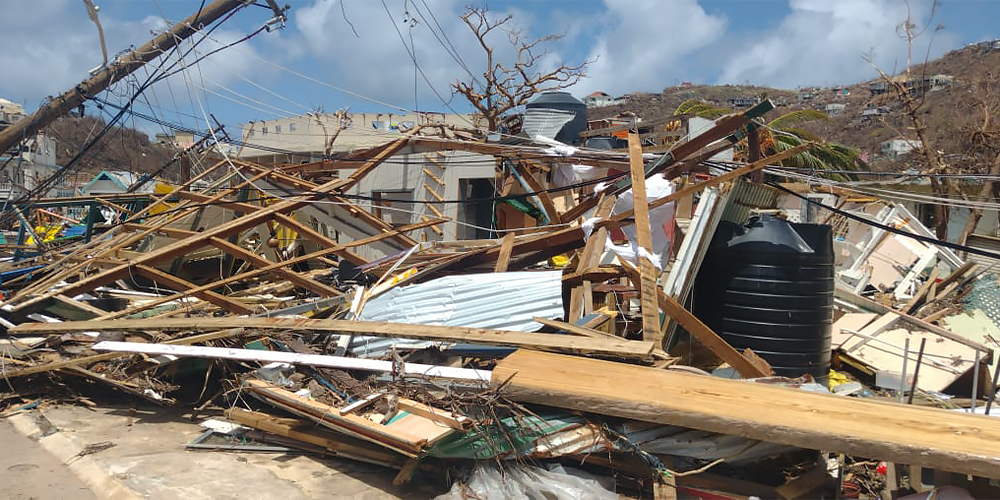
Photo by Katrina Coy
Living classroom for USF students devastated by Hurricane Beryl
- Vickie Chachere
- July 12, 2024
Faculty & Staff , Global Networks , Students
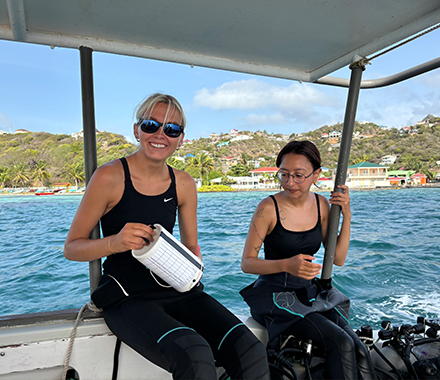
Photo Courtesy of Chantale Bégin
Just a few weeks ago, Union Island — just three miles from end to end with a population of less than 3,000 people — had been an idyllic study abroad locale for 16 USF students in a tropical marine ecology course. For two weeks in June, the students had conducted underwater research mapping fragile coral reefs in the Caribbean waters off its shores, learning from local conservationists and living in a small town where they soaked up invaluable lessons from residents.
Chantale Bégin, a Professor of Instruction in USF’s Department of Integrative Biology, has led summer study abroad classes to the small island multiple times as part of the program. Before departing for each trip, the students train as scientific divers so they can complete their research safely and effectively, contributing valuable data to global efforts to track the health of coral reefs.
They returned to Tampa just two weeks before Hurricane Beryl slammed into the island as a Category 4 storm, leaving complete devastation and the local partners to the USF program struggling to survive in destroyed houses with no roofs, water, or electricity, and a lack of communication infrastructure. Bégin and her students have since been circulating information on how to help the local community that, just weeks ago, had given USF students the experience of a lifetime.
Dr. Bégin's study abroad group is working through international non-profit Fauna & Flora to aid the Union Island Environmental Alliance , a local conservation organization that is the partner for the USF study abroad program on the island. "Katrina Coy, who heads the organization and has been working to preserve the fragile island’s environment, remains on the island living in the remnants of a destroyed house," Bégin said.
“Union Island is in a terrible state after Beryl passed. Literally, almost the whole island is homeless.”
“Union Island is in a terrible state after Beryl passed. Literally, almost the whole island is homeless,” Coy said in a video message that was delivered to the BBC recently via Starlink satellites. The students spent their time on Union Island mapping and photographing coral reefs to create sophisticated 3D models that would allow the tracking of the reef’s health over time. However, it won’t be clear for some time exactly how much live coral is left — or the markers the students placed so another class could return in a couple of years to take updated photographs — after the storm, Bégin said. But what is certain is that in their experience abroad, USF students captured the last days of an island that will be changed forever.
A Life-Changing Journey
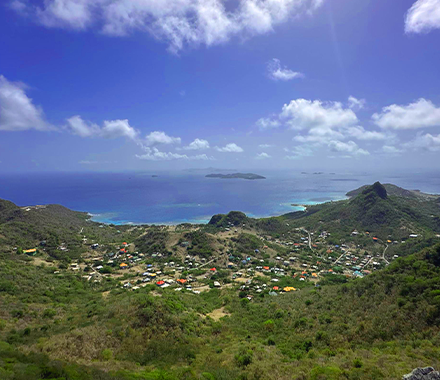
It’s a 12-hour journey from Tampa, via Miami, to Union Island. The USF students left on June 3, enduring two flights and a four-hour ferry ride in rough seas to get to a tiny island between Saint Vincent and Grenada. Their preparation for the study abroad experience began long before the journey with training for the dive certifications and online coursework so they would recognize the native coral and fish around the island.
Once the students arrived, they were welcomed to a small village with a hotel, a dive shop, local eateries, and a few small businesses. The students worked in an open-air classroom on their computers after their dives and quickly made friends with the local wildlife — a stray cat and the friendly dogs who followed them around the island and napped in the classroom.
“A lot of my students have never left the U.S. and they travel to the Caribbean — not to go to some resort but rather to the real Caribbean, staying in a small hotel and interacting with the community,” Bégin said.
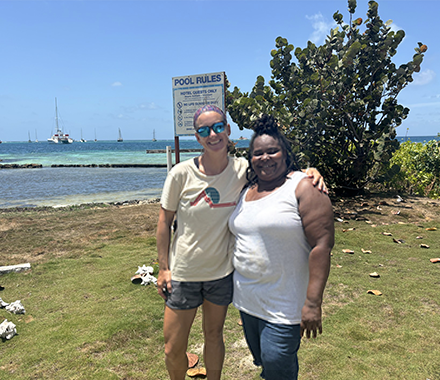
Chantale Begin and Katrina Coy Photo Courtesy of Chantale Bégin
Bégin said most of her previous study abroad programs in the Caribbean were at research centers, but Union Island is a unique experience because the students can interact with local residents. In their off hours, the students bike and hike around the island, visit local shops, and eat in restaurants with long tables intermingling with locals. Their photos catch images of a tranquil turquoise bay dotted by sailboats and ringed by colorful houses and of wild geckos, sea turtles, giant hermit crabs, tortoises, and cattle which roam the hillsides.
“We biked up the steep foothill to Mt. Olympus and saw yet another incredible view of Chatham Bay! Seeing all of the beautiful sailboats was a treat, and a reminder of my dream to one day live on one of them in a serene bay just like this one,” wrote Sydney Tritschler, a senior majoring in marine biology, in one assignment for the class. “We chatted up here for a bit about our plans for the future, and how our time here has encouraged us to believe in the big dreams we had.”
Now, Tritschler is among the USF students who have been sharing pictures and information to raise support for Union Island. “It’s absolutely insane seeing the hotel where we stayed at not even having a roof on it. The pavilion where we took our classes is completely gone,” she said.
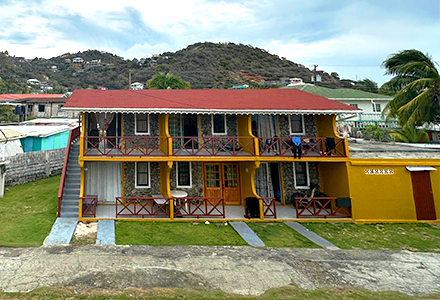
Kings Landing - Before Photo Courtesy of Chantale Bégin
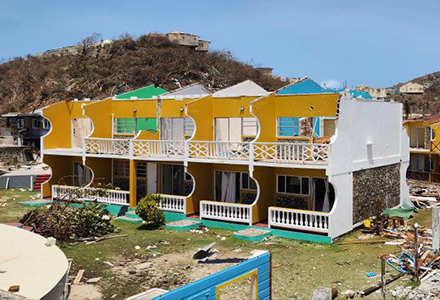
Kings Landing - After Photo by Katrina Coy
An Environment in Distress
Union Island was already having a difficult year due to its nature as a volcanic island with no natural freshwater resources. The Union Island Environmental Alliance has worked to advance rainwater storage practices, but, “This year is experiencing a particularly bad drought,” Bégin said. “Their only source of water is rainwater." UIEA had been working to increase rainwater collection and storage, but there just is not enough fresh water on the island. Water was being carried by ferry from St. Vincent before the hurricane. “While we were on the island there was a town hall meeting to discuss options to the water crisis, including the possibility of building a water desalination plant in the future,” she said.
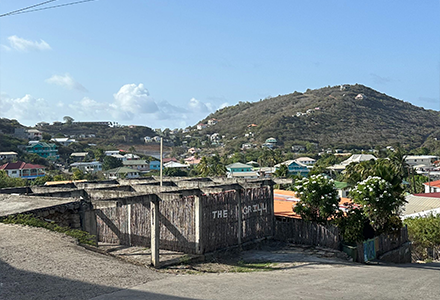
Union Island - Before Photo Courtesy of Chantale Bégin
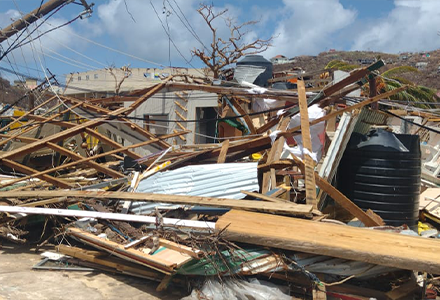
Union Island - After Photo by Katrina Coy
Coy — who in May had delivered a presentation at the United Nations headquarters in New York, a first for the small island community — spent part of one day’s session talking to the students about the difficulties in running a community-based environmental organization, finding financial support, and keeping the organization running smoothly on few resources. The USF students spent another day at a local elementary school teaching children about marine ecosystems and conservation. “So many lasting connections were made between children grades 2-5, including 'pinky promises' to remain BFF's forever,” one student wrote in an assignment for the class. “The sheer amount of excitement from the kids made for an incredible experience.”
Twice a day, the students conducted dives as part of a photogrammetry project, meticulously plotting out sections of the reef and placing scale markers before taking thousands of photos to be fed into software that turned the images into a high-resolution, 3D model of the reef. These models also provide insight into the abundance of fish, urchins, baby coral, algae, and other organisms that are indicators of reef health.
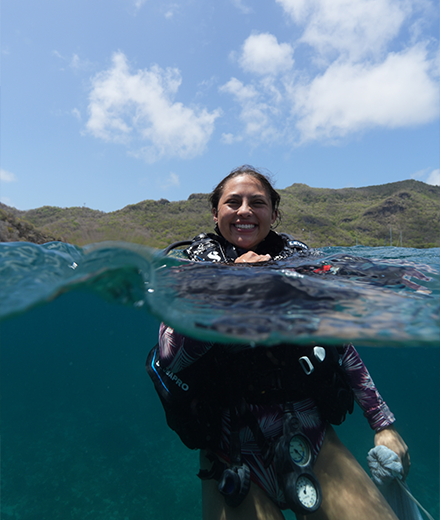
USF World Global Network student coordinator and integrative biology major, Tatiana Restrepo
The students also collected data on the abundance of coral, algae, fish, and invertebrates using standards of the Global Coral Reef Monitoring Network — which means their data not only could help inform local government and non-profits on reef conservation but also would be helpful to scientists around the world monitoring threats to reef health. Reefs everywhere, including the ones off Union Island, are at risk due to coral bleaching in excessively warm waters and climate change.
“The most urgent thing is that the humans on Union are safe, but soon I hope that we may be able to return, look at our plots, and assess the impact of the hurricane on the reef,” Bégin said. “Hurricanes do damage to coral reefs through wave action, especially in shallow water. There’s excess freshwater and runoff from the massive storms; there’s sediment from the runoff. There might be a lot of coral mortality, but you can’t assess that until you get back in the water,” she added.
Tatiana Restrepo, an international student at USF from Colombia and USF World student employee majoring in marine biology and environmental science at USF, described her time on Union Island as a transformative one that left her excited to pursue a career in marine biology. “After finishing scuba diving for the day, I found myself wanting to go to sleep because I couldn’t wait to start again the next day,” the rising senior said.
After leaving Union Island, Restrepo kept in touch with some of the people she met, including girls at the elementary school who wanted to stay connected to her via WhatsApp. “We became a part of the community,” Restrepo said. “We developed really good connections and relationships with the people there.” After the hurricane hit, she was thankfully able to check on her new friends, who sent pictures of the destruction. “They said they are OK, but they don’t have food or shelter and were leaving for other islands,” Restrepo said. “It’s truly heartbreaking.”
Katrina Sandefer contributed to this report. For more information on how to help Union Island, visit Fauna & Flora .
USF students prepare on a dock to scuba dive. A boat is beside them
USF students under the sea in scuba diving gear and holding the USF banner
A student in scuba diving gear picking up trash on the bottom of ocean of union island
Return to article listing
Caribbean , Study Abroad
- Faculty & Staff
- Global Networks
About USF World News
USF World is the university's gateway to global engagement. Whether it be sharing the achievements of our students and faculty on campus, our partnerships within the community, or what our alumni accomplish globally, we bring you the stories of USF Bulls around the world.

COMMENTS
Living in the Caribbean isn't quite as cheap as most people expect it to be. It isn't going to be crazy expensive, at least it doesn't have to be. You can get a pretty nice marina slip in the Caribbean for about $1000 a month. This is going to get you some security, some decent amenities, and a nice location.
Many readers have asked me about liveaboard boating in Belize. There is not an actual active, lively marina like you might see in Key West or other places in the Caribbean. We are technically living aboard at Robert's Grove, with shore power, the ability to fill up water tanks easily, and we have everything we need, so we are experiencing ...
Marina or Mooring Costs. The cost of living on a sailboat in the Caribbean can be quite expensive, especially when it comes to Marina or Mooring fees. In some cases, these fees can be as high as $600 per month! However, there are a few ways to help offset these costs.
It costs between 200 dollars to 3000 dollars a month to live on a boat in the Caribbean. The cost of living will vary depending on your lifestyle, how often you go sailing, and where you moore your vessel, among other factors. This article breaks down the costs of living on a boat in the Caribbean, potential differences in expenses per region ...
Living on a sailboat in the Caribbean will cost you about $2,500 per month if you exclude the cost of buying a boat, which is around $25,000. You might have to get a marina slip for around $800 a month. Other expenses include taxes, food items, and water and gas bills. Living on a boat is pretty much like living in a flat.
Average Cost. Both Captain Lisa and Captain Gino are of the opinion that the cost of living on a boat really depends on your lifestyle. So the average cost of living on a boat in the Caribbean ...
While living in Asia, a sailing buddy and I set off across the South China Sea destined for Thailand, only to be slammed by a late-season typhoon that forced us to make landfall in Vietnam, shaken ...
Some people dream of completing a circumnavigation, while others stick to seasonal cruising. Whatever your goal, sailboats might not be the fastest way to travel, but they are certainly the most romantic. 4. Small Space Simple Living. On the one hand, boats and RVs are the mobile equivalents of the tiny house.
Conclusion: Living aboard a sailboat in the Caribbean can be an affordable and fulfilling lifestyle, but it is important to carefully consider the costs and potential hardships before making the leap. With proper planning and preparation, however, the rewards of this lifestyle can be endless.
Start Out By Land. Plan your first 6 months near land and take short trips until you get used to the boat. Spending time near land when you first move aboard gives you the opportunity to learn your boat and learn about living on your boat. Take note of how much food you go through in a week.
Lisa Chapin of SailTime San Fransisco here at captaingino.com lives on her boat all the time. After spending two years in the Caribbean she spent another year cruising from these beautiful islands to the Galapagos. According to Lisa, ""You can easily live on a boat for less than $1000, and you could easily live on a boat for $4000.".
You can get it cheaper but there are no recommended surveyors in Sicily so we made the decision to fly one in from the UK. That way there weren't any language barriers either. We were slightly unlucky that the marina the sailboat was in was such an expensive one to get a lift out, you can get lifted out for more like £200-£300 ($250 - $380 USD) in other boatyards.
You may have heard many good things about living on a boat- the freedom, the laid back lifestyle and being part of a vibrant community. ... Our goal was to sail the Caribbean, but we didn't want to miss out on anything on the way down. To get there, we sailed to the Bahamas, Turks and Caicos, Dominican Republic, Puerto Rico, Virgin Islands ...
Insurance ($233) If you are a newbie cruiser, your boat insurance options will most likely be limited. Insurance was a considerable expense in our first year. In our second year, the cost dropped from 2.8% of the boat's value to 1.3%. (We now have restricted cruising grounds for July - November.)
Some might think that living on a sailboat in the caribbean is always fancy and glamorous. The reality is that although great, living minimally on a sailboat...
Acquiring A Boat. You can expect to pay at least $10,000 to $15,000 at the bare minimum for a live-aboard sailboat that is seaworthy enough to navigate the Caribbean. For a more luxury cruiser, expected pay well into the hundreds of thousands of dollars. This will be one of the biggest expenses of your Caribbean cruise.
On Isla Mujeres, a couple can live a very nice life for around $2,500 per month, including rent, according to International Living magazine.³. And rents range from $900 to $1,500 for a one- or ...
Nouvelle Chaine en Français : @danietmarvhttps://www.youtube.com/channel/UChdsCViFctCvZiWUxhygMeA #sailing #sailboat #bahamas #sailingfamily #digitalnomad
Just outside the hurricane belt sits the beautiful island of Grenada. We spent the entire hurricane season here and compiled a list of EVERYTHING we spent. I...
Things like water conservation, provisioning, cooking, cleaning, and adjusting to a small space all take time and energy. Here are some of the big changes to everyday habits that we discovered living on a catamaran. Table of Contents. Preparing for Sailboat Living. 1.
Living onboard a boat in the Caribbean was something I really enjoyed; there was a type of simplicity to life. Make no mistake living on a boat is very different from living on the grid and takes a lot of hard work. But the upsides are big, fewer distractions from the intense life on the grid and quality time with the people on your craft!
In fact, they wound up spending eight full years sailing the Caribbean on their own boat, without any major problems, and spent only $1,000 a month to do it - all in first-class style. In the May 2011 issue of International Living Magazine, Gary reveals what it's like to cruise the Caribbean full-time. And he provides practical tips for ...
George Sloane-Stanley has spent much of his life sailing around the world, exploring everything from the islands of the Caribbean to the wilderness of the rugged Scottish coastline. He has skippered day tours and spent months living at sea on various sailboats. ... Living on a boat can bring a sense of impermanence, with nowhere and everywhere ...
My first cruise took place on Wonder of the Seas, sailing a 7-night Eastern Caribbean and Perfect Day at CocoCay itinerary. Any Oasis-class ship would make for the perfect first cruise. I was blown away by the amount of dining, activities, and amenities onboard, and felt like I barely had enough time to experience it all. ...
Angela and Stephen Theriac purchased a cabin on the residential cruise ship Villa Vie Odyssey. The ship plans to sail around the world every 3 ½ years. Its launch has been delayed by three months ...
In the video, I talk about the 3 steps from going from a complete beginner to sailing the Caribbean on your own, in your own boat.
Bégin said most of her previous study abroad programs in the Caribbean were at research centers, but Union Island is a unique experience because the students can interact with local residents. In their off hours, the students bike and hike around the island, visit local shops, and eat in restaurants with long tables intermingling with locals.
NEWS Source Evening Bulletin for 22nd August 2024